You’re thinking about travelling to Singapore and Malaysia and not sure where to start or what to do? Well fear not, we’ve put together the perfect tried and tested 2 week travel guide to these two magnificent countries, with everything you need to know on what to do, where to stay, best travel routes and so much more! Yup, after travelling the breadth of both countries, we’ve curated what we believe is the perfect Singapore Malaysia itinerary.
Now we’ve created this as a 2 week guide but you can swap out sections and even remove stops to make this a 10 day Singapore Malaysia itinerary. Looking to stay a little longer? We’ve got some cracking bonus activities in most cities or a list of other gems to consider as part of your Singapore Malaysia trip. And, in case you’re still not satisfied, feel free to pick our brains on your own itinerary – just drop us a comment below or get in touch with us here.
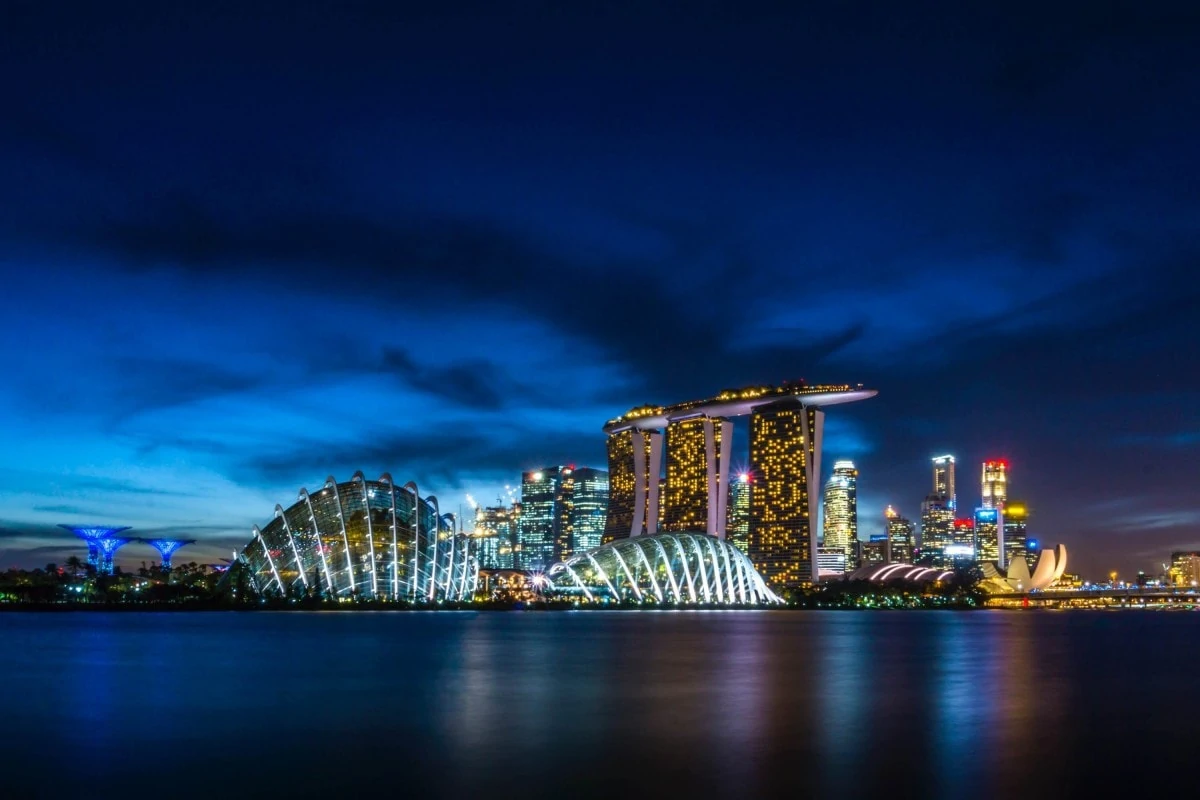
Skip ahead
Our perfect Singapore Malaysia itinerary
- Day 1 & 2 – Singapore
- Day 3 – Singapore to Melaka (Malacca)
- Day 4 – Melaka
- Day 5 – Melaka to Port Dickson
- Day 6 – Port Dickson to Kuala Lumpur
- Day 7 & 8 – Kuala Lumpur
- Day 9 – Kuala Lumpur to Ipoh
- Day 10 – Ipoh
- Day 11 – Ipoh to Penang
- Day 12 – Penang
- Day 13 – Penang to Langkawi
- Day 14 – Langkawi
Why go to Singapore & Malaysia?
Singapore
- Changi Airport is one of the best connected airports in the world (and potentially the most beautiful), so not only is it a great way into the Southeast Asia region, it’s also an Instagrammer’s dream, with plenty of beautiful photo spots to explore as soon as you get off the plane!
- A major trading port, over the years from colonial rule to the local flavour, the cuisine has developed to some of the best in the world. Your stomach will thank you for going to Singapore!
- For a small island there are fantastic diverse areas to explore from the vibrant Chinatown to the bustling Little India. Really so much to see across many cultures.
- There are awesome free things to do, so although it’s definitely not the cheapest part of Southeast Asia, you’ll be surprised by what you can do without spending a dime.
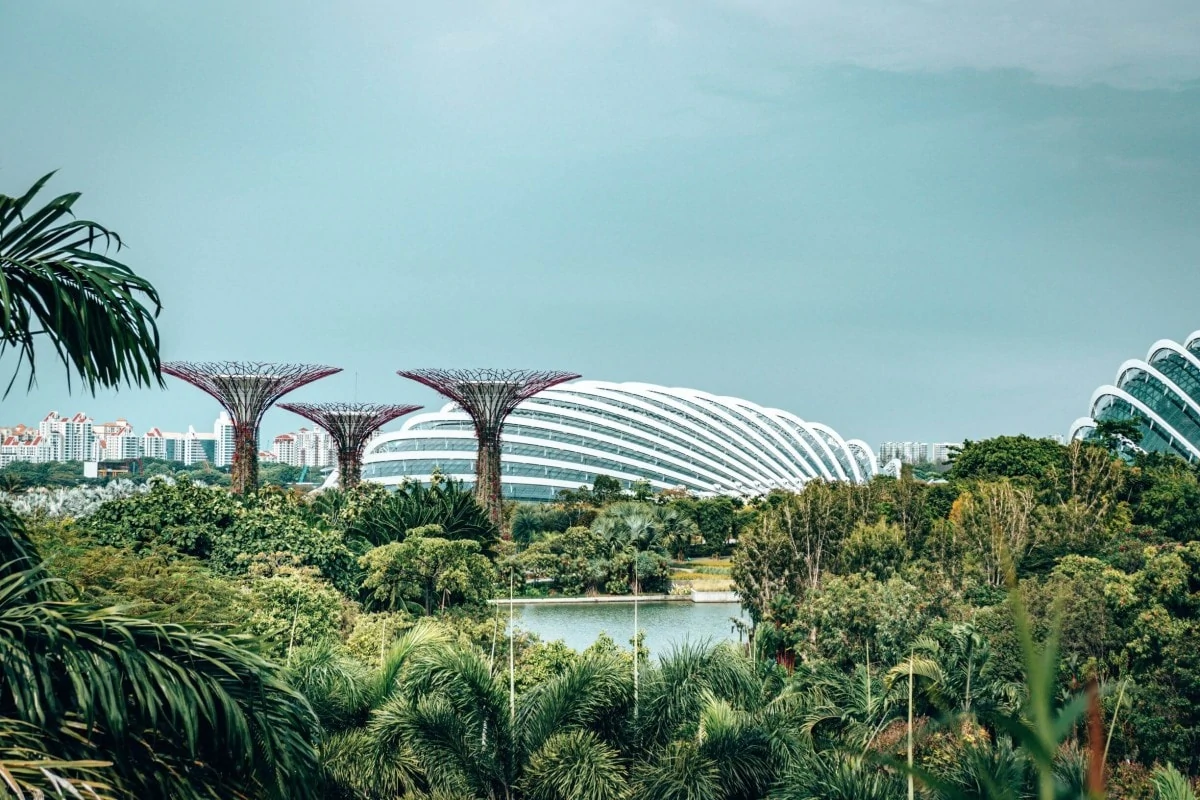
Malaysia
We don’t know where to start in convincing you to go to Malaysia – it’s one of our favourite countries in Asia and we have visited so many times, each visit bringing us something entirely new and unexpected. But, in case you need more motivation, here are some reasons why you might love it:
- Malaysia has some of the friendliest people. Yes, people across Asia are friendly but we find Malaysians to be so authentic, kind and helpful – there have been many times when locals have taken us around free of charge, helped us choose our lunch and given us advice.
- From nasi kandar to the sweet treats of kuih, Malaysia is a melting pot when it comes to cuisine, so much so that Singaporeans (known as some of the world’s biggest foodies), travel to places like Ipoh just to eat! Whether you have a sweet tooth or have more savoury tastes, the food of this country is worth a trip alone.
- It’s cheap as durian chips. Honestly, Malaysia is such an affordable country, particularly when it comes to accommodation and food. This wallet-friendly country is modern yet inexpensive, a winning combination.
- Malaysia has so much variety to offer. From pristine beaches in Langkawi or the Perhentian islands, to hiking in the forests or the tea plantations of the Cameron Highlands or even city dwellers delighting in Kuala Lumpur, the country offers something for everyone.
- Culture buffs will also feel right at home. Whether it’s museums, historical monuments or just delving into street art, galleries or just traipsing the streets to find local customs, you’ll find a rich tapestry of culture in the country.
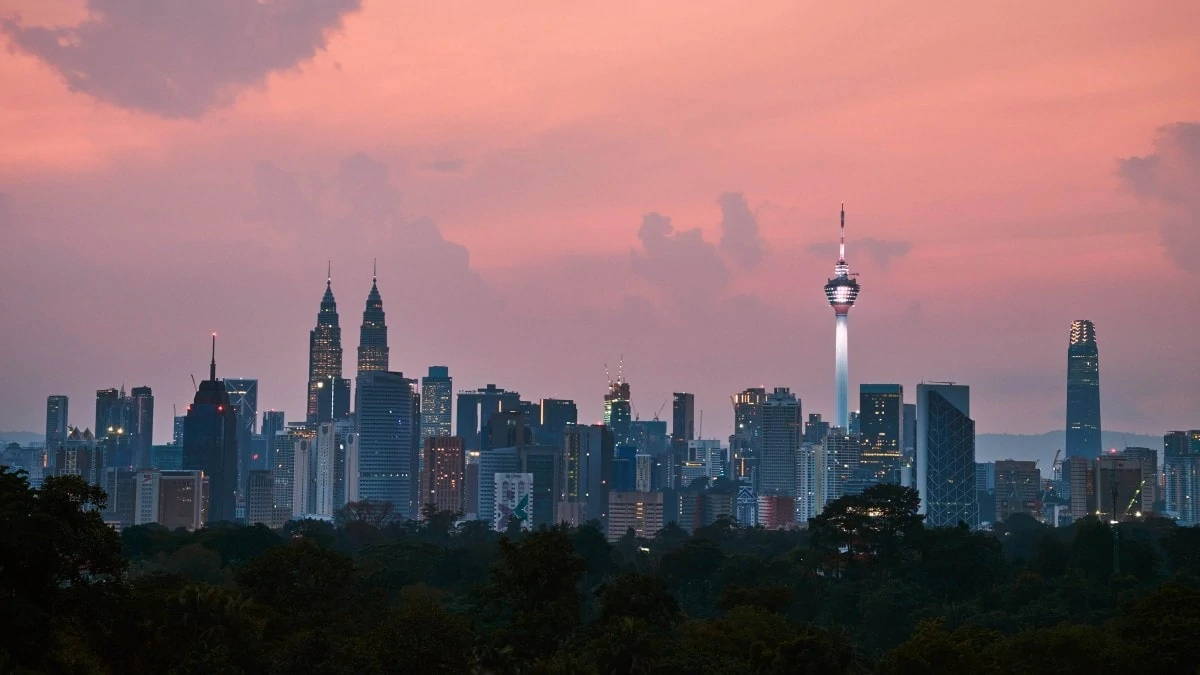
Best transport options for your Singapore Malaysia trip itinerary
Buses and Boats:
We’ve used most of the main Asia boat and bus service providers, and we’d personally recommend Bookaway. They provide 24 hour assistance and many routes have great cancellation policies, which is a bit of peace of mind when travelling. You never know when your plans will change…
Arriving into Singapore and other flights:
Make sure you check out the latest flight deals on Skyscanner!
Air Asia is probably the best low cost airline in the region, which we have flown countless times – they’re like the Easyjet or Southwest of Asia, but often make it onto the best budget airlines in the world list. You get what you expect: no fuss, extra baggage/seat/meal costs, but they’re definitely a great option if you want to explore further parts of Malaysia and beyond.
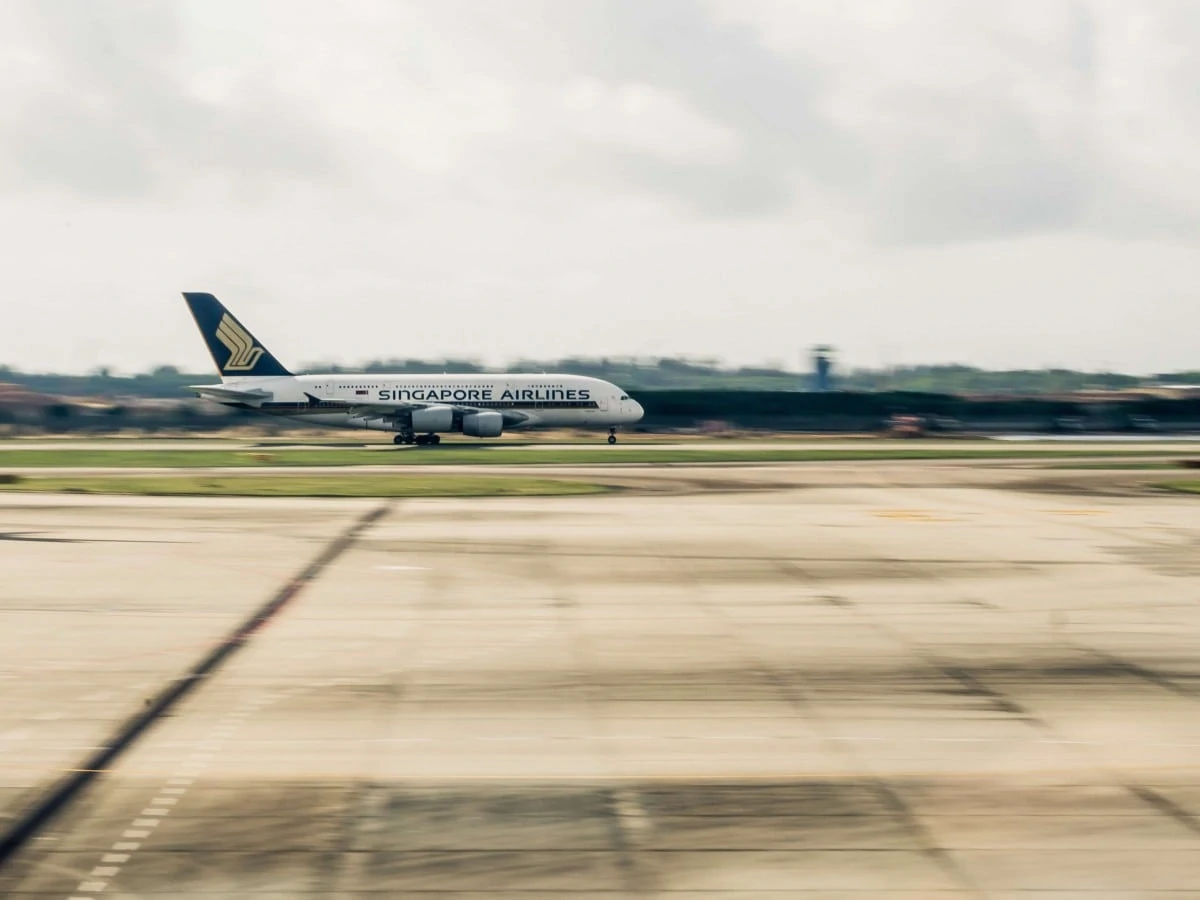
Car Rental
There aren’t many countries in Southeast Asia where we’d recommend that you rent a car for your itinerary, but across Malaysia is definitely one! The roads are some of the safest to drive in the region.
Check out the cost of renting in Malaysia on RentalCars.
Travel Insurance for your Singapore Malaysia trip
Got your travel insurance booked? We promise to never push a brand or product we don’t personally use, and the travel cover from Safety Wing is a policy we don’t just use, but we highly recommend. They offer some of the most flexible policies, amazing customer service and are affordable too.
Check out the latest travel insurance prices with Safety Wing here.
Day 1 – Singapore
So you’ve landed into Singapore, and we’ve given you a couple of days to explore this wonderful city. In our opinion that’s probably just about long enough to get around and see the key sights, but if you want to extend your time here, we’ve also outlined a few other activities that you could add into your Singapore itinerary.
Explore Little India
After dropping your bags at your accommodation, head out to our favourite part of Singapore: the bustling Little India. If you’re hungry, start at Race Course Road (this area actually used to be home to a race course), and try some of the famous fish head curry! Not so into fish (or heads) you’ll find some of the best Indian food in the world.
The two other major things to do in Little India are visit the temples and shop. The most famous temple in Little India, Sri Veeramakaliamman is also one of the oldest in Singapore and definitely worth a stop for some photos and to learn more about the Hindu religion. The temple is open daily from 5.30am to 9.30pm.
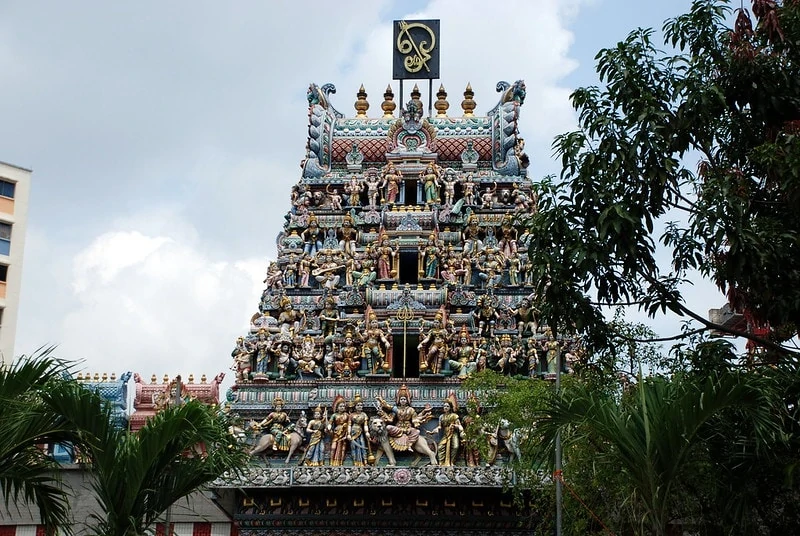
Photo Credit: J Powers 65 / Flickr
And then for a quick shop, you must head to the Mustafa Centre – a 24 hour Singapore institution. Here you’ll be able to find everything from groceries to electronics, books to jewellery…
Walk over the Helix bridge
Next head over to the start of the Helix Bridge – it’s about a 3km walk from Little India so you may want to take a Grab (Uber in Southeast Asia), especially since it can be crazy hot and humid in Singapore. This pedestrian bridge is made from over 650 tons of stainless steel and 1000 tons of carbon steel fused to look like a ‘helix’, and is a great place to take a photo.
As you arrive at the end of the Helix Bridge you can see the Singapore Flyer. It’s a bit like the London Eye and a great thing to do in Singapore at night, if you want to add it to your plate.
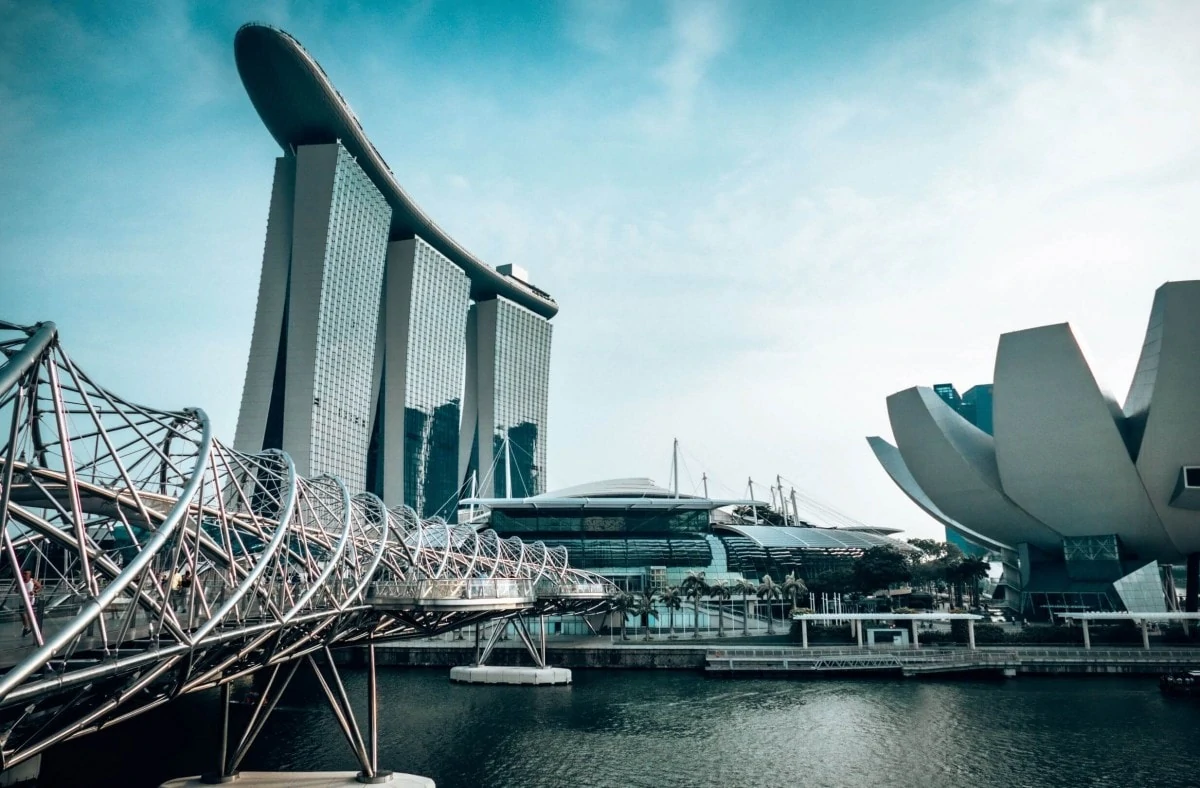
Check out the Art Science Museum
At the far end of the Helix Bridge you’ll find the Art Science Museum, which has really become an Instagram hotspot recently, with its Future World Exhibition. This permanent fixture includes interactive digital art installations including a digital garden full of waterfalls, butterflies that flit away when you touch them and scattering cherry blossoms.
Open daily from 10am to 7pm, this is a really fun, interactive museum that’s great for both adults and kids.
Click here to buy tickets for the Art Science Museum?

Take a tour of the Gardens by the Bay
The most visually stunning place in Singapore and an absolute must for your itinerary, the Gardens by the Bay is one of the best attractions we have visited. It’s also reviewed as the number one destination in Singapore on TripAdvisor, so has to make your list.
Set a short walk from the Art Science Museum, the Gardens by the Bay is an incredible garden complex. It’s free to enter and just wandering around the Supertree Grove is absolutely gratis but you’ll need to purchase tickets for some of the attractions.
If possible, time your visit for the late afternoon so you have the time to explore both the Cloud Forest and the Flower Dome at a minimum, before staying in the evening for the free light show that is set to music in the Supertree Grove! There are two free evening light shows daily at 7.45pm and 8.45pm.
Check out the latest prices for combo tickets here.
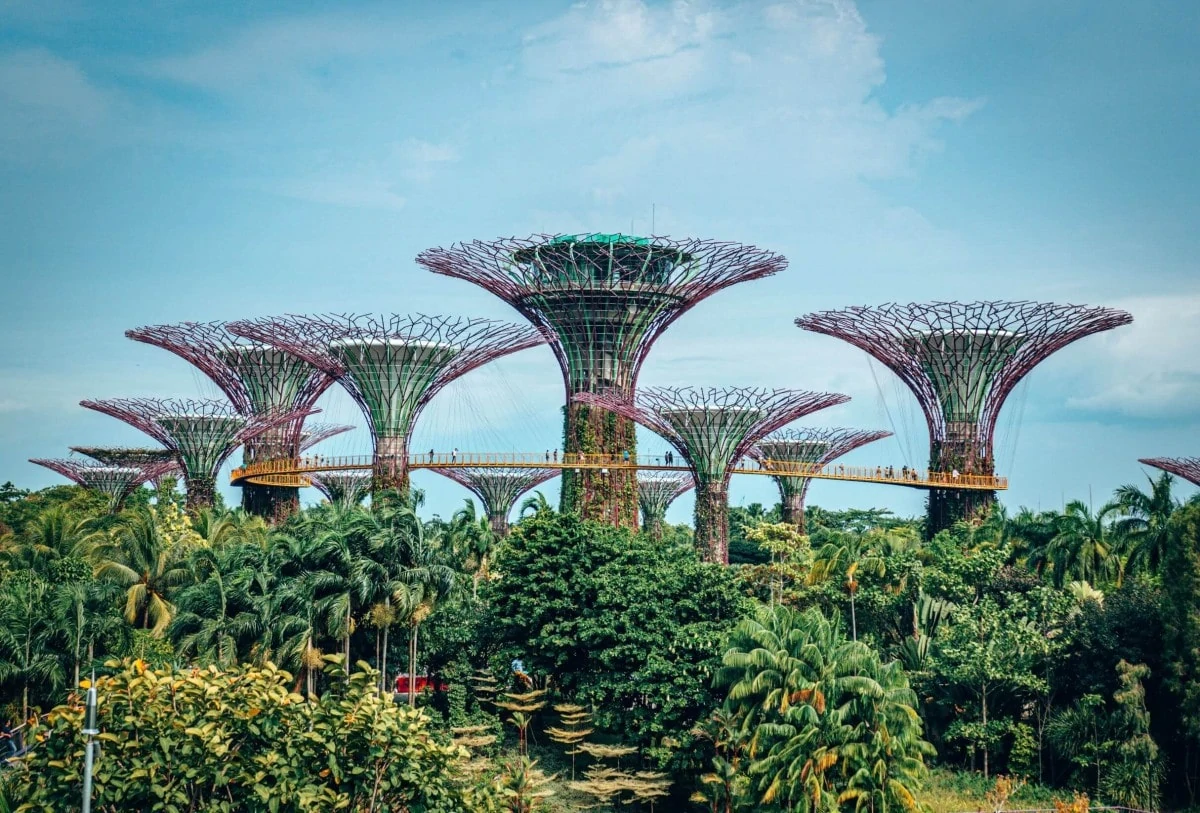
Where to stay in Singapore
Budget: Set in our favourite Little India district, if you’re on a little bit of a budget you should check out the Vintage Inn Boutique Capsule. With hotels and accommodation being quite expensive, there are a lot of budget pod style options in Singapore.
Mid-range: If you’re keen to stay in Chinatown, one of the best-rated hotels in the area is the AMOY. A wonderful 4* star property, this boutique hotel is super charming and well-designed, inspired by China yet delivered with a modern twist.
Luxury: If money is not an option, then you have to check out the Marina Bay Sands. As the most recognisable hotel in Singapore and the epicentre of all the things to do, you can’t get a better option.
If you’re looking for a few more hotel options in Singapore, we have broken down our favourite areas to stay here.
Getting from Changi Airport into town
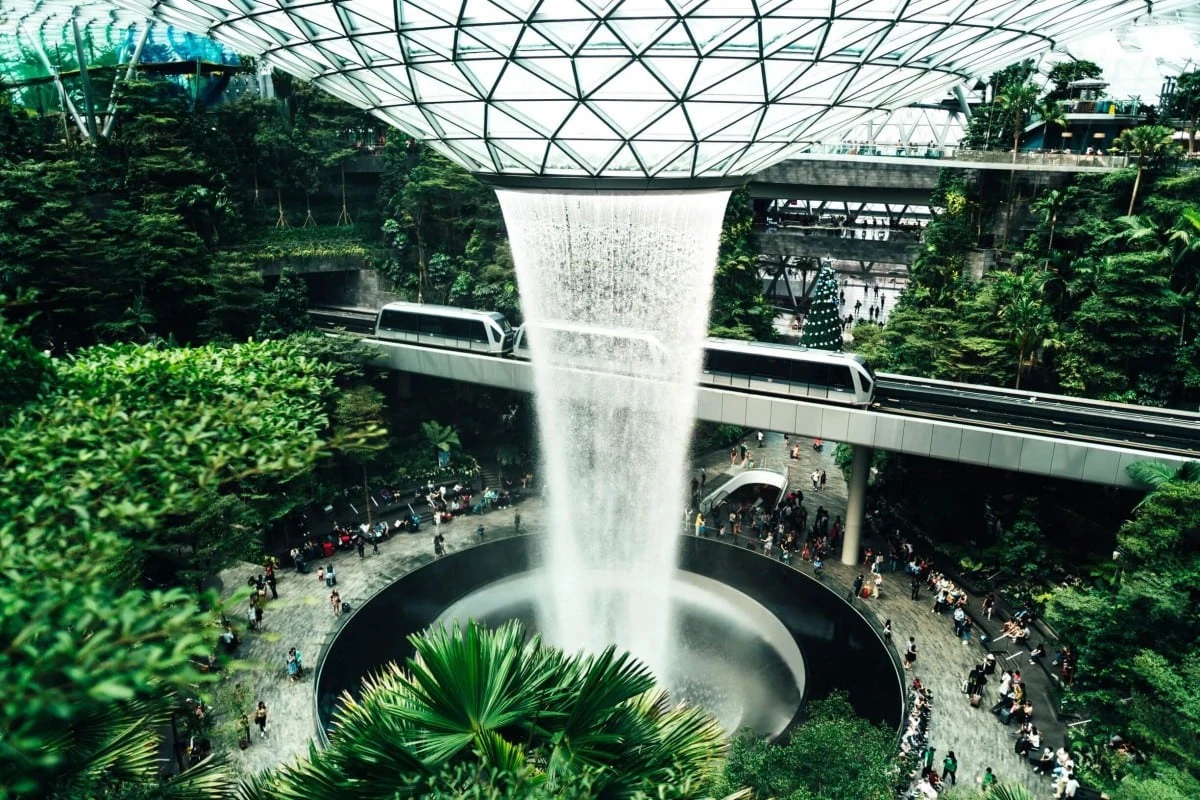
Airport shuttle bus: Taking around 30 minutes to get from the airport to the city centre, the shuttle bus is a great option for when you first arrive into Singapore. In the arrival halls at Changi you can book a ticket at the Ground Transport Deck, the cost of the ticket is 9 SGD (6.20 USD/5.30 GBP).
MRT: The MRT is cheap, fast, clean and reliable – making it our preferred way to get from the airport to the city centre. A ticket will set you back around 2 SGD (1.40 USD/1.20 GBP), but note that you’ll need to change stations on your journey. If you’re used to the Underground or Metro then this will be a doddle.
Taxi: The most expensive way to get to your accommodation from the airport, but also the most convenient. Pick up a Grab or a taxi from outside arrivals. Starting price for the journey is around 20 SGD (13.80 USD/11.80 GBP) for the 20 min journey into town, but costs can go up quite a bit depending on where you are staying. Also good to note that there are a lot of potential surcharges that can add to the costs.
Day 2 – Singapore
Now you could easily spend your entire second day out on Sentosa Island – we’ve put some more info on that in the Bonus Activities below – but we aren’t huge fairground and resort fans, so have suggested some other activities. That said, feel free to swap these out!
Visit Fort Canning
When we stayed in Singapore we were near Fort Canning, a great estate to beat the heat in Singapore. More than just a green space in the city, For Canning is where the Malay royalty used to live, as well as where the British surrendered to the Japanese during World War II. Take a walk around the grounds to see the Maritime Corner, the Fort Gate (remnants of the fortress), the Spice Garden and even a former underground military complex, called the Battle Box.
You can also hop over to the National Museum of Singapore, located a few metres away or over to Clarke Quay, a selection of waterside restaurants and bars. We really enjoyed a glass (or two) of wine at Wine connection at Clarke Quay’s Robertson Walk.
Kampong Glam – Haji Lane, Arab Street and more
Now you’ve explored Little India and possibly taken a turn in Chinatown so its worth circling another area of cultural highlights, Kampong Glam. This is the historically Muslim quarter of the city which houses the very famous Haji Lane and Arab Street.
Start off with Haji Lane, a bit of a gem for shopaholics. This narrow, slightly shabby street is flanked by unique boutiques seeing retro clothing; a far cry from the luxury malls the city is known for. There is also a lot of street art dotted around the Haji Lane area that is worth taking a snap of.
Next up, move on through to Arab Street where you’ll find traditional carpet and textile stores, perfume shops, cafes and restaurants. Eat some traditional Muslim food, bargain over some wares and just enjoy immersing yourself in the culture of the area.
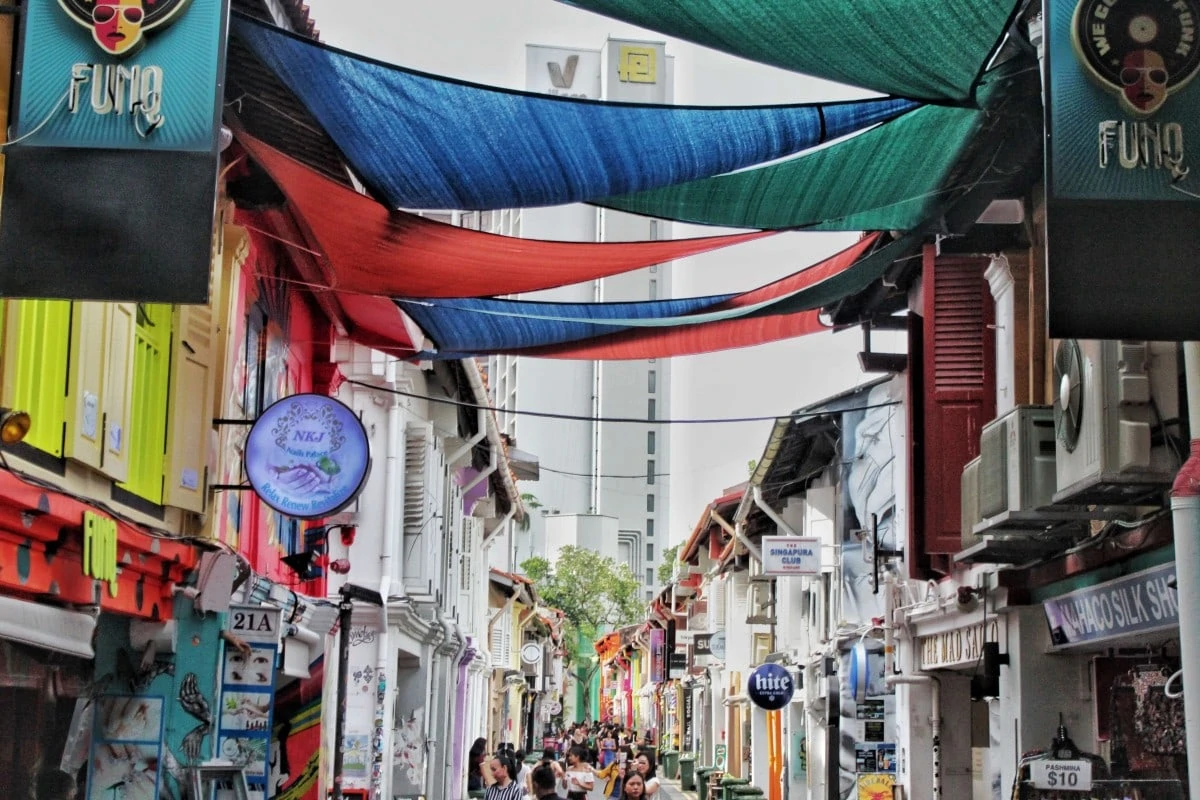
Other highlights in the Kampong Glam are includes the city’s largest mosque, the Masjid Sultan, the picture perfect road of Bussorah Street or the Malay Heritage Centre, which includes nine different galleries featuring the history and culture of the Malaysian people in Singapore.
Take a night safari
We aren’t fans of zoos, but the Singapore Zoo does an amazing job and, if you are going to visit a zoo, you should try it at night! It’s like Night at the Museum come to life, but with animals! Essentially the Night Safari is the globe’s first nocturnal wildlife park where you can see over 900 animals on an evening safari. This 35 minute tram ride showcases everything from leopards to lions as well as a 20 minute show called ‘Creatures of the Night’ set in a massive outdoor amphitheatre.
Bonus things to do in Singapore
So there’s only so much you can cram into two days in Singapore, but just in case you’re hoping to extend your time in the city, here are some of our other top recommendations on what to do as part of your Singapore itinerary:
Shopping on Orchard Road
One of the most famous shopping roads in Asia, if you’re keen to get some serious retail therapy done while in Singapore then Orchard Road has to be your go to place. The 2.2km stretch of road has department stores, shops and food courts galore. You could spend a few days here if shopping is your thing.
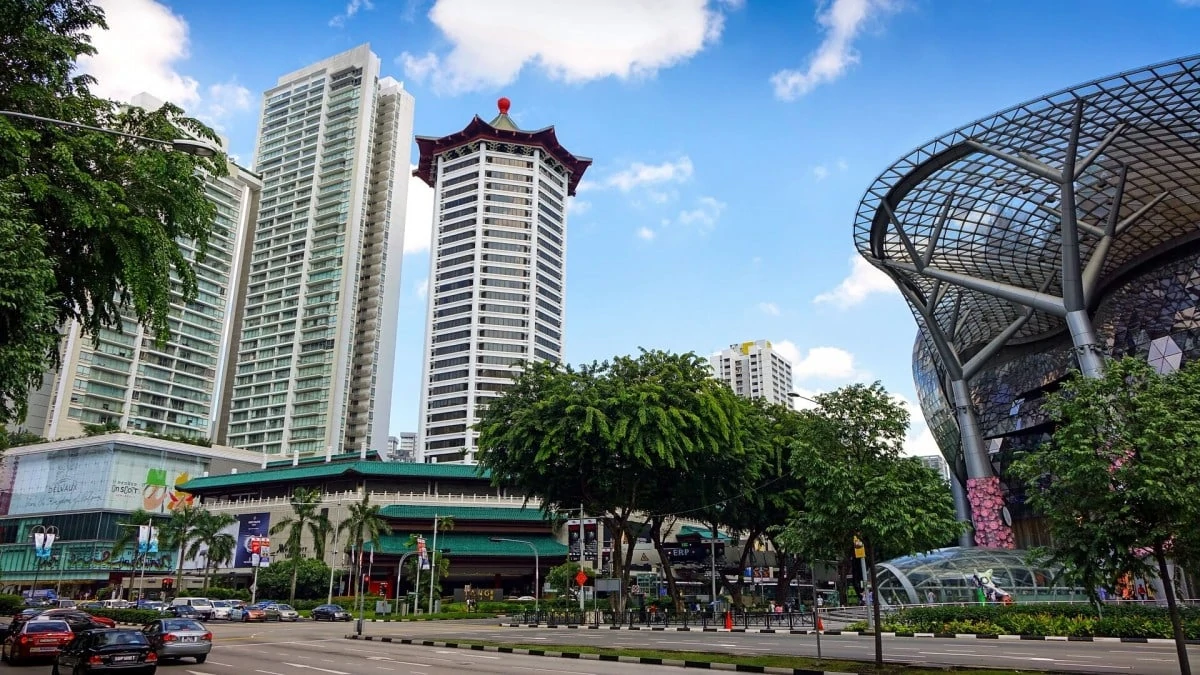
Drinks at Raffles
You’ve probably heard of a Singapore Sling? What you probably didn’t realise was that it was invented at the Raffles Hotel back in 1915… so make sure that you try out a cocktail at this famous establishment. Open from 11am to midnight, you might want to ring ahead to reserve a table! And it won’t be cheap either…
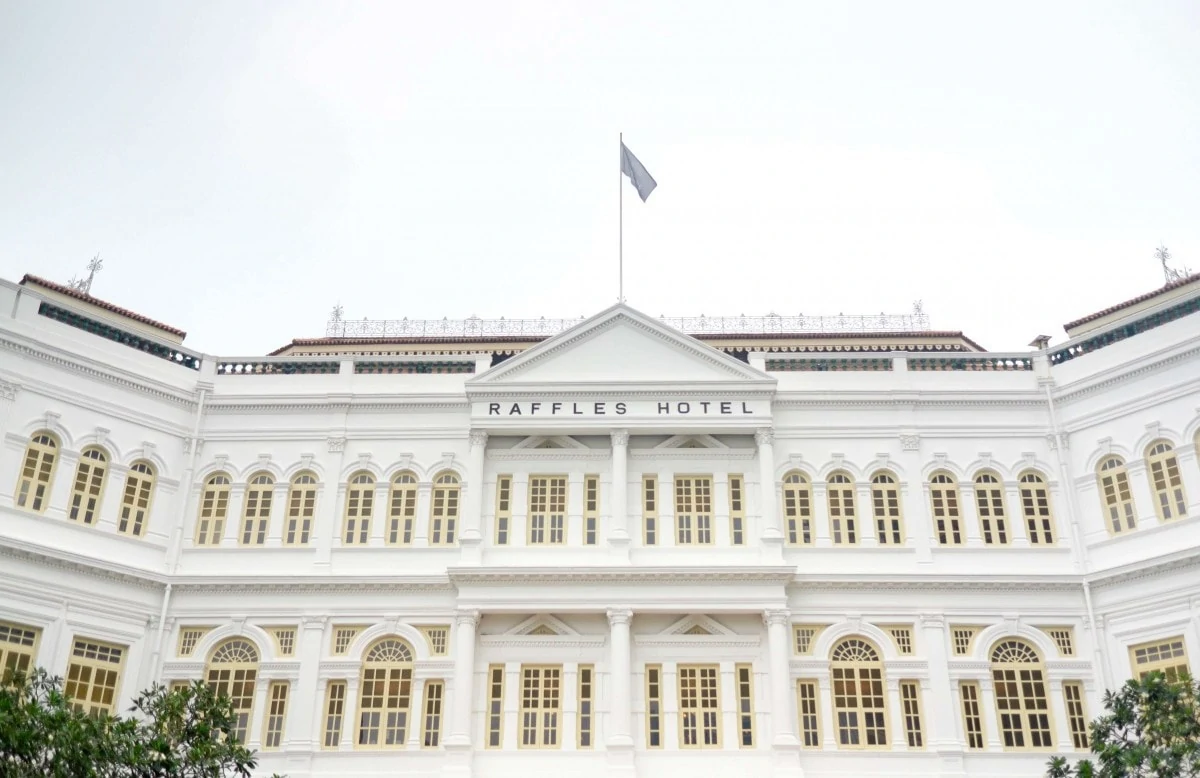
Sentosa Island and Universal Studios Singapore
Its worth an entire day trip out – checking out the many attractions on Sentosa Island across the Singapore River, particularly Universal Studios. Start your tour at Merlion Plaza and climb up for fantastic views of the city. Try the zipline at Mega Adventure, visit the incredible aquarium, try the skyline luge… the number of things to do on Sentosa are almost endless!
Universal Studios is undoubtedly one of the biggest drawcards on Sentosa. This 50 acre theme park has seven massive themed zones including Hollywood, Ancient Egypt, Madagascar and Sci-Fi City. Whether you’re an avid movie buff or just want to go for the 24 rides and attractions, Universal Studios is a huge fun day out.
Check out the various Universal Studios ticket options here.
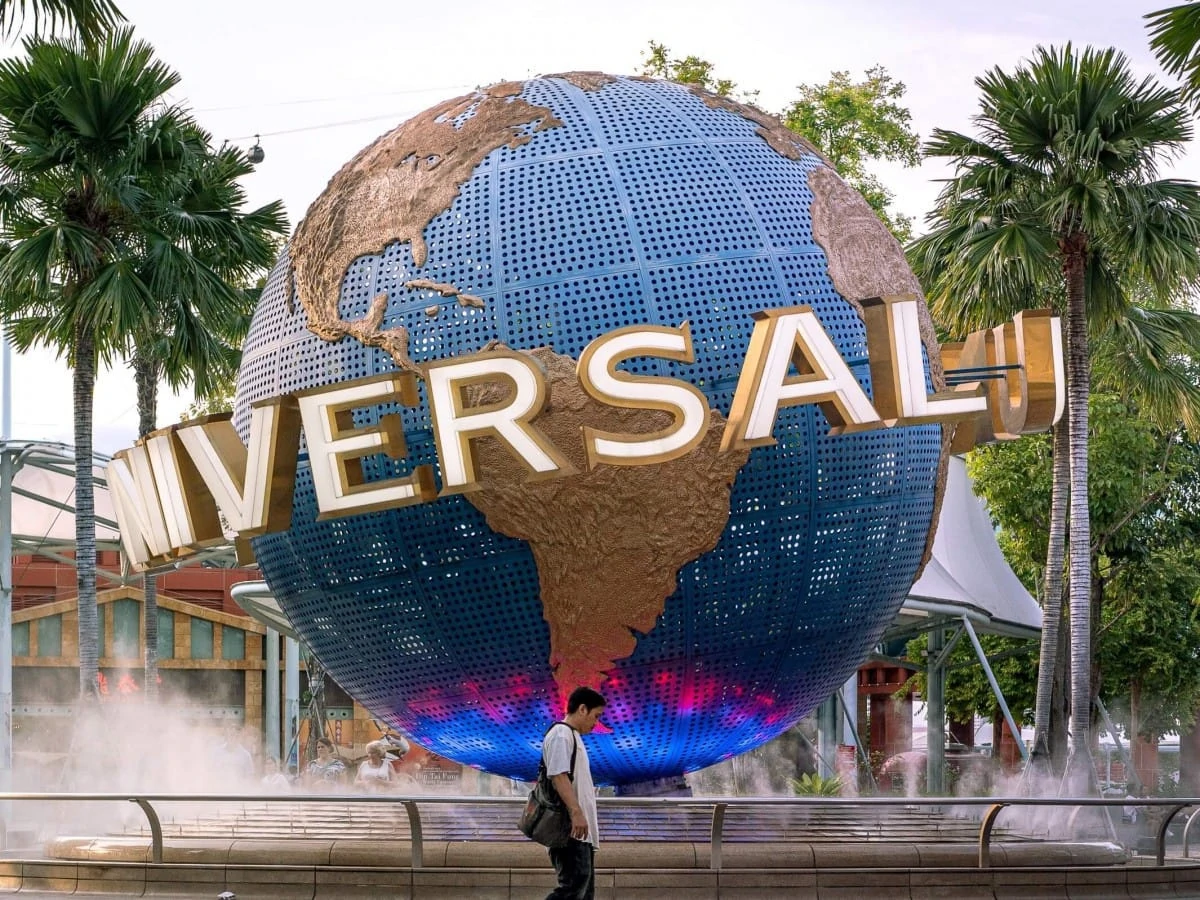
Looking for a Singapore Travel Guide focussed on activities after dark? Well, luckily we have a full article on the top 10 must-do’s put together by a local (a good friend of ours), and tested out by us when we visited recently. So make sure you check this out if you want more ideas for evening fun!
Day 3 – Singapore to Melaka (Malacca)
After you’ve had some breakfast, check out and take the bus to Melaka, this will give you enough time in the afternoon to check out a few of the local attractions. If you haven’t heard of Melaka, then you’re in for a treat. Also spelled as Malacca, the city is a UNESCO World Heritage city and is chockfull of colonial buildings, street art and to-die-for cuisine!
In the afternoon, head out on a walking tour of the old town to check out the heritage buildings – there are loads, but we’ve picked the below as an easy circular walk that won’t take a huge amount of time.
Note: We’d recommend a bus with a 10.00am departure to allow you to arrive into Melaka and check into your accommodation at around 2pm (generally the time for most hotel check ins).
See the A’Famosa
Starting at the A Famosa, also known as the Porta de Santiago. This landmark was built in 1511 by the Portuguese but today not a lot of the fortress remains as it was pretty much destroyed by the Dutch in the 1641 invasion. All that currently stands is the main gate of the fortress – but it’s a great place to start your heritage walk.
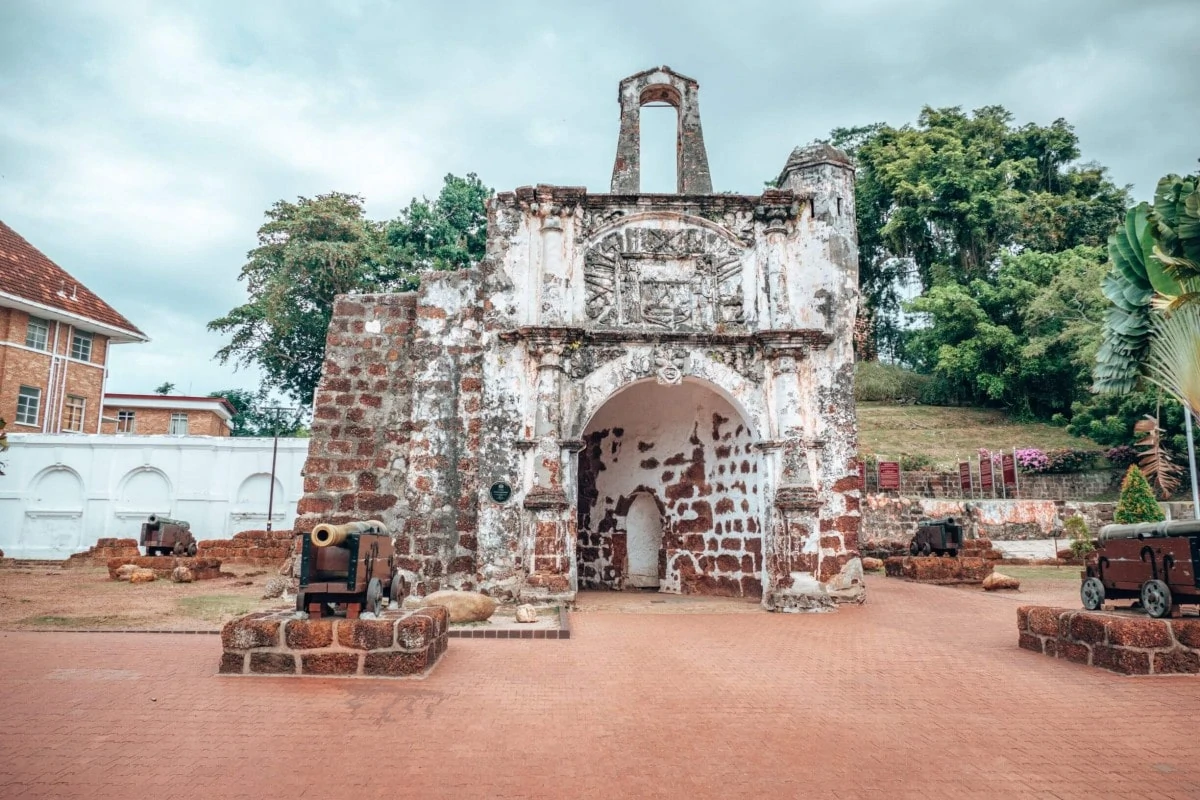
Walk up to St Paul’s Hill and Church
Right behind A’Famosa, you’ll find St Paul’s Hill and St Paul’s Church – it’s about a 5 minute walk up the hill by steps so not too strenuous. And is definitely worth it for the views alone.
The church was originally built by the Portuguese but was turned into a fortress during the Dutch siege, although returned to it’s role as a church afterwards. Nowadays the church is left in ruins without a roof or any doors, but is worth a turn regardless. There’s also a slightly spooky Dutch graveyard within the grounds.
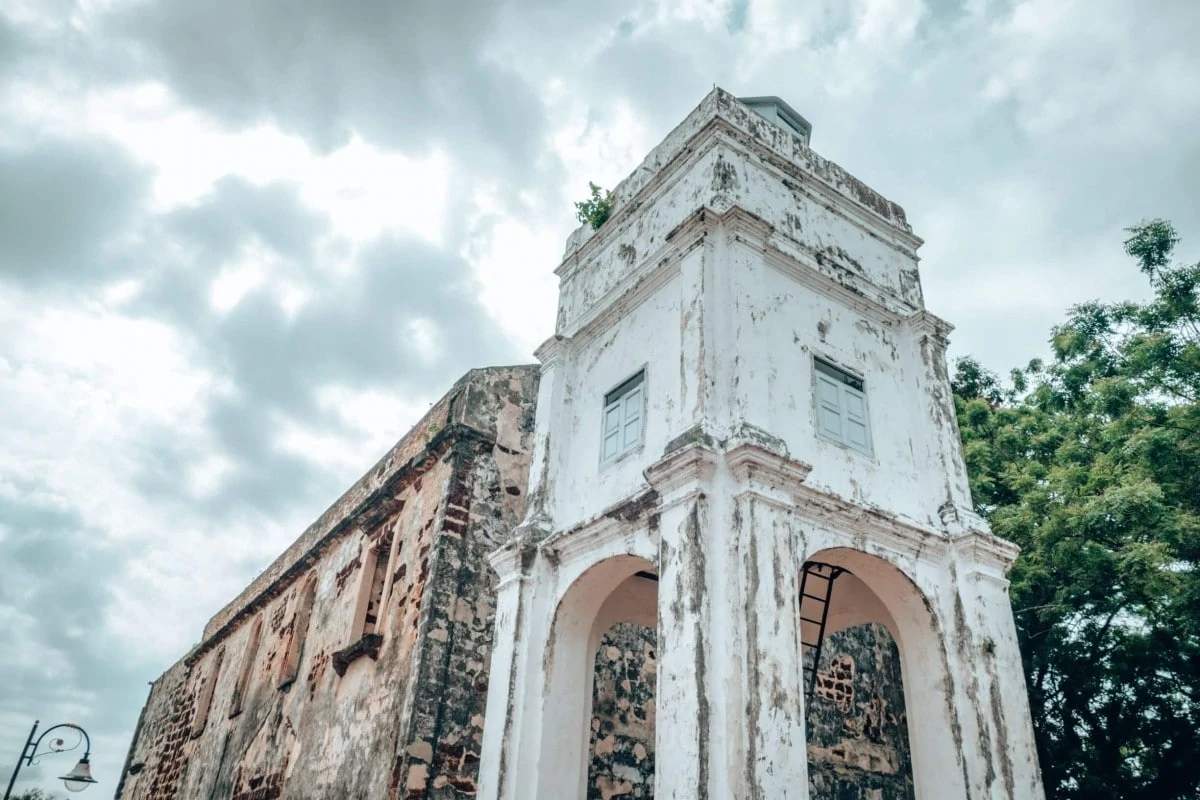
See the Stadthuys
Descending the stairs at the far side of St Paul’s Church you will eventually make your way down to the old city hall, the Dutch-built Stadthuys – which is the oldest standing Dutch building in Southeast Asia, dating back to 1650.
No longer the city hall, although impressively used as such for over 300 years until 1980, the building is now used as a museum chronicling the history of Malacca, and well worth a quick visit. During the week, the museum is open from 9am to 5pm, with later hours at the weekend (open until 8.30pm).
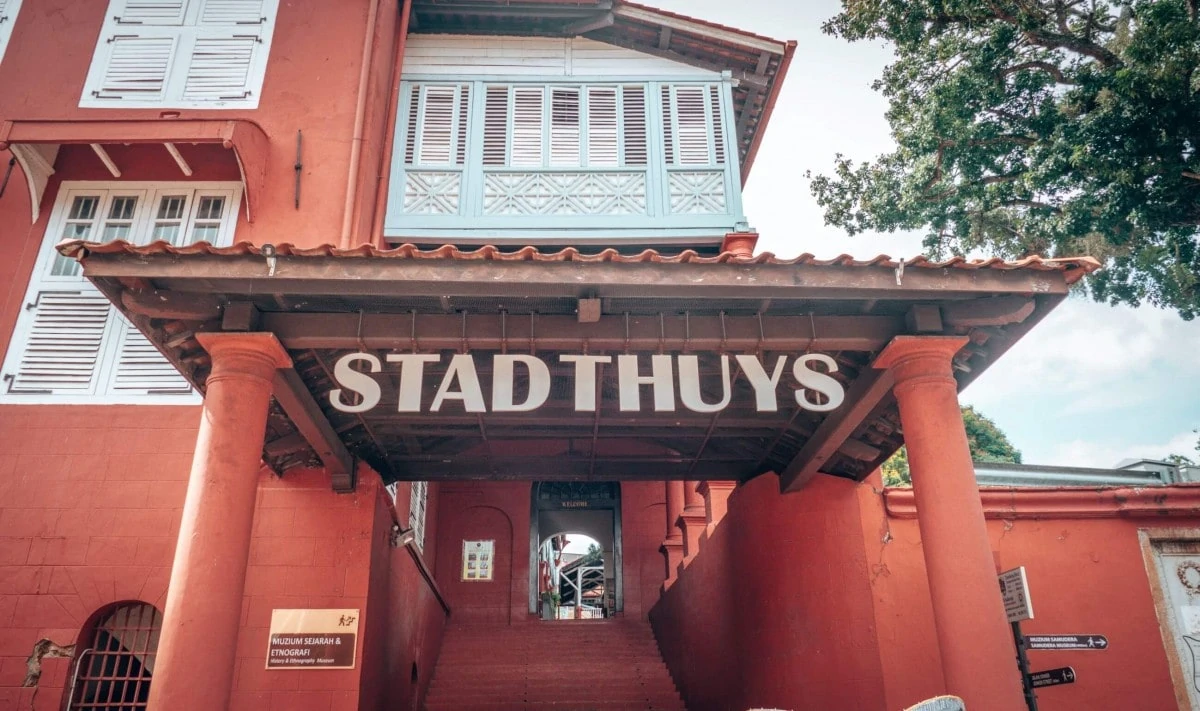
Check out Christ Church
Right next to the Stadthuys, you’ll find the city’s most iconic landmark: the Christ Church. Built in 1753 by the Dutch, it was constructed to celebrate 100 years of Dutch rule in the city.
The striking red brick building sits in a square, with the old clock tower, fountain and a much more modern I Love Melaka sign; all perfect for a few Instagram (or postcard-perfect) pictures! After visiting the church, head down the red street towards your final location for the day: St Francis Xavier’s Church.
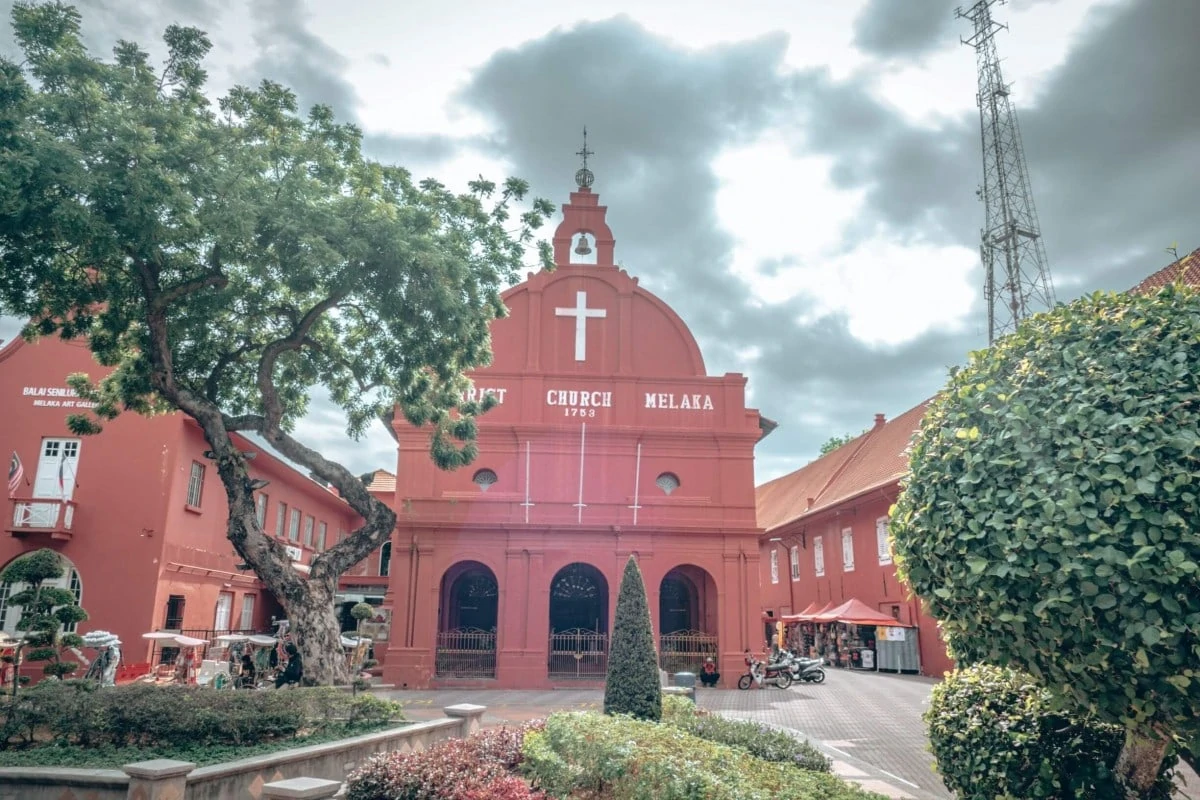
Visit St Francis Xavier’s Church
Located at one end of Jalan Laksamana (the red road), you’ll find this beautiful church from the 1850s that was built in homage (and named after) St Francis Xavier, one of the pioneering missionaries who came to Southeast Asia in the 1500s.
Note: there is a pretty cool piece of street art on the wall opposite the church, so don’t miss that!
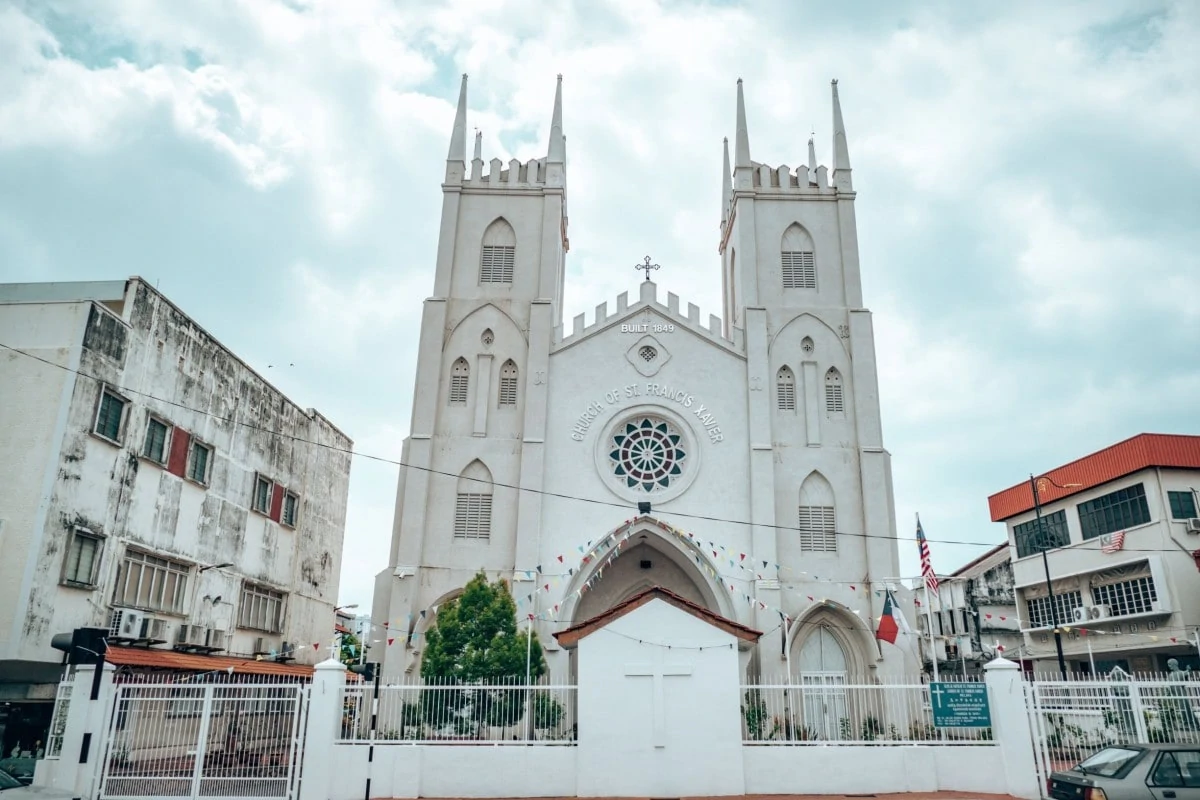
Getting from Singapore to Melaka
Travel time: 4 hours
Bus: The easiest way is to take a bus between Singapore and Melaka – and the good news is that there are multiple options for this journey which takes around 4 hours. Check out the latest bus options here with Bookaway.
Air: Although there is an airport in Melaka there is no direct flight to Singapore, and you’re looking at a 5 hour plus journey, so we’d definitely recommend going by road instead.
Where to stay in Melaka
Budget: On a budget, Ola Lavanderia Café is a hostel in the heart of old town that offers great shared and private rooms.
Mid-range: If you’re wanting to be in the heart of the old town, actually staying in one of the heritage buildings check out JonkeRED Heritage Hotel. A family run hotel, we loved staying here: great rooms, really affordable and right in the action.
Luxury: Just a minutes’ walk to Jonker Street, with infinity pool, gym facilities and everything else you’d expect from a 5* hotel, we’d recommend that you look at Casa Del Rio Melaka.
Day 4 – Melaka
Take a stroll down Jonker Walk
Well technically, Jonker Street, but the sign says Jonker Walk – this street is a great place to come and explore a number of cafes selling Portuguese egg tarts, salted egg croissants, cendol and the famous Gula Melaka Latte. If you’re looking for a recommendation, we’d suggest the Stolen Cup. Great food, nice atmosphere and strong wifi!
Alongside refuelling for the day ahead, the street is also home to some quirky antique and arts and crafts shops.
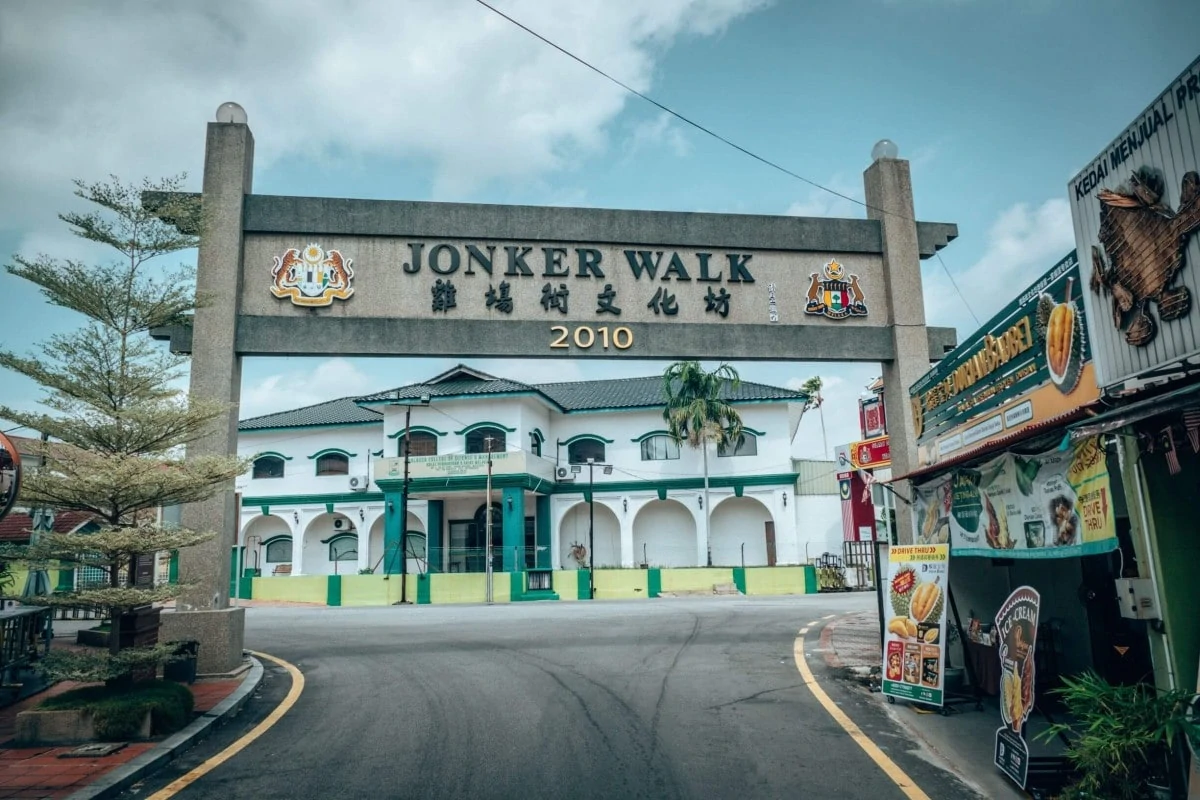
Explore Cheng Hoon Teng
On the road that runs parallel to Jonker Street you’ll find a number of amazing temples and religious buildings to explore. While the road is called Jalan Tukang Emas its locally known as ‘Harmony Street’ as it is home to three religions: a Chinese Buddhist temple, a renowned mosque and a Hindu temple; all of which you’re about to visit!
Starting at the far end of Jonker Street (ie. furthest away from the Melaka River), you’ll first come across Cheng Hoon Teng.
Built in the 1600s, this temple has been an administrative centre, a court of justice and, of course, a temple itself. One of the most beautiful Chinese temples in Malaysia, it’s also the country’s oldest!
Also, don’t miss another temple just across the road: Xiang Lin Si Temple. Named after a Chinese monk, this village-style temple is very photogenic, so great for a photo.
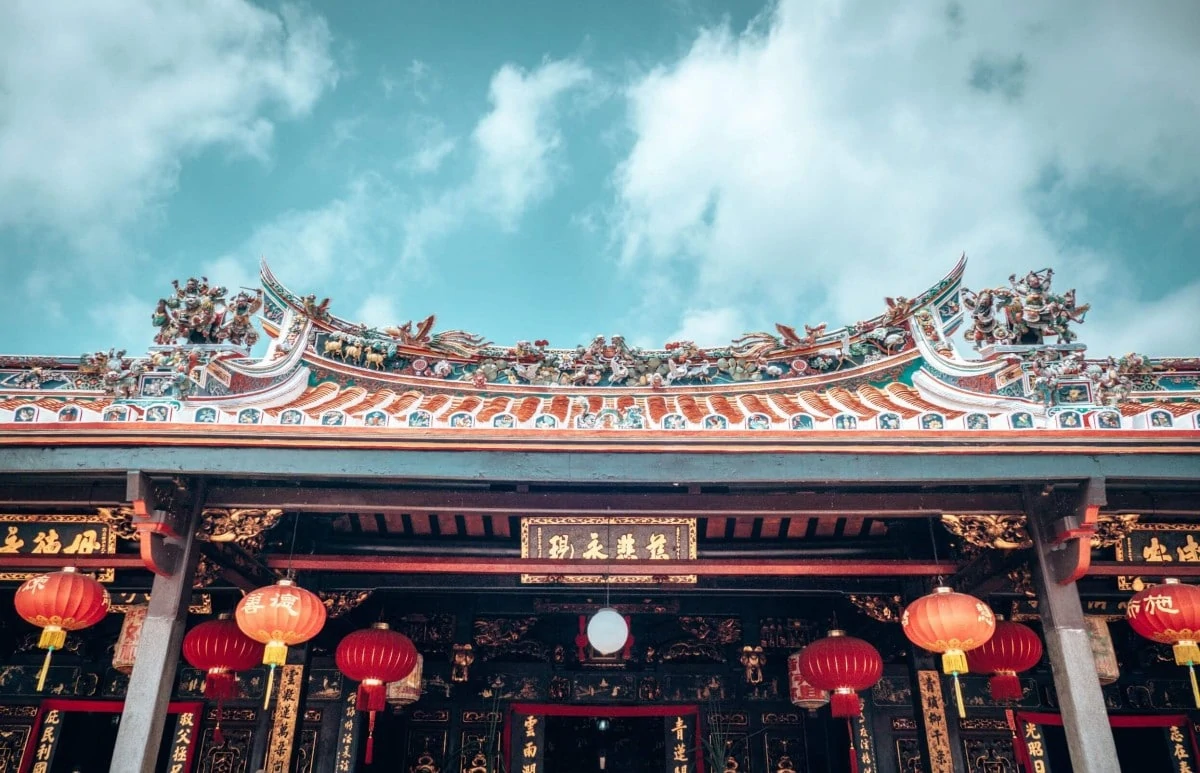
Visit Kampung Kling Mosque
From Chinese culture to the Islam faith, a short walk away is the Kampung Kling Mosque (Masjid Kampung Kling). Unlike many mosques in Asia which are built on a hexagon, the Kampung Kling mosque is square, made out of wood with a three-tiered roof. There are a number of Chinese influences on the temple: ceramic tiles, curved eaves and colonnades. Even the minaret slightly resembles a Chinese pagoda.
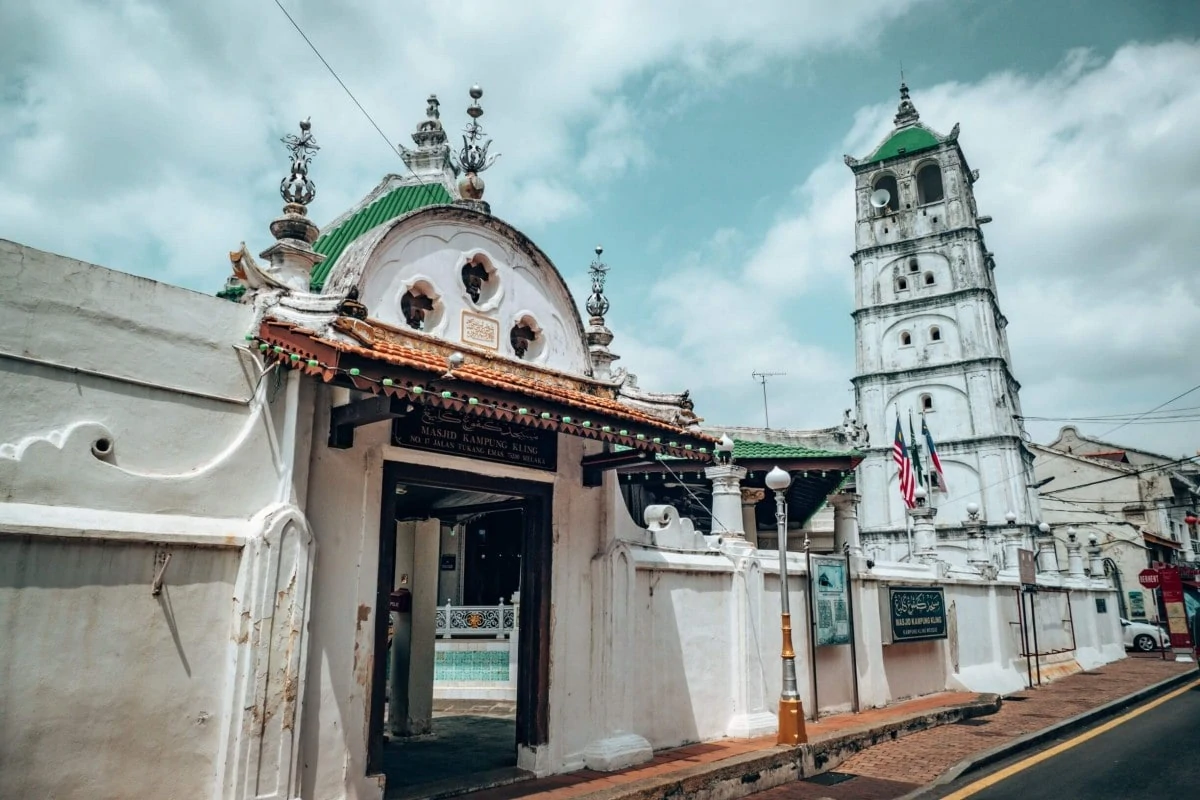
Take a snap at Sri Poyatha Moorthi Temple
The last of the three religious structures is the Hindu property, Sri Poyatha Moorthi. The oldest Hindu temple in the country and one of the oldest functioning Hindu temples in Southeast Asia, this temple was built back in 1781 by Thavinayagar Chitty, the leader of the Chitty people, after the Dutch gave him a plot of land in Melaka. The temple is dedicated to Vinayagar and Ganesha, the elephant deity.
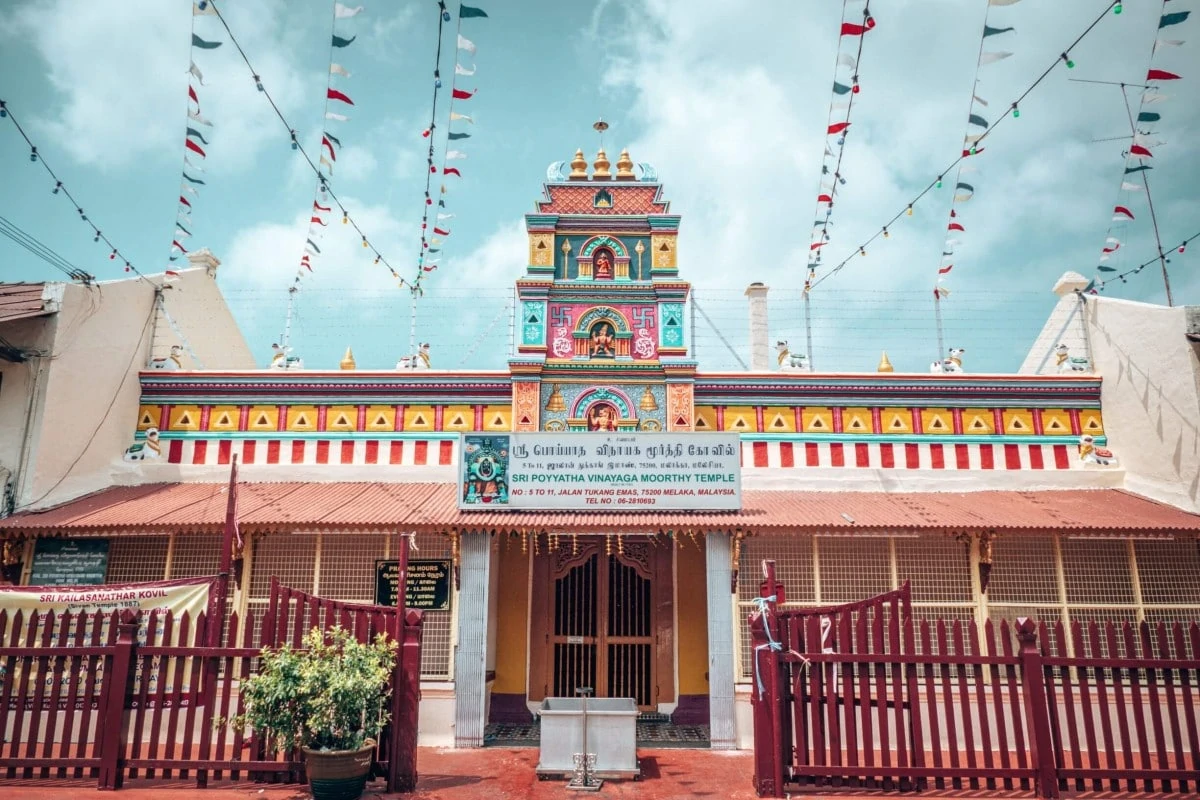
Explore the street art
Although not up there with Penang and Ipoh just yet in terms of the quality of the street art, there are some great little pieces that you’ll find dotted around the old town, so well worth keeping your eyes peeled for these pieces. You’ll find some of them easily by walking down by the Melaka River, some just off Lorong Hang Jebat and other pieces not far from the Hang Jebat Mausoleum.
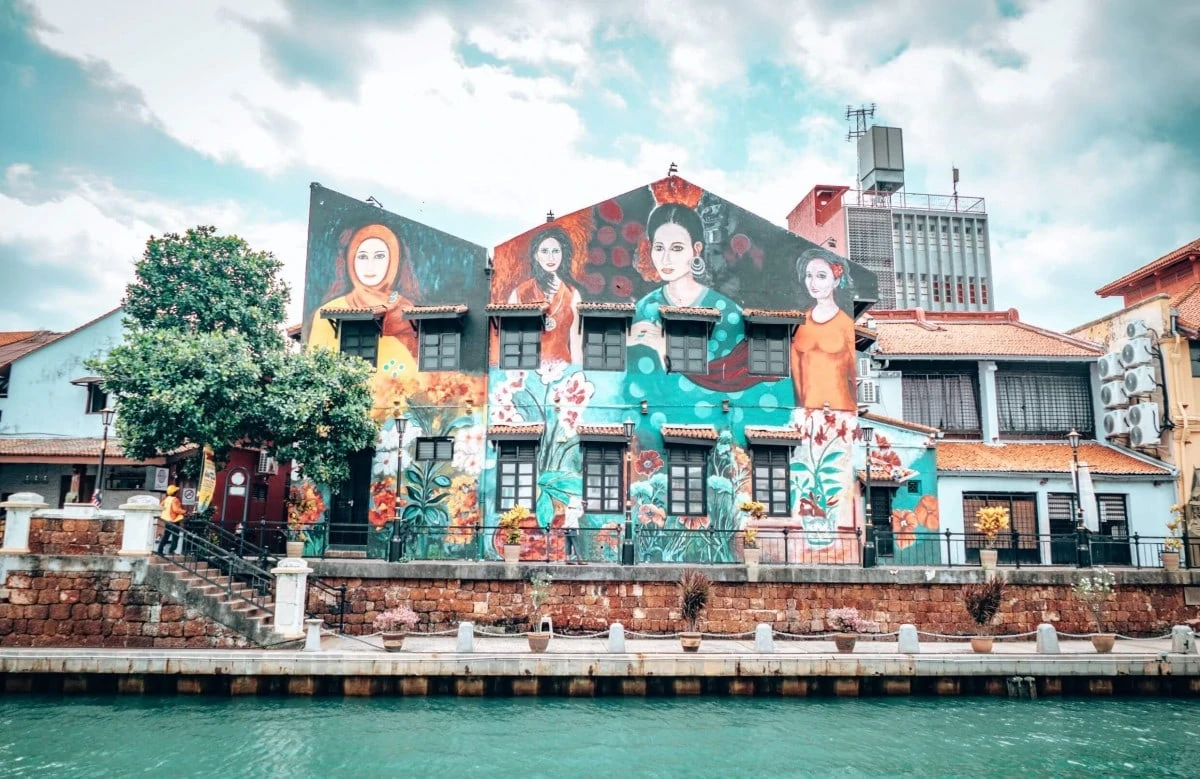
Bonus things to do in Melaka
Meander around the museums
There seem to be more museums in Melaka than any other place that we’ve been before! Or it may seem like that as so many of them are located all around St Paul’s Hill. Whether you want to visit the transport museum or check out the stamp museum, there’s pretty much something for everyone!
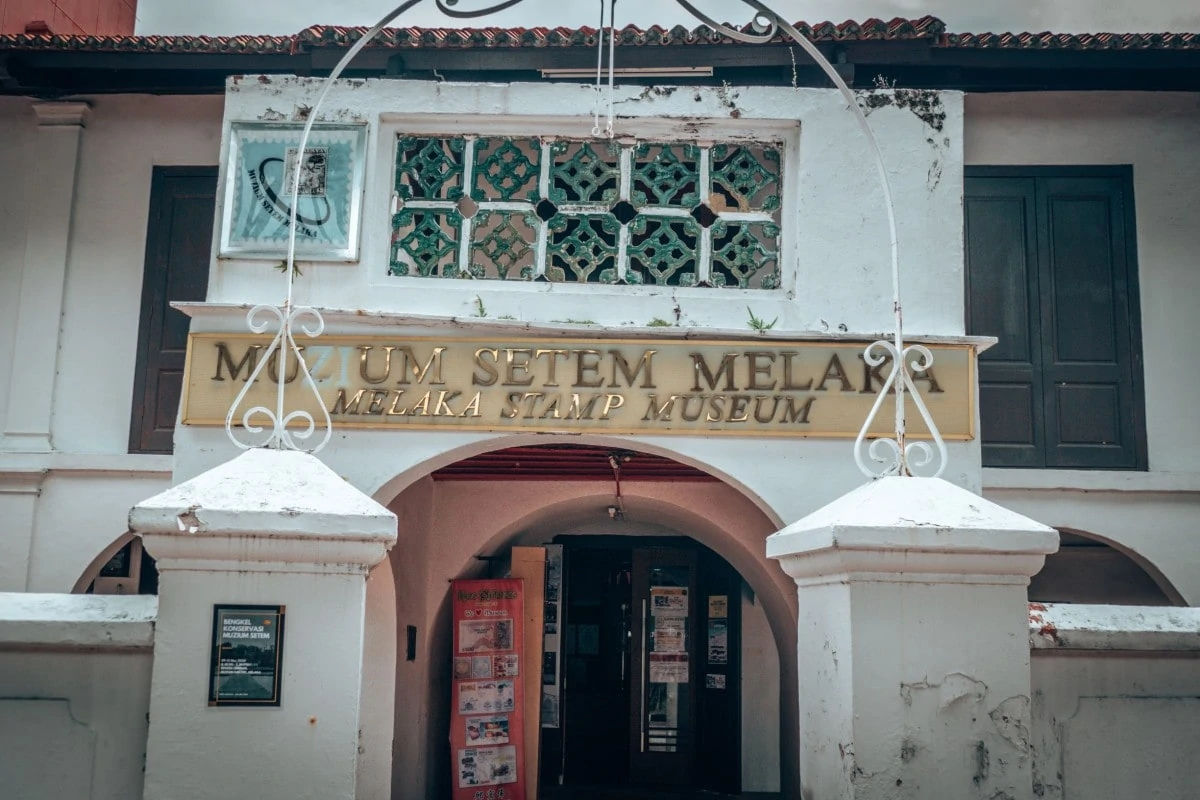
Check out the Menara Taming Sari
Not something that we actually did, but it seems to get pretty good reviews, the Menara Taming Sari is a cross between a viewing tower and a theme park ride (albeit a tame one at that). The tower has a moving, rotating viewing tower that takes you from the ground to 110m in a matter of minutes, providing a panoramic view of the historic city of Melaka.
Open from 9am to 11pm, the 7 minute ride will only set you back 23 MYR ( 5.20 USD/4.50 GBP).
Melaka Strait Mosque
A bit further out of the city, the Strait Mosque is perched on a reclaimed 40 hectare island. This impressive mosque has seen a lot of difficulties since builders broke ground in 1996, mainly since conservationists were not impressed that it would be built atop a number of important historical artefacts, like the wrecks of many Portuguese ships. You’ll need to drive or catch a Grab taxi to see this one.
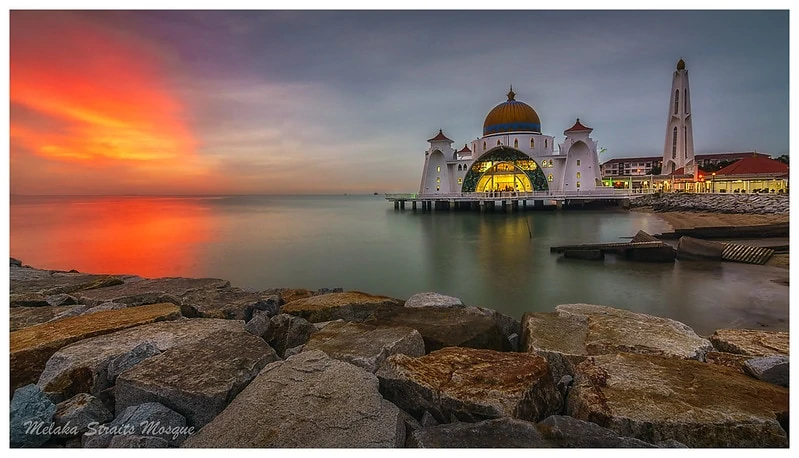
Melaka River Cruise
A 45 minute boat ride that offers a unique perspective of the city. The Melaka River Cruise will take you on a whistle stop sightseeing tour of the best sites in the city. Operating from 9 in the morning to late in the evening, we’ve heard that their night time cruise is a winner.
Day 5 – Melaka to Port Dickson
Not always somewhere that’s on the traveller or tourist map, is the small seaside town of Port Dickson. Known affectionately as ‘PD’ by locals, Port Dickson is actually a popular holiday retreat for local residents, due to its star location near Kuala Lumpur, Singapore and Melaka.
While there are a few things to do in Port Dickson – and we’ve listed them below – the main attraction is actually your accommodation! Port Dickson is home to the Lexis Hibiscus resort which has two – count ‘em two – Guinness World Records. The first for having the most overwater villas in the world (522 of them) and then for the most swimming pools in one resort, with 643 pools. The entire resort is shaped like the hibiscus, the national flower, and the entire resort is a must-visit destination in Port Dickson, hence our recommendation. We’ve put a bit more detail on the property below.
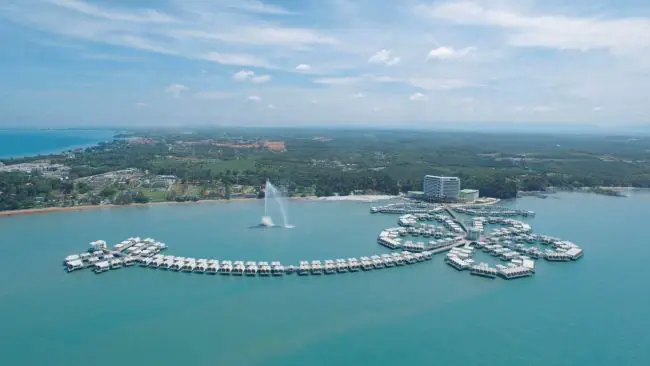
But, what about things to see in Port Dickson? Well there are actually a few: an ostrich farm, an army museum, waterfront walk and lots of hiking! Here are a few highlights:
Traipse around Tanjung Tuan (the Cape Rachada lighthouse)
The Cape Rachada nature reserve (also known as Tanjung Tuan) stretches over 80 hectares and has a number of fantastic hikes to enjoy, with some birdwatching for enthusiasts. The reserve boasts two off-the-beaten track beaches: the Blue Lagoon and Pantai Cermin but its possibly the lighthouse that attracts the most acclaim. Sitting pretty on the summit and looking out over the gorgeous Straits of Malacca is the Cape Rachada lighthouse, believed to be the oldest in Malaysia after it was constructed by the Portuguese back in the 16th century.
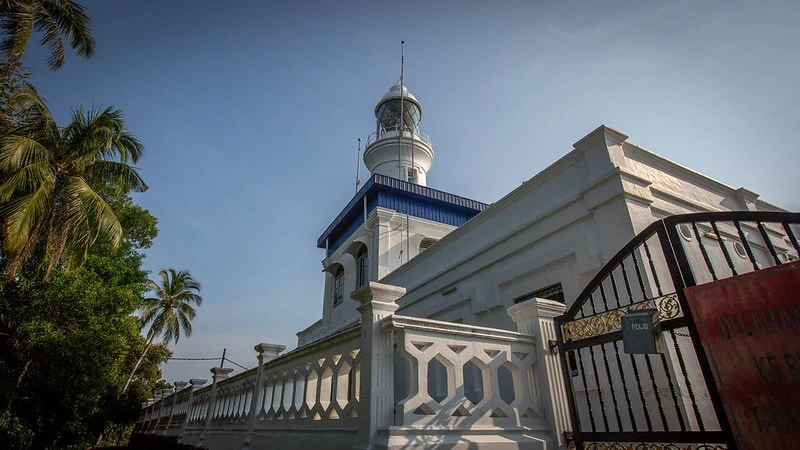
Photo Credit: Willy Tan / Flickr
Wander around the Wan Loong Temple
Situated on the coastal road this Chinese temple means ‘Dragon of the Clouds’ and is dedicated to a number of deities including the Goddess of Mercy, Kuan Yi, and the Monkey King. It’s worth a visit, and is free to enter.
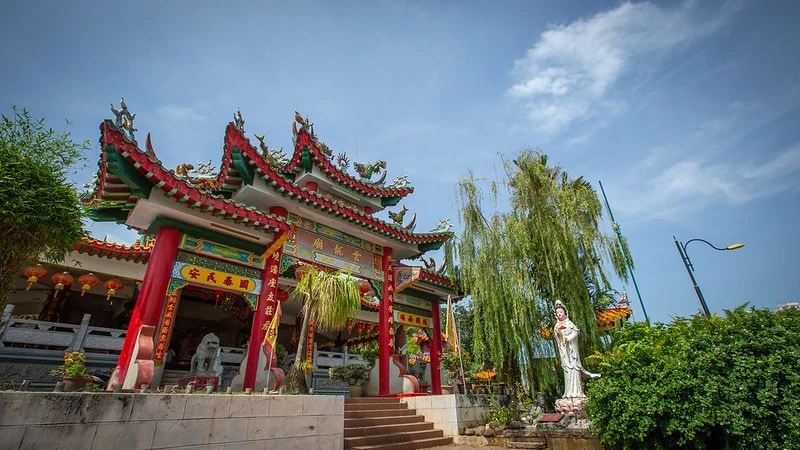
Photo Credit: Willy Tan / Flickr
Ogle at the PD Ostrich Farm
Now we might be biased since Lee’s home country, South Africa, loves ostriches but we think the Port Dickson Ostrich Show Farm is undoubtedly worth a turn! You can feed these fluffy beasts, take a few photos or, if you’re lucky, race with them! If you have kids this is a great activity since the property also has a petting zoo with farm animals as well as pony rides.
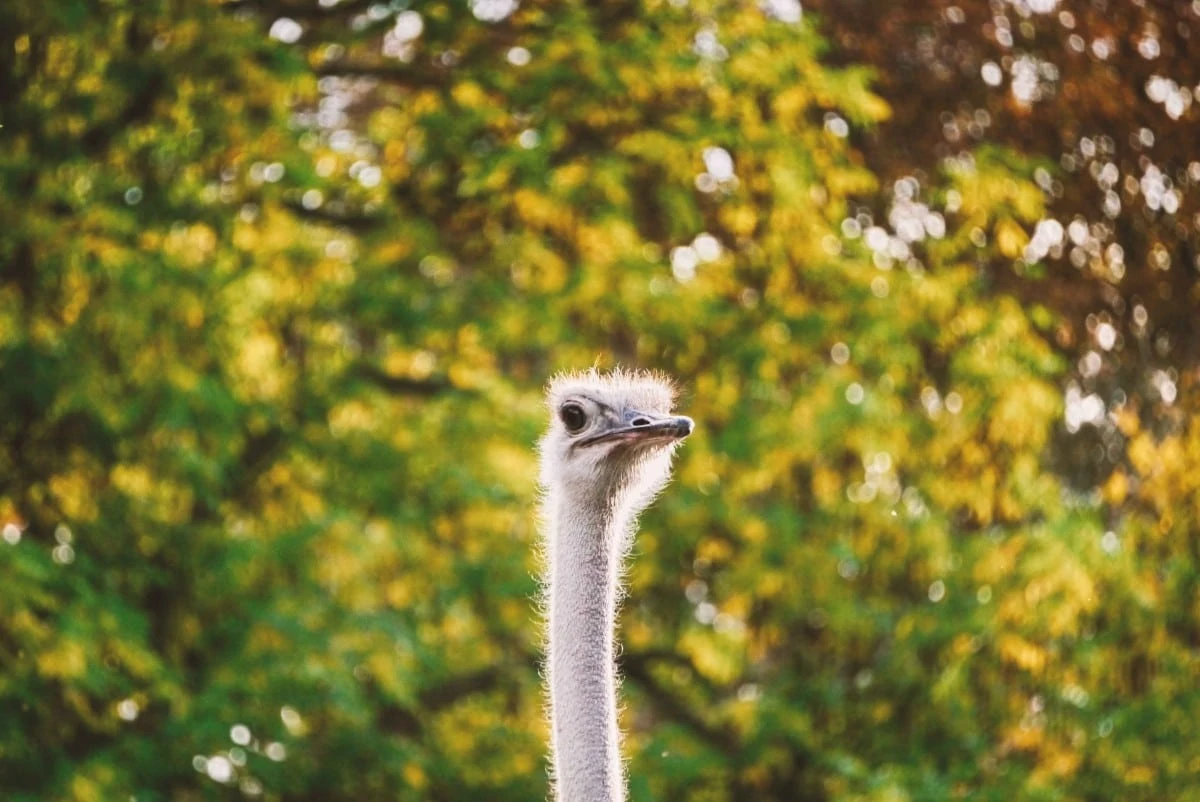
Where to stay in Port Dickson
There is only one place that you have to stay in Port Dickson, the Lexis Hibiscus. As we mentioned above, this remarkable resort is one of a kind: a gigantic hibiscus-shaped property that offers you everything of the best. The resort has 117 tower rooms and 522 overwater villas, all perfectly positioned for views of the Straits of Malacca. Located next to Pasir Panjang beach, the resort offers you water activities (a waterpark, central swimming pool, jetskis and more), has a world-class spa, it’s own karaoke complex, a multitude of bars and even activities like motorbike riding and archery, which we really enjoyed.
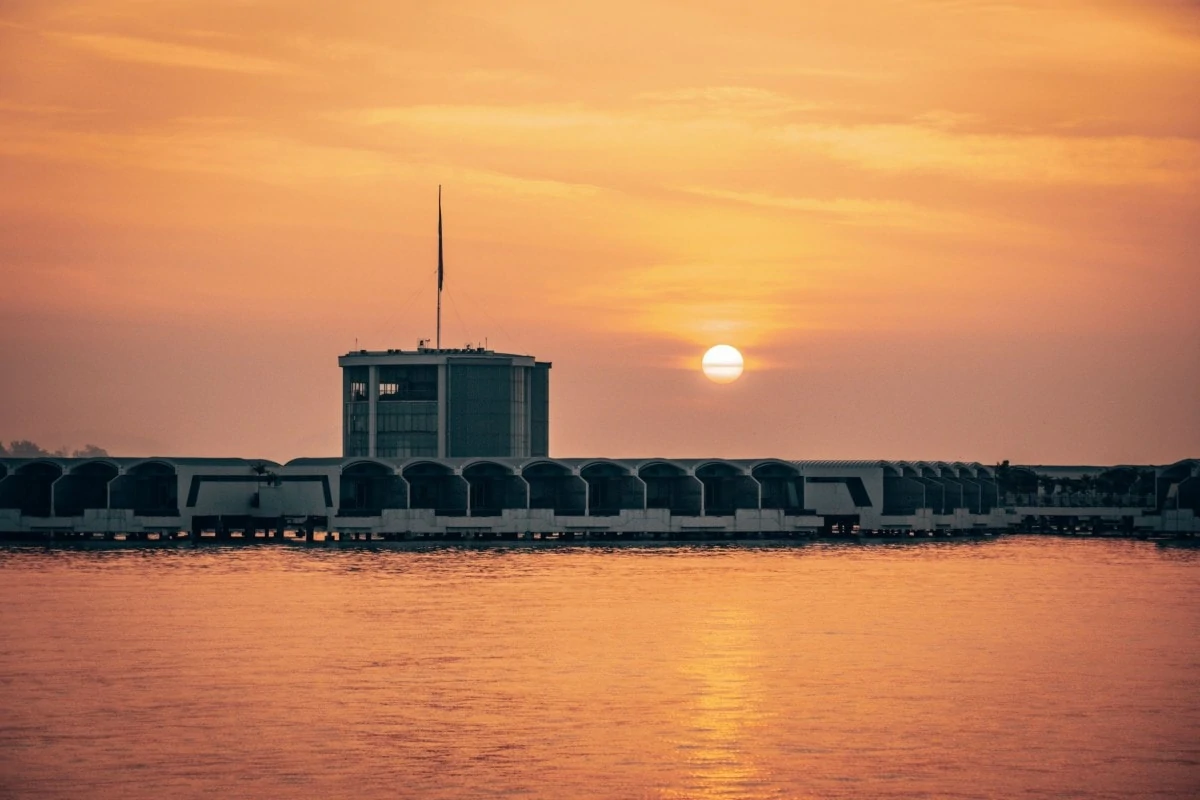
Staying at Lexis Hibiscus is an experience and really why you need to put Port Dickson on your Malaysia map.
Getting from Melaka to Port Dickson
Travel time: 90 minutes
It’s actually not the easiest to get from Melaka to Port Dickson, as at time of writing there were no direct buses. However, we’d suggest that you look into booking a Grab or private car, which should set you back around 150 MYR (34 USD/29.20 GBP).
Day 6 – Port Dickson to Kuala Lumpur
So today you’ll arrive into one of the most vibrant cities in Southeast Asia: Kuala Lumpur. A city that seems to really divide travellers, who either love it or hate it. And strangely enough at first it wasn’t for us – actually it took us a total of 4 visits on our round the world trip to move into that “love it” category. But with so much to see and do, it’s an absolute must on your Singapore and Malaysia itinerary… and luckily through our trial and error over those 4 visits, we’ve managed to work out the best things to do!
However, if you’re looking for a much more detailed KL itinerary, then check out our 2 days in Kuala Lumpur article here.
Kick it at KLCC Park
So not the longest of journeys across from Port Dickson, but after you’ve checked into your new accommodation (or just dumped your luggage there), we suggest you head out to one of the best green spaces in the city for a bit of a walk, the KLCC Park.
Open from 9am to 10pm daily, we think that this 50 acre sanctuary provides the best views of the most iconic towers in the city, the Petronas Towers. What’s more, they even have a sign-posted walk which showcases the best photo spots to get those snaps of Malaysia’s number 1 landmark.
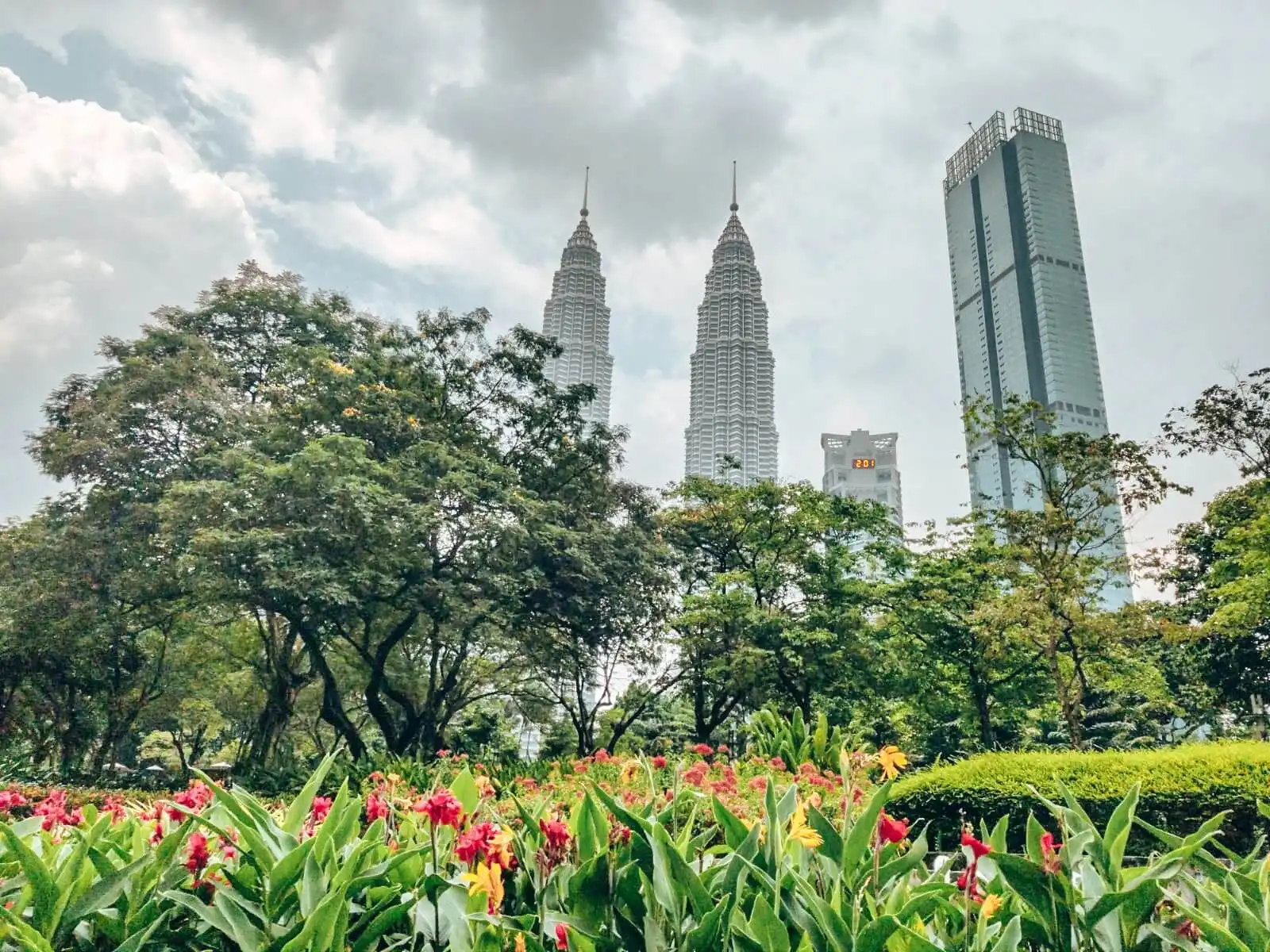
Visit the Petronas Towers
And of course, you can’t visit Kuala Lumpur without actually visiting the Petronas Towers. This twin story skyscraper soars 450m into the skyline, and is one of the best places to get the panoramic views of the sprawling metropolis.
Although it’s not the cheapest, we think that it’s well worth the cost for the experience. You’ll be whisked up to the 41st floor to the world’s highest skybridge, before continuing onto the dizzyingly high 86th level observation deck.
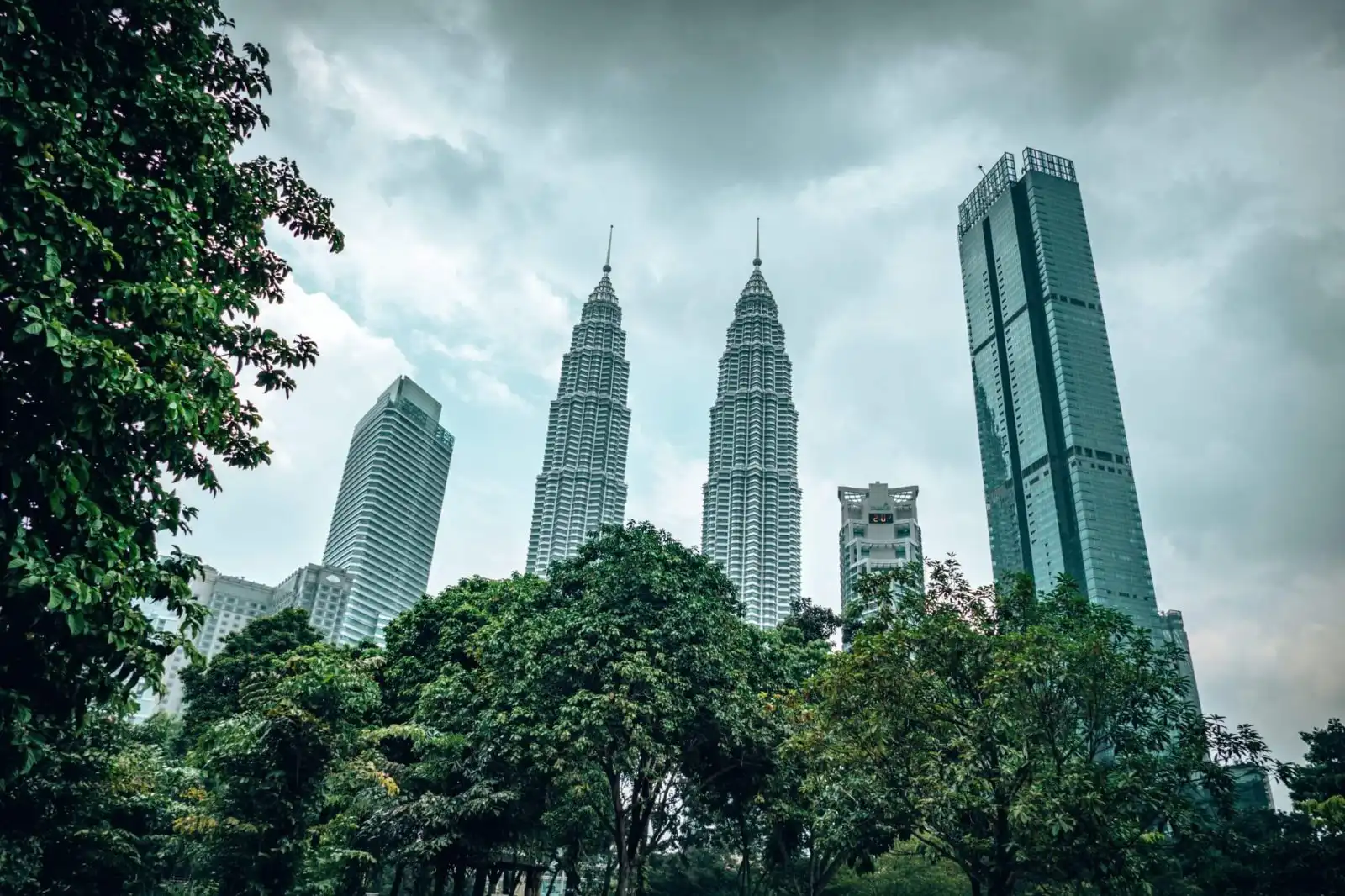
Top tip: It’s worth getting the skip the line tickets, although get them online as these can sell out.
Where to stay in KL
We found Kuala Lumpur a bit of a funny place, we visited it 4 times during our travels over the last year, and to be honest the first 3 of those we didn’t exactly love the city. Although there was some really cool stuff to do, it felt more like a city of shopping malls and construction. However, on our most recent visit, we stayed in the Chinatown area – and absolutely loved it! It’s perfectly located for many of the attractions, has a local feel to it and has some awesome street art!
Budget: If you’re on more of a budget, Rooma @ Hostels KLCC should be your choice, as it offers dorm accommodation with all the luxury of a high-end hotel. Think pool and gym facilities… not what you’d normally expect at a backpackers.
Luxury: Although there are loads of high end options in KL, we particularly liked staying at the Four Points by Sheraton right on the edge of Chinatown: Perfect location, brand new hotel with everything you need.
Getting from Port Dickson to Kuala Lumpur
Travel time: 90 minutes
Just like getting from Melaka to Port Dickson, from Port Dickson to Kuala Lumpur is also not the easiest on public transport. So we’d again suggest looking to book a private car or taking a Grab, which should set you back in the region of 150 MYR (34 USD/X29.20 GBP).
Day 7 – Kuala Lumpur
Visit Thean Hou Temple
We suggest you get up early and make your way to the stunning Thean Hou Temple. This very instagrammable temple is one of the oldest and largest in South East Asia and the fire-engine red detailing and many splendoured tiers are a must-see on your Singapore Malaysia itinerary. Dedicated to the Chinese Sea Goddess, Mazu, this temple is beautiful to behold but also has spectacular views of the city, as its set high atop the Robson Hill.
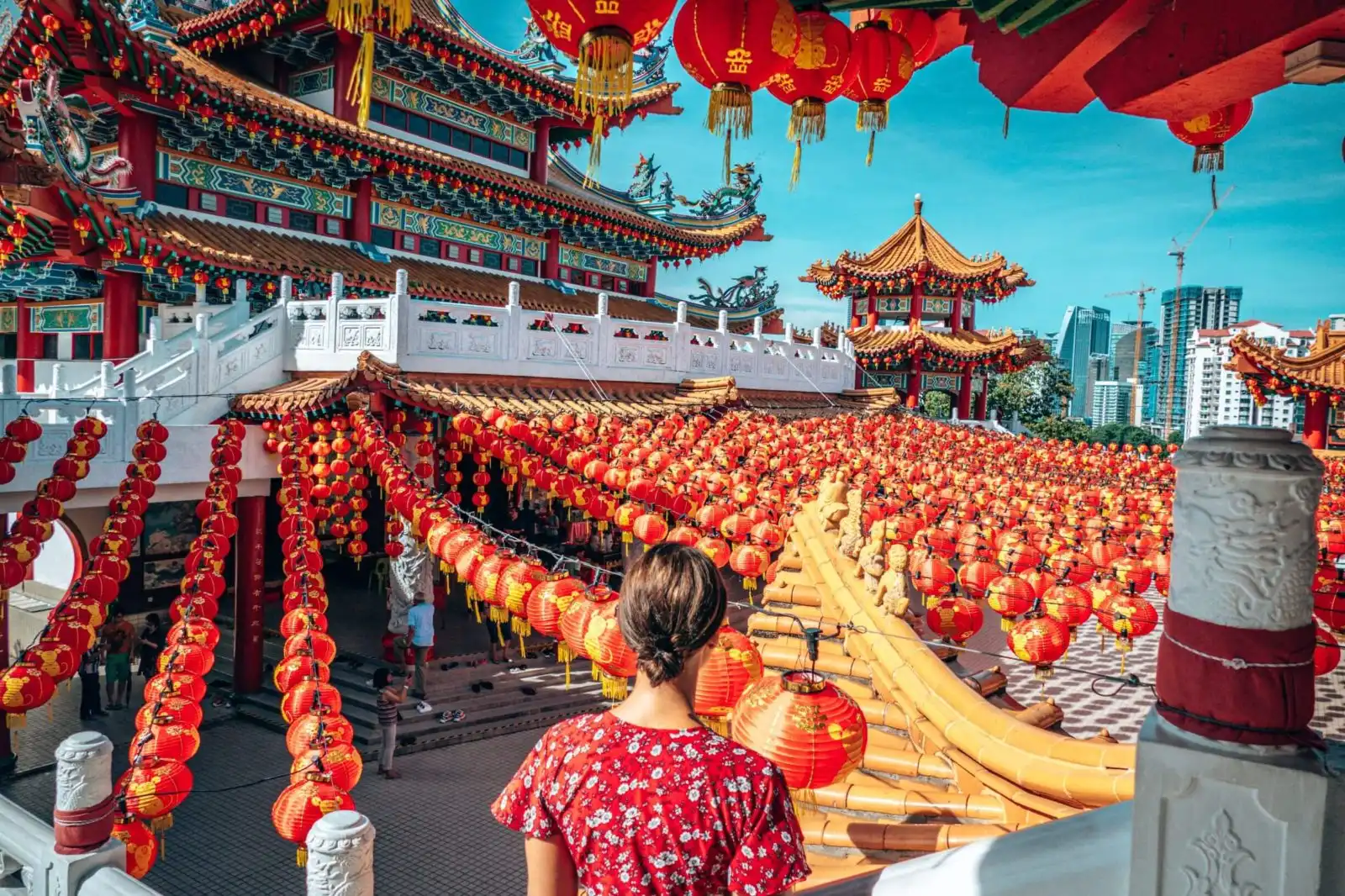
Try to get there when it opens at 9.00am to beat the bigger tour busses.
Take the walkways at KL Eco Forest Park
Once you’ve got your temple fix, we suggest you head to the suspended walkways and hanging bridges of the KL Eco Forest Park. Actually this park has a history stretching back to 1906, when the Bukit Nanas Forest Reserve was identified as a heritage area full of tropical rainforest. The Eco Park is one of the larger remaining green spaces in the city and it’s great to spend an hour or two on the walkways. Our favourite part was the Canopy Walk, which is a massive steel and wooden aerial bridge through the trees. Keep in mind that if you’re afraid of heights, this might be something you want to skip, or challenge yourself to!
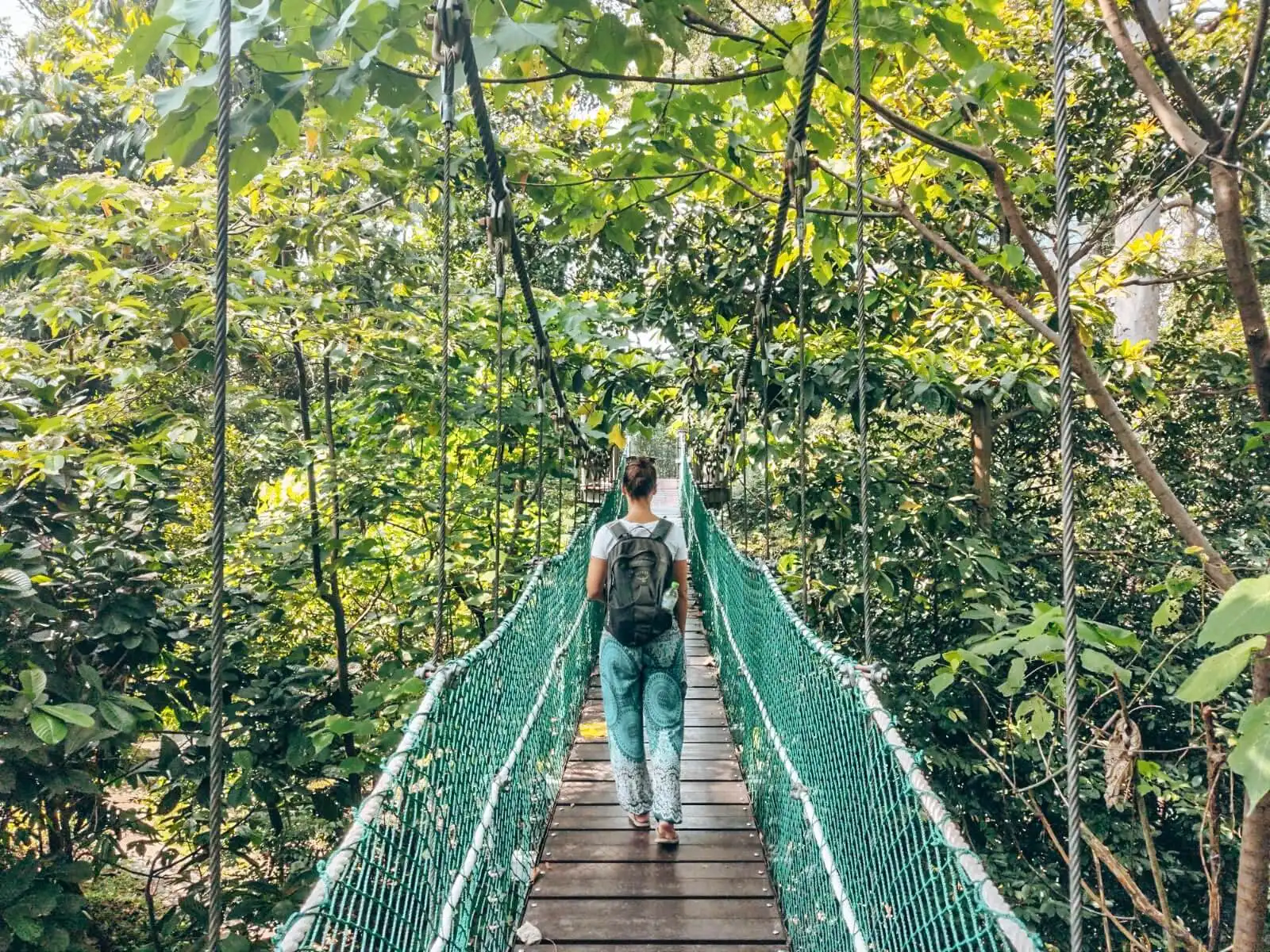
Insider Tip: Make sure you use the Lower Hill Main entrance, not the one by the MRT Station, to avoid some deserted, muddy trails.
Go up the Menara KL Tower
You can see it from the Eco Park and it’s worth a quick stop on your way out: the Menara Tower, also known as the KL Tower. This skyscraper, rising an impressive 450 metres from the ground, is one of the world’s tallest telecommunications towers. You can go up to 276m to the observation deck to see the entire glittering city laid out before you.
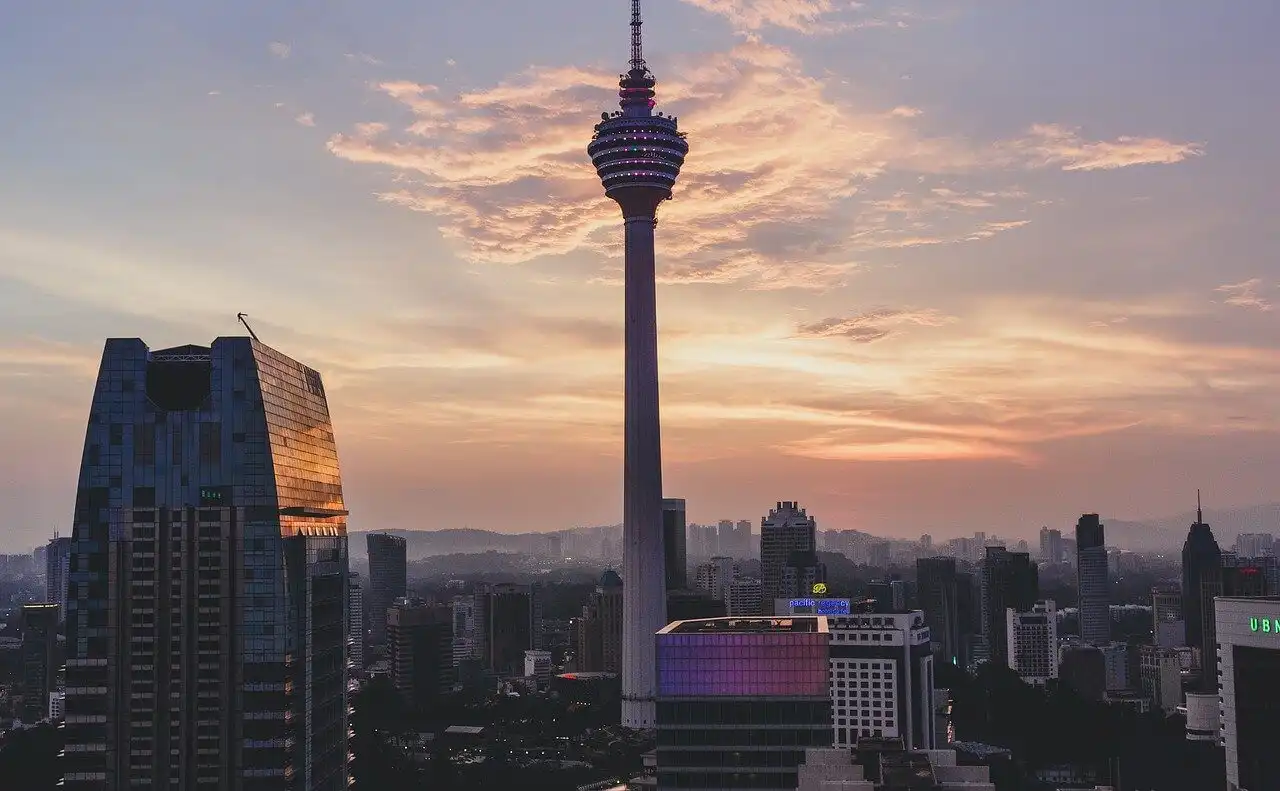
Eat street food
Now we mentioned earlier that Malaysia is world-renowned for its food, and you must head to a night market (or two) to try the many foods on offer. You have to try dishes including char kway teow (flat rice noodles with shrimp, Chinese sausage and eggs), oyster omelettes, nasi kandar (of course) and the many pandan and coconut based sweets.
There are many markets to consider – from the famous one at Jalan Alor which, although a little touristy, still has all the key dishes on offer. Or Taman Connaught, a night market running on Wednesdays, Hutong 10 which is in the basement of Lot 10 shopping centre.
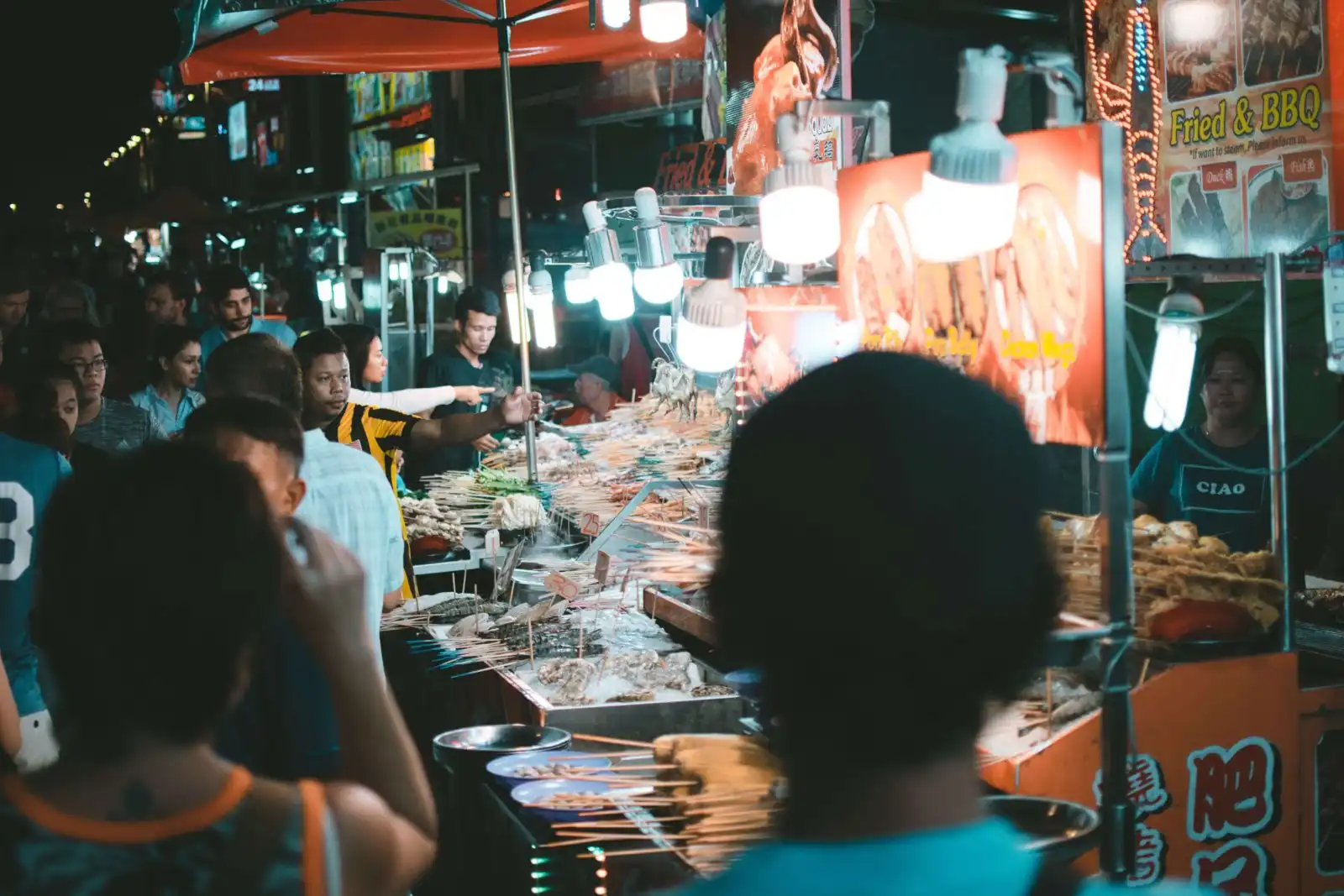
Check out Chinatown, one of our favourite areas in all of Kuala Lumpur, for hawker stalls there. While you’re there, we recommend you have a drink at the trendy Concubine Bar which not only has amazing cocktails but the surrounding streets are filled with incredible street art. You can also pop into the popular Petaling Street, a large pedestrianized area full of souvenir and clothing stores, or visit the Sri Mahamariamman Temple, the largest and oldest Hindu temple in the city.
Day 8 – Kuala Lumpur
Head out to the Batu Caves
Another one best enjoyed early is the Batu Caves also known as the Sri Subramanair Swamy Temple. This must be one of the most famous landmarks in Malaysia, with 272 brightly-coloured steps of red, yellow, orange, blue and green leading up to the main cave temples. The temples are set within limestone caves dating back around 400 million years, and beyond taking photos on the colourful steps, you can wander the halls of the Cathedral Cave (also known as Temple Cave) at the top of the stairs, or visit two at the bottom – the Art Gallery and Museum Cave.
The temple complex also boasts a 43 metre tall golden statue of Lord Murugan, the Hindu god of war. Constructed in 2006, it’s the largest in the world and makes for a great photo of the caves, statue and cityscape.
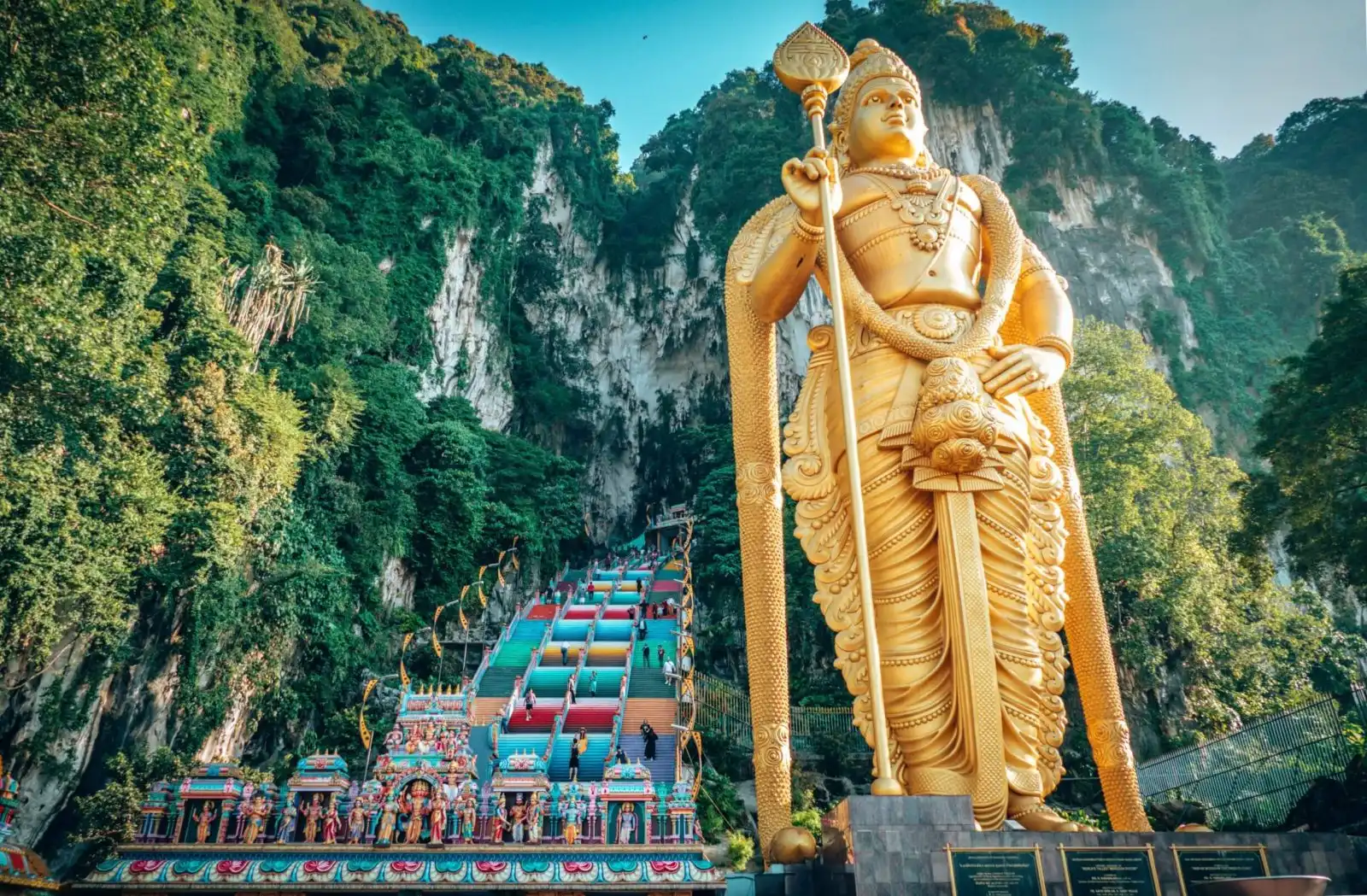
Insider Tip: It’s best to just hail a Grab, especially if going early (it opens at 06.00am, but you can take a train from the KL Sentral Station for 2.60 MYR (0.60 USD/0.50 GBP) each way. We’ve done both, and found them equally convenient; both take between 20 and 30 minutes to get there. Keep in mind that most of our itinerary for today is walking, so a Grab might be the best thing to rest your legs!
See the Sultan Abdul Samad Building
Once you’re done with the Batu Caves, head back into the city and take a walk around the area adjacent to Chinatown, to see some of the beautiful historic buildings, first up by the Sultan Abdul Samal Building. Set on Merdeka Square this gorgeous façade is part of the city’s ‘Colonial Core’, a network of buildings from earlier times that stand out against all the steel skyscrapers surrounding them.
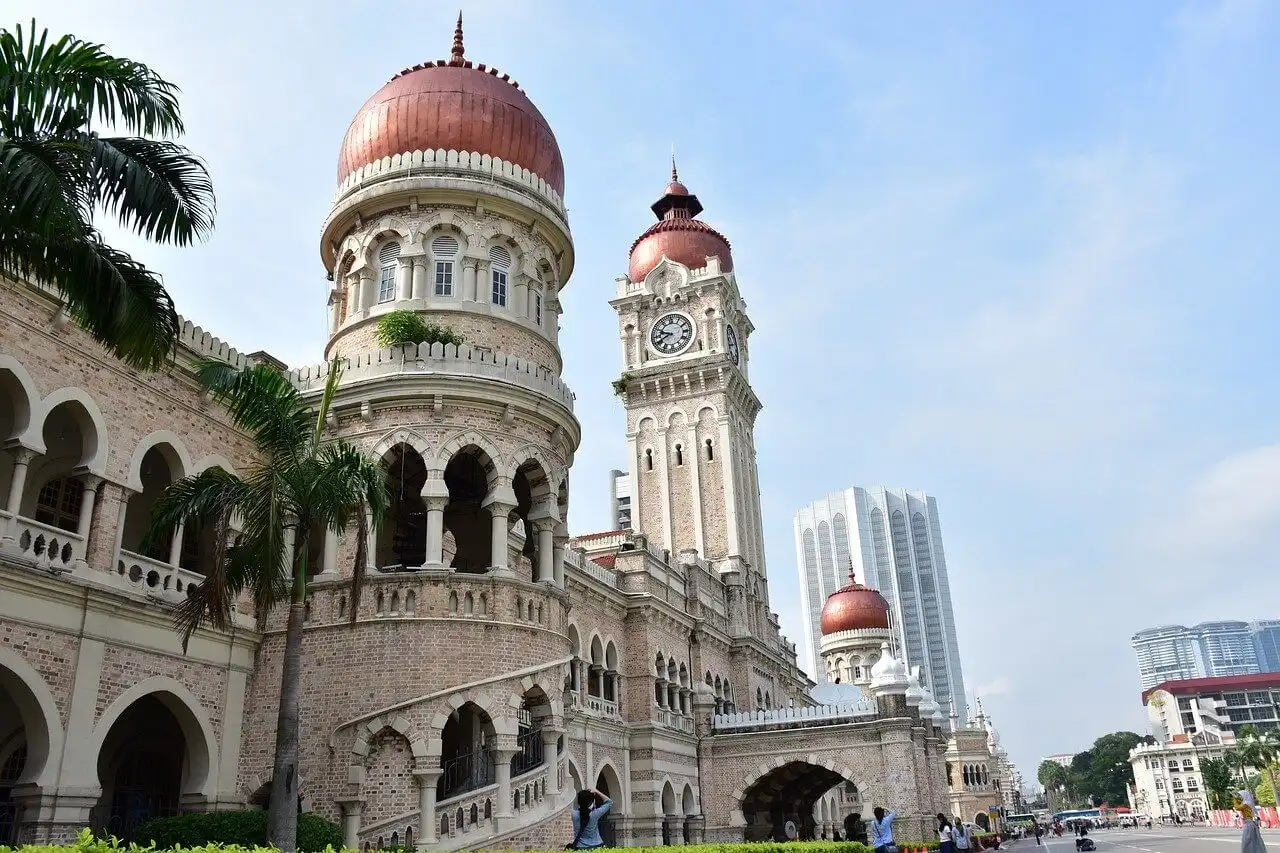
Take a photo at Jamek Mosque
It’s one of the most iconic buildings in the city, the Sultan Abdul Samad Jamek Mosque (also known as the ‘Jamek Mosque’ or the Friday Mosque because it hosts the special Friday noon prayers, jumu’ah). Constructed in 1907, the mosque was the primary place of worship until the National Mosque was built. If you want to move things around on this itinerary, you could also visit the Mosque at dusk – its beautifully lit as the sun goes down.
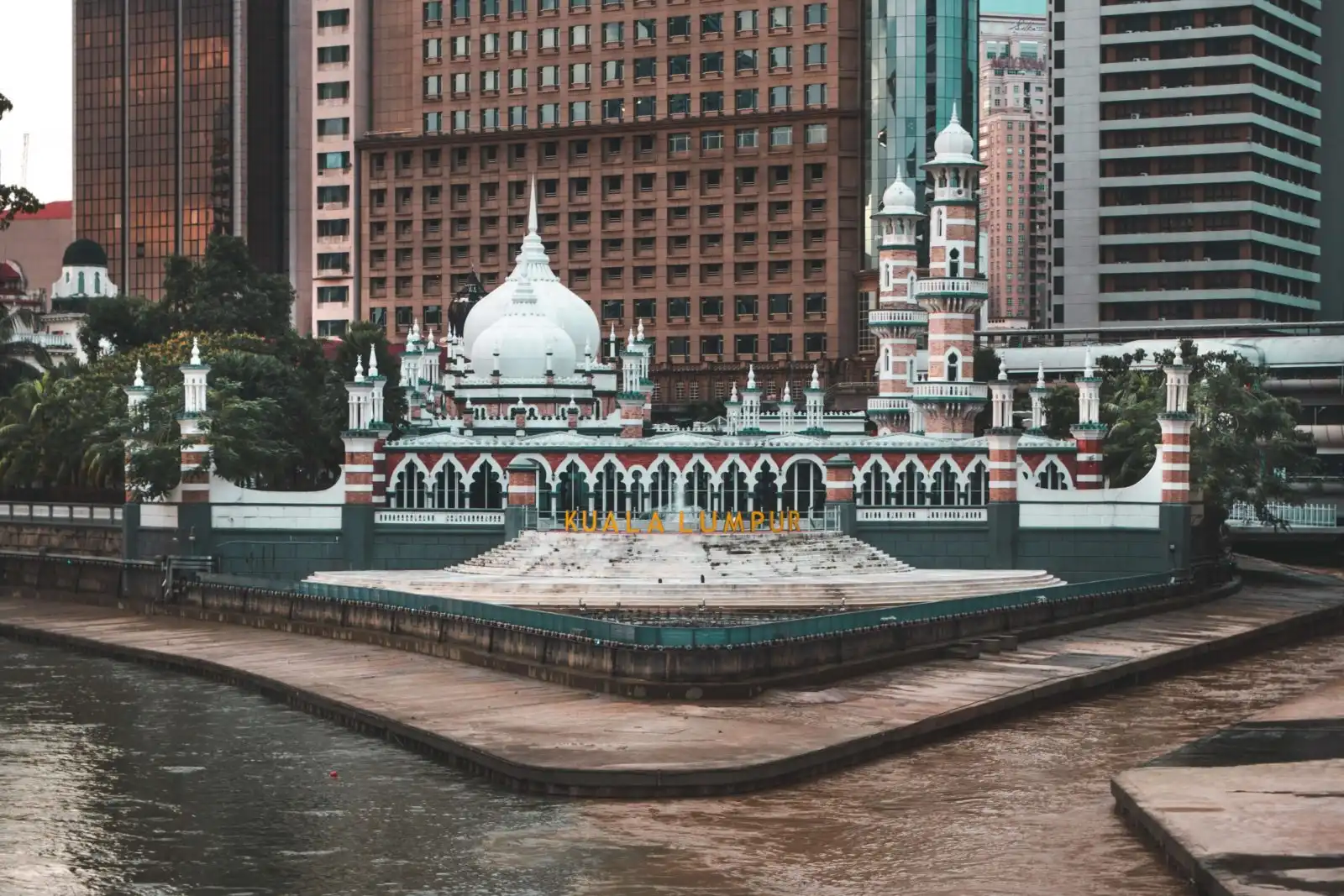
Walk around the Masjid Negara Mosque
Speaking of the National Mosque of Malaysia, take a 15 minute walk to see it for yourself. This is the country’s ‘seat’ of the Muslim faith and is considering the ‘Mecca’ of Malaysia. Housing up to 15, 000 for prayers, this beautiful mosque is in the shape of a star made up of 18 points, 13 of which represent Malaysia’s states and 5 for the pillars of Islam. Beautiful from afar it’s even better from within: remarkable colours, verses from the Koran etched on the walls and amazing iron lattices. Keep in mind that you can only visit when prayers are not in progress and you have to be appropriately dressed: long trousers and shirts, although they do have robes and headscarves you can lend.
Explore the National Museum of Malaysia
Take a wander down Damansara Street (Jalan Damansara) to Muzium Negara, the National Museum. It features the history of the country and overview of Malaysian life including craft, music and traditions. There is a huge area dedicated to the animals of the country, ritual weddings and a fascinating section called ‘wayang kulit’, which is like a wooden puppet theatre.
Insider Tip: They do free guided tours at 11.00am on Tuesdays, Thursdays and Saturdays (English only).
Bonus things to do in KL
We love Kuala Lumpur and there is so much to do in this captivating city. So, in case you didn’t like anything we’ve suggested, here are a few more ideas to add or swap:
Perdana Botanical Gardens
Near the colonial buildings is the expansive area of the Perdana Botanical Gardens (also known as the Lake Gardens). It’s part of a larger park which is over 227 acres, but the 93 acres of Perdana is probably enough to satisfy your appetite for flora and gardens. Make like the locals and wander the many manicured gardens including the gigantic Orchid Garden which 800 species of that flower, or the Hibiscus Garden, a homage to the national flower of Malaysia.
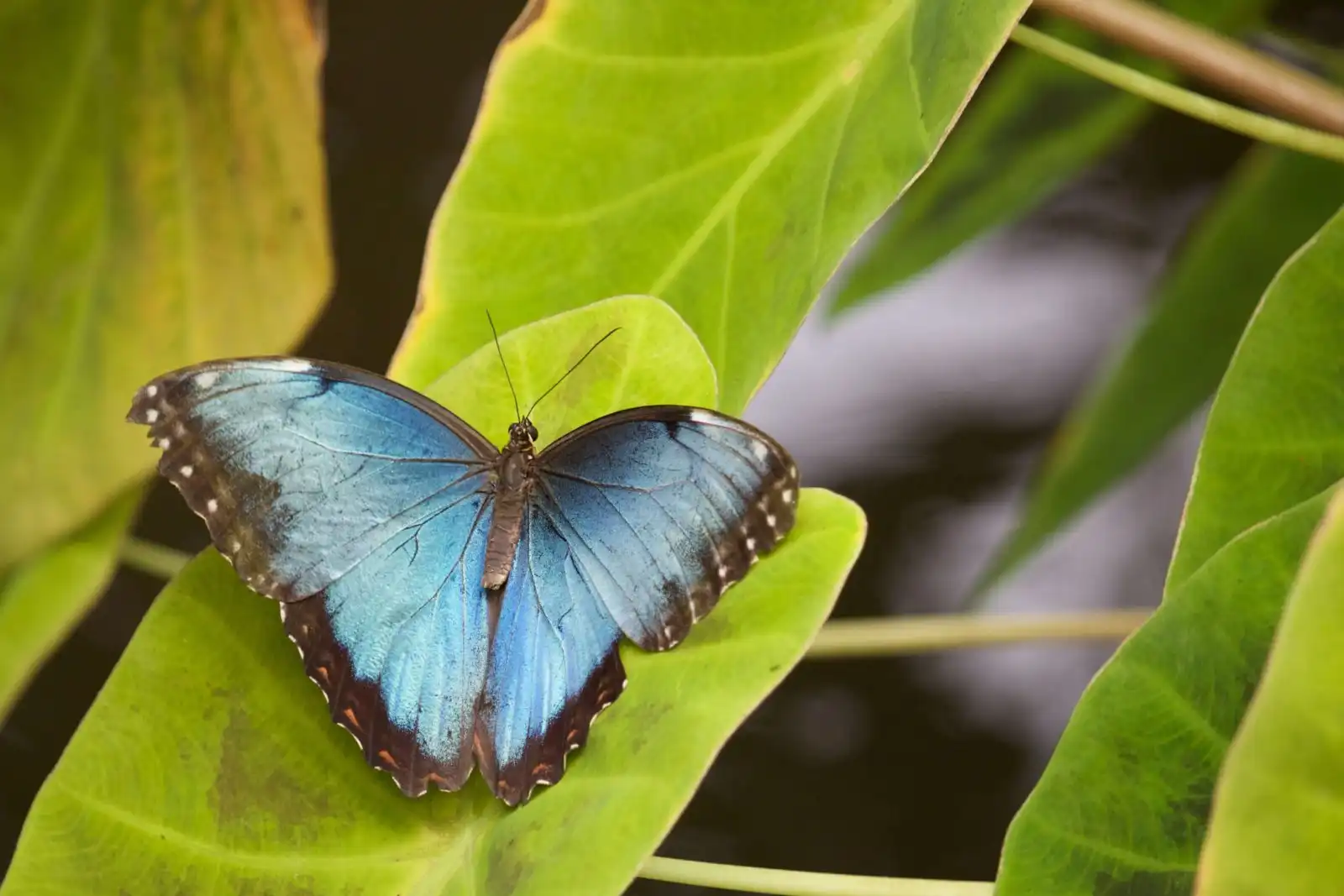
Either within or near the gardens are some other great places to consider visiting including the Kuala Lumpur Butterfly Park (one of the largest in the world), the ASEAN Sculpture Garden and Islamic Arts Museum.
Highly recommended is the KL Bird Park with over 3,000 birds and some fantastic breeding programs for African Greys and the Malay peacock.
Insider Tip: The Bird Park has free shows at 12.30pm and 3.30pm daily, plus eagle feeding at 2.30pm each day. Opening hours: 9.00am – 6.00pm daily.
Go shopping at Berjaya Time Square
Now, listen: Kuala Lumpur loves a shopping mall and you are spoilt for choice. We love Pavilion and KLCC (Suria), but if you have kids or want a bit of fun, then Berjaya Times Square is the place. It’s one of the first large malls in the city and while it’s a little weathered, it has a huge bowling alley and… wait for it… an indoor rollercoaster! Even if you don’t buy a ticket to ride this 800m rollercoaster its still worth going to see it, as the ground shakes beneath you as it turns circles around the central atrium.
Central Market
While we’re on the topic of shopping, if you want some handicrafts or souvenirs, you can also head to the Central Market (also known as Pasar Seni). We didn’t love it (we preferred Petaling Street), but this building dates back from 1928 and is one of the original shopping spots in the city. You can also try one of the hawker food stalls and get yourself some putu bamboo (pandan cakes steamed in bamboo pipes) or ais kacang, a local delicacy made of shaved ice, jelly, sweetcorn and red beans.
Day 9 – Kuala Lumpur to Ipoh
It’s time to leave city life for a place that’s a little more off the beaten track, the small but spectacular town of Ipoh. Ipoh is actually one of our favourite places to visit in Malaysia, since you won’t find droves of tourists but you will find delectable white coffee, stunning street art and so many temples you’ll have to prioritize which ones to see!
Note: We’d recommend you head off from Kuala Lumpur at around 9.00am, so once you’ve arrived in Ipoh you still have time to explore the city in the afternoon.
Do the Heritage Walk
Now Ipoh used to be a slightly sleepy village but when the tin mining industry exploded in the late 80’s, many miners flocked to the city along with foreign expats and migrants. This boom period saw many beautiful colonial buildings constructed in the town, which are best explored on foot, with a self-guided walking tour! You can pick up a physical leaflet at the Tourist Information Centre on Jalan Tun Sambanthan or there is an electronic version here.
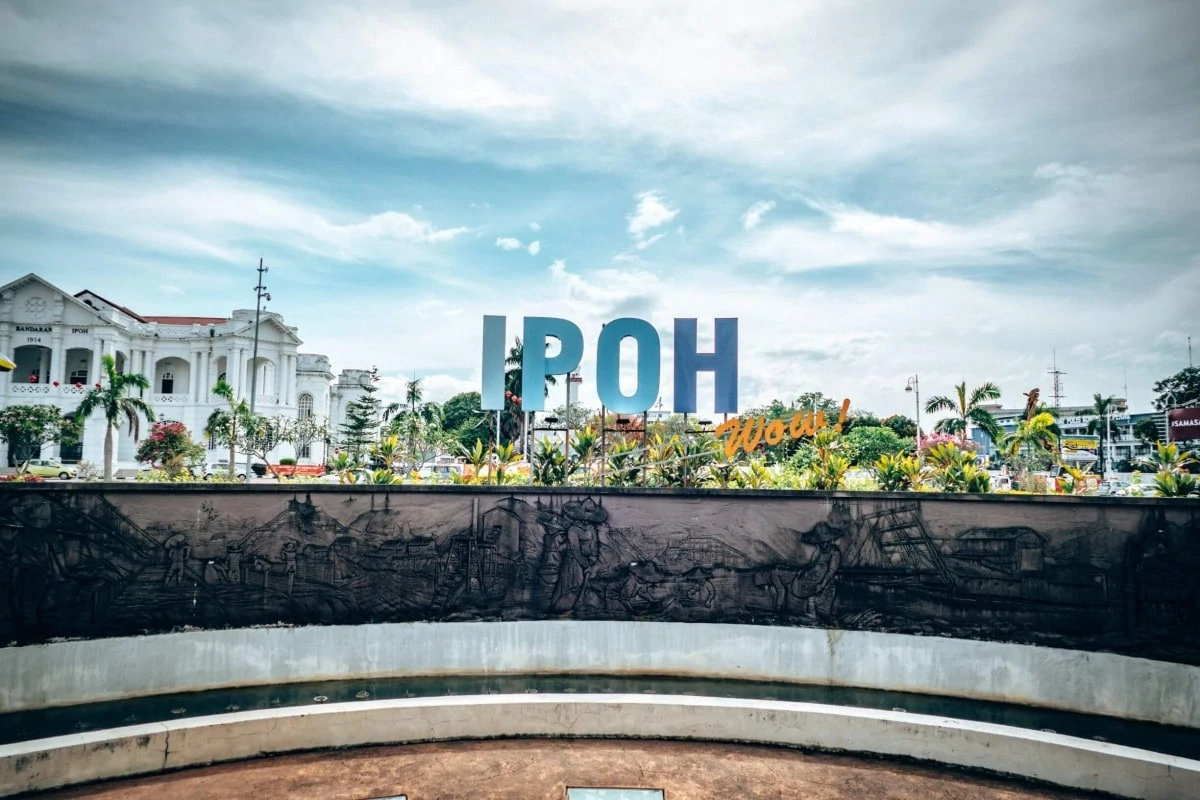
The entire stretch is 4 miles (6.4 km) but you can obviously select to do a shorter route, depending on your fitness and energy. The trail usually starts at the old Railway Station, constructed in 1917 (the architect AB Hubback also built Kuala Lumpur’s station), and highlights usually include the Post Office, Town Hall, Chartered Bank, St John’s Church and the Padang Mosque.
Where to stay in Ipoh
Budget: Our vote goes to the Brownstone Hostel . Yes it’s a 15 minute walk to the Old Town but this is a wonderful, modern hostel with good showers and a nice courtyard. We took a private room which was very comfortable and quite large.
Mid-range: Best of the bunch is The Tudor Hotel. Think plush furnishing, lovely rooms and a world-class breakfast at prices that won’t break the bank.
Luxury: The Haven Resort is the leading hotel in Ipoh. It’s definitely out of town but you’ll be surrounded by incredible mountains and landscapes with luxurious suites and a five tiered swimming pool to boot!
Getting from Kuala Lumpur to Ipoh
Travel time: 2 hours, 20 minutes
Self-drive: Conveniently situated on the AH2 highway, Ipoh is about two hours from Kuala Lumpur.
Train: There are some direct trains each day connecting Ipoh to Kuala Lumpur and George Town, with the journey taking about 2 hours 30 minutes. Check out the timetables on the official KTM website.
Bus: There are a few good bus options connecting you to Ipoh and taking around three hours. We used a local operator, Sri Maju, many times in Malaysia and while the busses aren’t luxurious they are clean, comfortable and quick (while safe). We booked our tickets on 12go.asia – check out the latest prices here.
Day 10 – Ipoh
Check out the temples
Ipoh has a number of beautiful temples, particularly cave temples etched into the limestone hills, to explore. We’d suggest you start off with the most impressive of them all: Kek Lok Tong, the Cave of Ultimate Bliss. This spacious cavernous cave is full of relics to see but also has a spectacular lake out the back, where you’ll see locals doing their morning jog. Actually we met a friendly jogger while there who ended up giving us a free tour of the temples in the area!
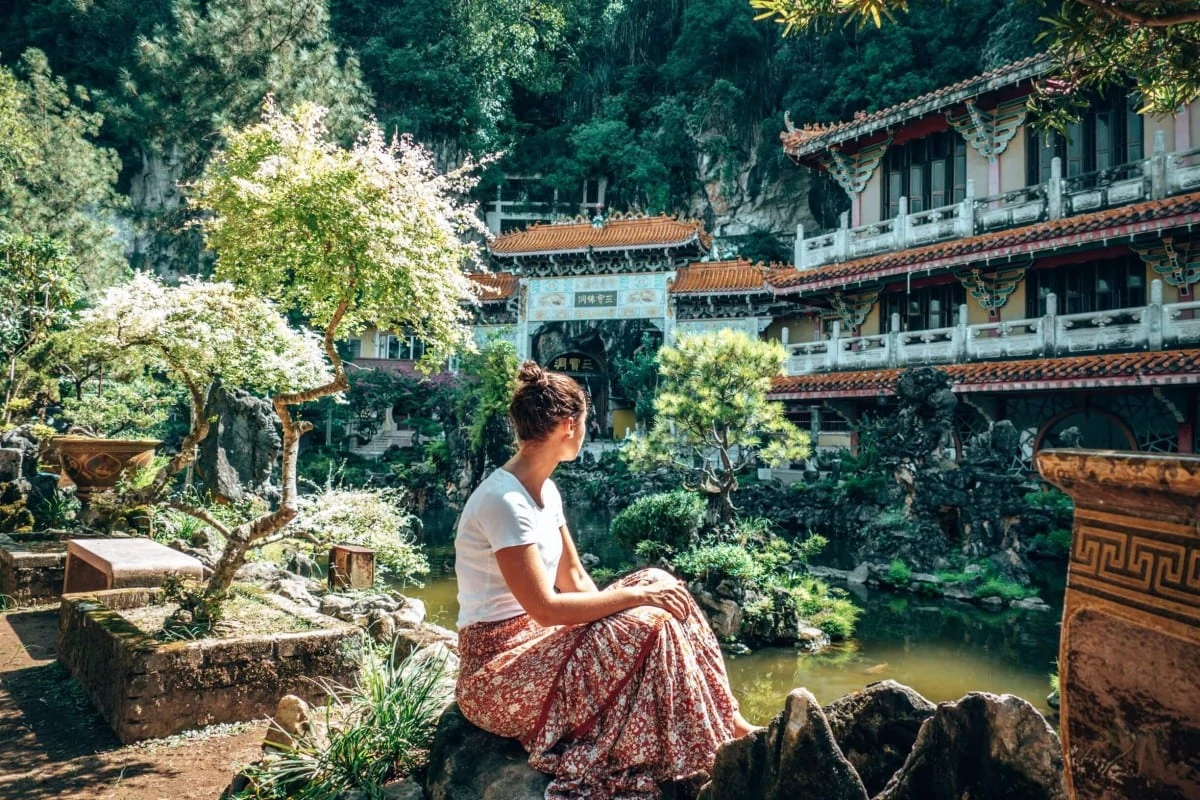
Next up its worth going around the corner (you can take a Grab if you don’t have a car) to Sam Poh Tong Cave Temple, the oldest of the temples in Ipoh. This temple has a really impressive archway with gorgeous marble carvings of dragons, plus a wonderful cool garden full of sculptures, perfect for a few photographs. There is also a tortoise ‘sanctuary’ out the back which, to be honest, we hated – you can buy cherry tomatoes at the entrance of the cave to feed them but we found the whole thing pretty inhumane.
Last up in that area is the Ling Sen Tong Temple, which is a stone’s throw from Sam Poh Tong and at the end of the side road anyway, so worth a visit. This is a brightly-hued Taoist temple with some interesting ‘creatures’ in the courtyard.
If you have the time, you could also add two of the other cave temples to your list: Perak Tong Cave and Kwan Yin Tong Temple. These two are a little further afield but if you love temples, worth adding to your list.
Drink white coffee
All over Malaysia you’ll find stores selling ‘white coffee’, a uniquely Malaysian coffee made with roasted palm oil and condensed milk. This delicious coffee originates from Ipoh although there seems to be a tussle between some of the coffee shops, who all claim to have invented this yummy brew. Either way, you can’t go to Ipoh and not drink white coffee.
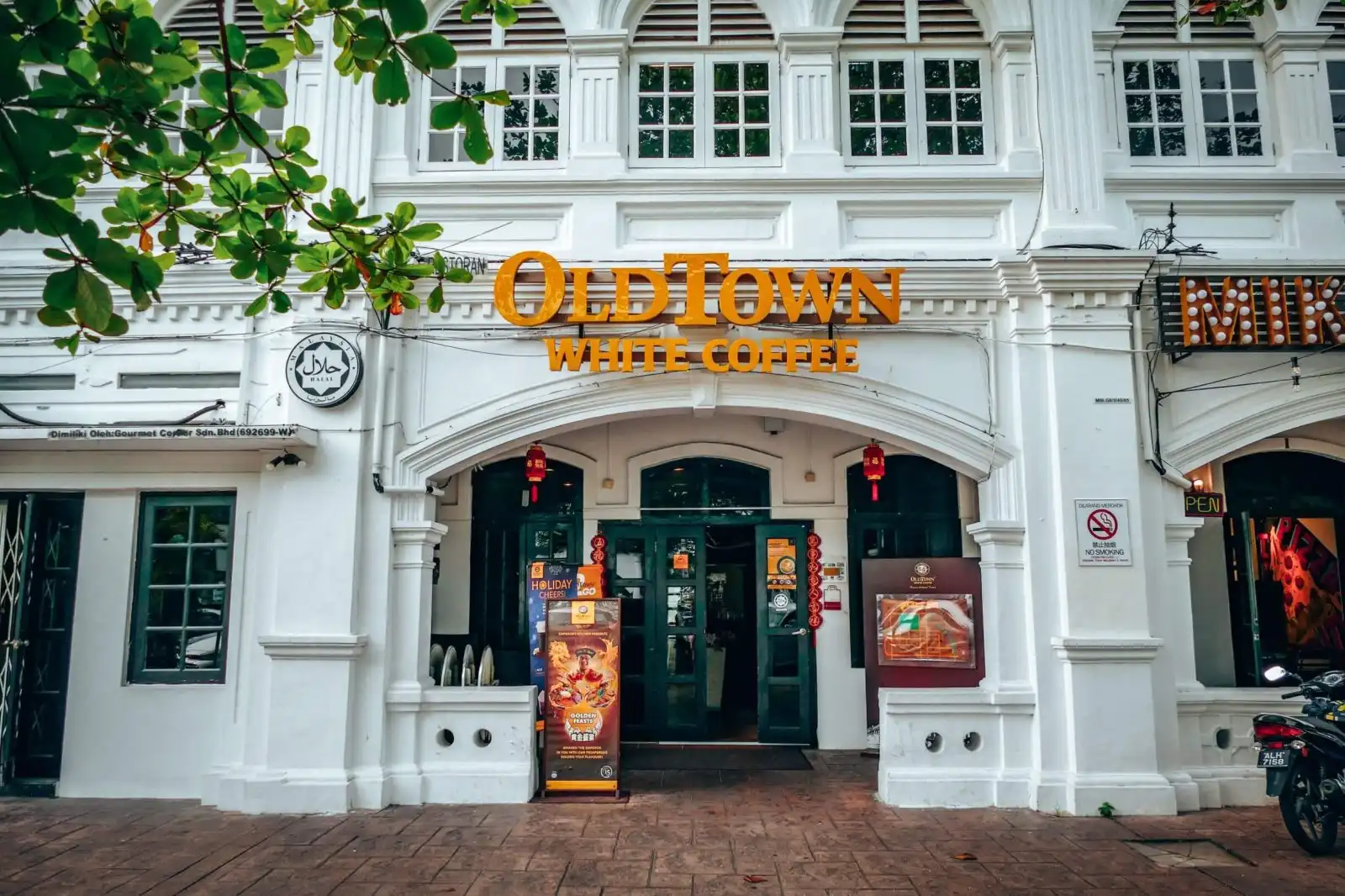
Our suggestion? Go to Nam Heong. One of the ‘alleged’ inventors, Nam Heong is a vibrant little store filled with locals not just drinking coffee but munching on egg tarts and slurping up their flat noodles. It’s busy, it’s hot but its an absolute must!
Explore the street art
Now this Malaysia itinerary includes quite a bit of street art, particularly in Penang, but that’s since the country has some of the most dynamite graffiti in the world. We preferred the street art of Ipoh over Penang/George Town since it just felt so much quieter and more ‘relaxed’, we hardly encountered anyone seeking out the art.
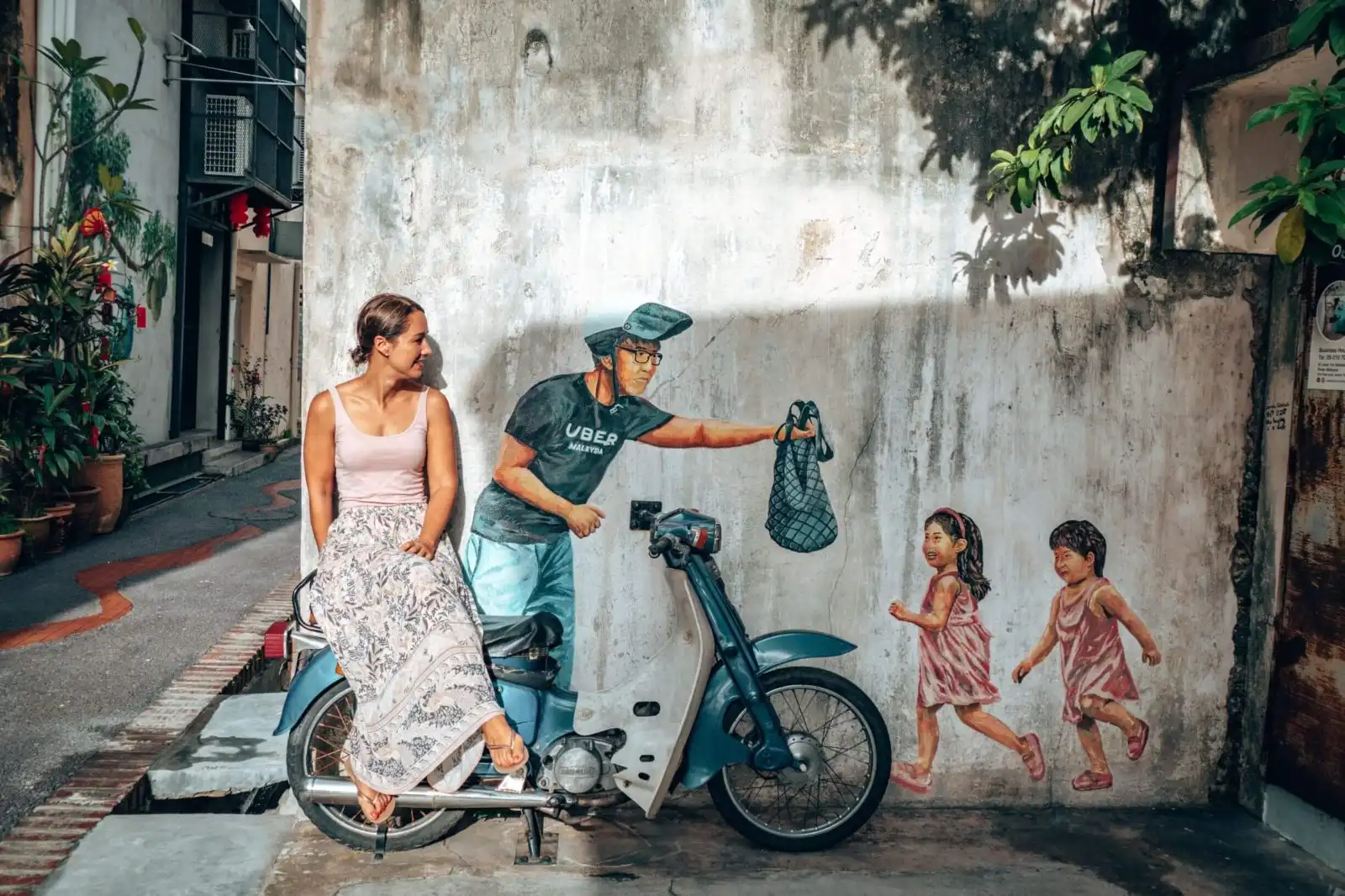
We’ve got an entire Guide to Ipoh’s Street art but, in short, you can find acclaimed pieces by artist Ernest Zacharevic dotted around the city, most of it focussed on depicting scenes linked to the city’s signature white coffee. The street art created by Zacharevic is more stencil or spray based ‘interactive’ pieces which fuse the art with real-world elements like ‘Trishaw’, his work which has a real-life rickshaw set against the backdrop of a local man collecting garbage.
There is a selection of other works (you can find them in the Google map on our article linked above), plus a large lane, the Mural Arts Lane, which is jammed with magnificent murals.
Day 11 – Ipoh to Penang
Now if you loved the street art and food of Ipoh, you’ll probably enjoy the pace of its larger ‘cousin’, Penang. Penang is actually not a city but a region (and an island), with most travellers heading to George Town, the main city. We definitely suggest you base yourself out of George Town, as most of the key attractions on the island are there. Like your departure from Ipoh, we recommend you leave in the late morning so that you can pack in a few activities…
Walk the Heritage Trail
Sound familiar? Like Ipoh, George Town has some marvellous colonial buildings to behold. There isn’t a walking map but you can try to just head around the city to check out major sights including St George’s Church, the Clock Tower, City Hall and Town Hall.
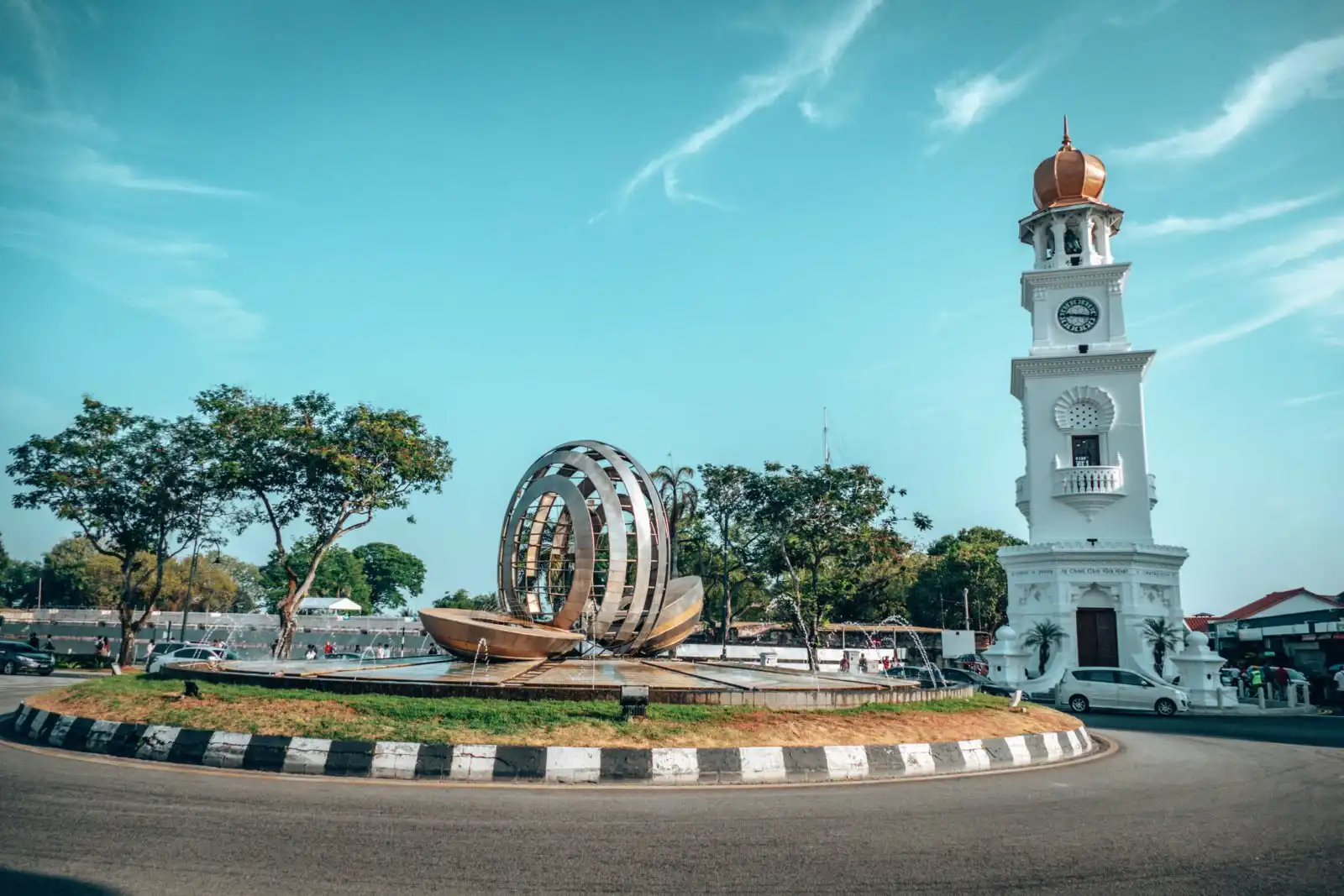
Insider Tip: Fort Cornwallis is usually included on lists of colonial sites in George Town but we’d recommend skipping this attraction – it just doesn’t seem worth the entry fee.
Visit the temples
Similarly, George Town has some amazing religious sites. Head out of the city confines to the legendary Kek Lok Si Temple. Located near Penang Hill, this is the largest Buddhist temple in all of Malaysia including temples, gorgeous gardens, a pavilion and a gigantic statue of Kuan Yin, the Goddess of Mercy.
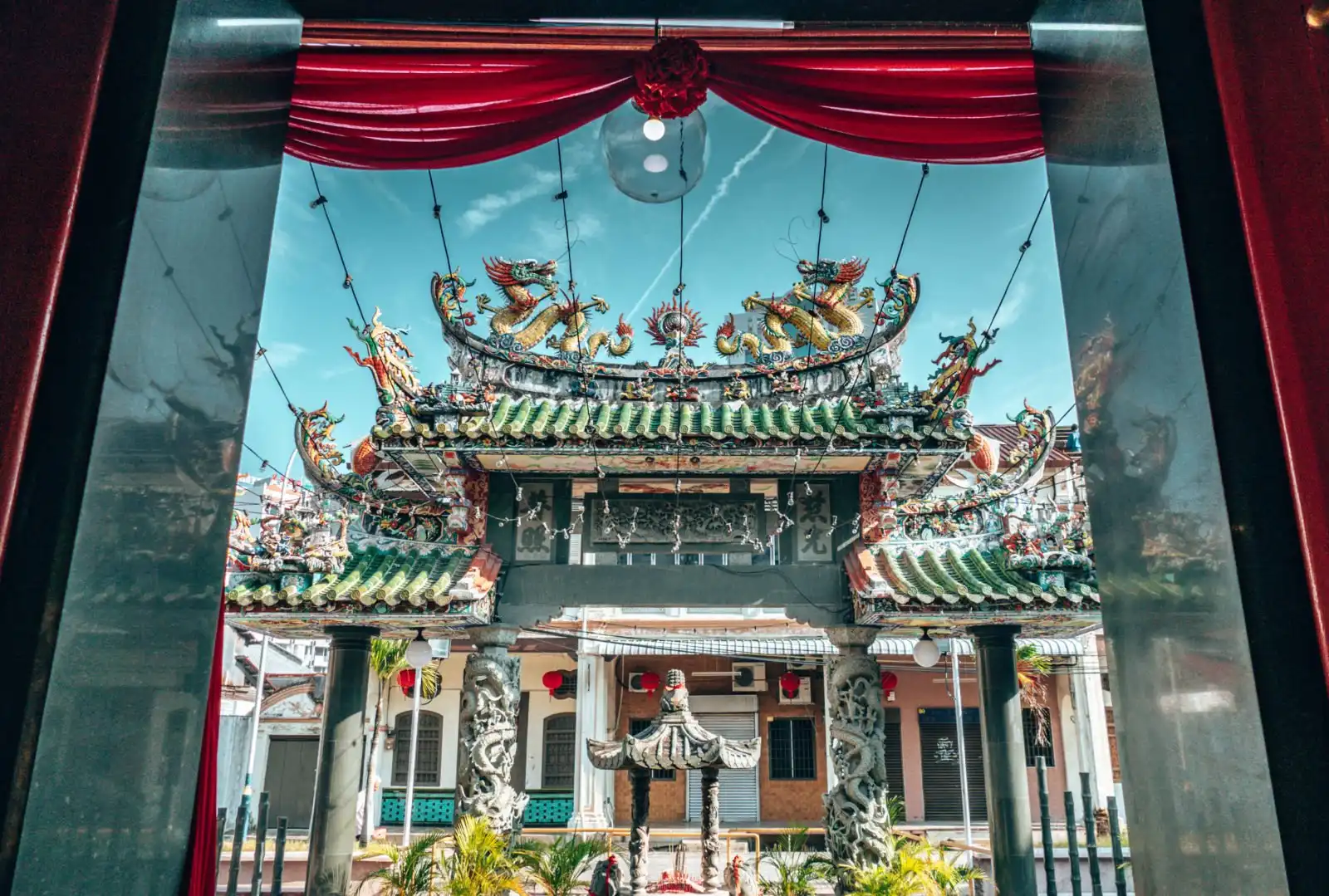
Alternatively, you can walk around the city itself to see Kapitan Keling Mosque, or Khoo Kongsi, or even the Sri Mahamariamman Temple.
Where to stay in Penang
Luxury: A stone’s throw from Fort Cornwallis and situated ideally in the city centre is the Royale Chulan Penang Hotel. We loved this hotel – great breakfast, fantastic gym and a central pool with heaps of loungers. You can even see the sunrise from some of the harbour-facing rooms!
Mid-range: The beautifully curated minimalist Areca Hotel is in a historic building where every room has a different theme. That alongside the lovely onsite restaurant makes this a fabulous mid-range option in Penang.
Budget: We like The Spices Hotel. It’s not a backpackers but rather a budget hotel that is in a prime position, right in the heart of the street mural area. This cosy property has all the basics – wifi, aircon – and a lovely common area to find likeminded travellers.
Getting from Ipoh to Penang
Car: It’s about 160 kilometres between Ipoh and George Town, taking just over two hours via road.
Bus: One of the easiest ways to get between the two points is via bus and there are about 8 time options per day. Taking about 2 and a half hours, the busses usually end in Butterworth, which means you’ll need to take a local bus or a Grab taxi to your final destination in George Town.
Check out the latest prices in Bookaway here.
Train: KTM also runs trains from Ipoh to Butterworth. It’s more expensive than taking the bus but takes under 2 hours so is slightly speedier.
Day 12 – Penang
Explore the street art
In case you didn’t get enough of a street art fix, then you’re in luck: George Town is one of the world’s leading cities for graffiti and murals, so a must for your Penang itinerary! The Penang street art trend started back in 2008 when the town was listed as a World Heritage site and a number of cartoon steel sculptures were put on the walls of historic buildings. Local inhabitants embraced this new wall art and later, in 2012, artist Ernest Zacharevic came to town and created six pieces, named ‘Mirrors’ for the George Town festival.
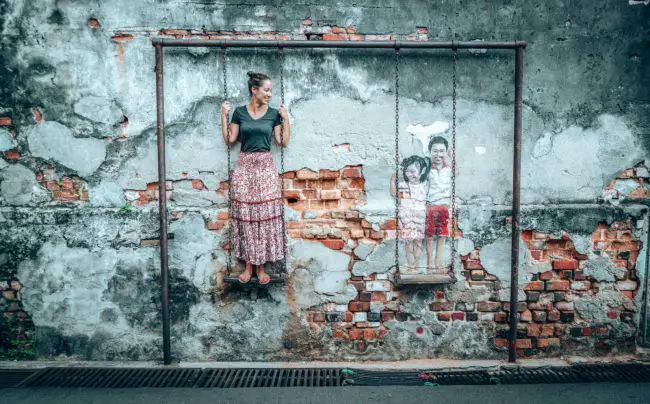
This series spurned an entire trend as many local and international artists have produced pieces throughout the city. There are literally hundreds of pieces and, if you’re interested in finding out more, we’ve created a full interactive map in our article: Street Art in Penang.
Penang Hill and the Habitat
Most guides you’ll see for Penang will suggest you head up Penang Hill for the views, via the funicular. And, while its cheap – only 30 MYR (7.30 USD/5.60 GBP) per person – we were a little underwhelmed by the activities atop the hill. However, what we do recommend is that if you go up Penang Hill, you make your way to The Habitat. This conservation project showcases the natural rainforest of Malaysia through a unique treetop walk experience. Definitely budget enough time to do the 90 minute guided trail.
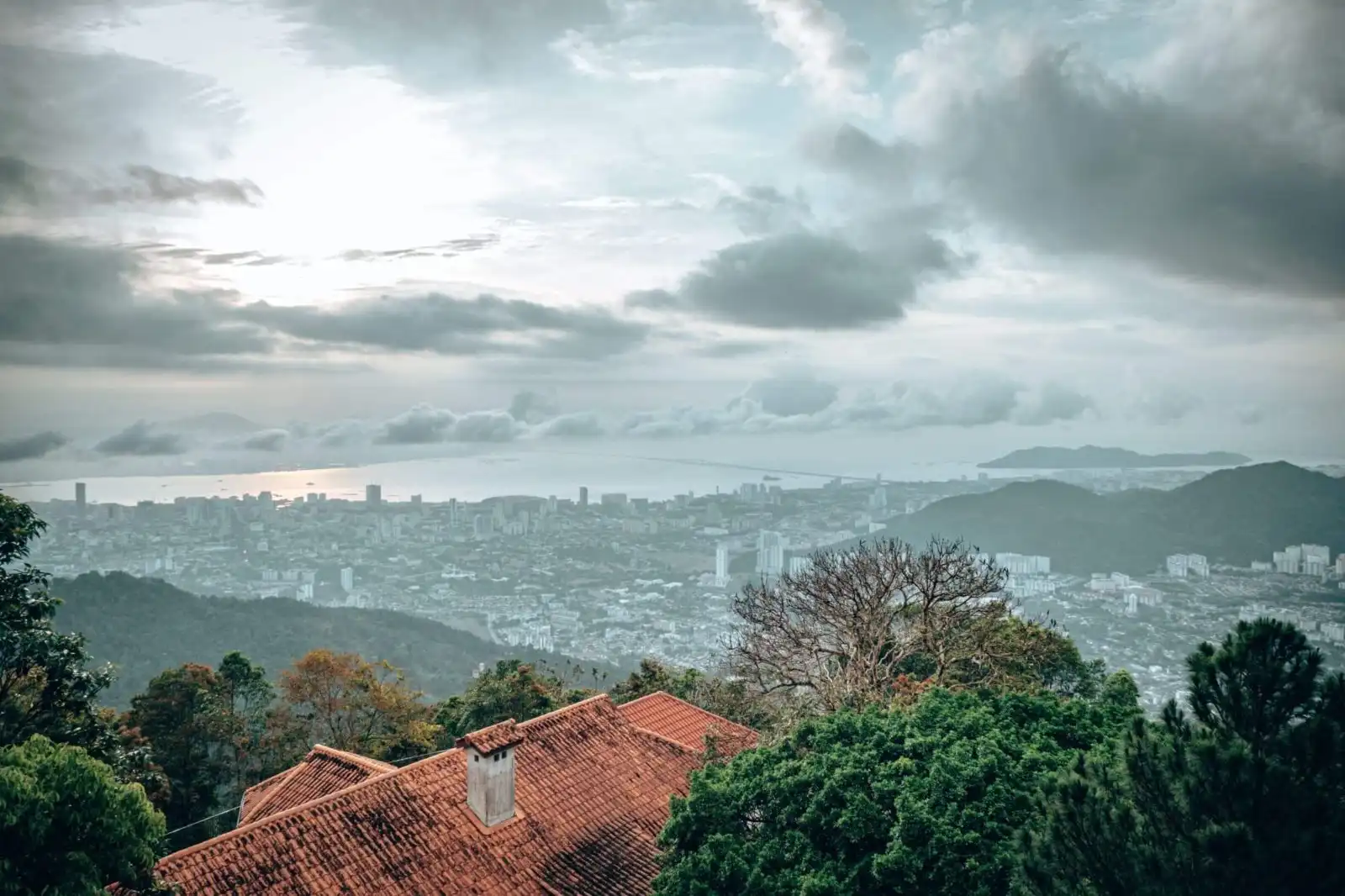
Meander around the museums
Now there are so many museums in George Town that it can be hard to choose! Some of our favourites include exploring the local Pernakan culture at the Pinang Pernakan museum, gorging yourself on caffeine and cocoa at the Chocolate and Coffee Museum, getting unusual photos at the Upside Down House or doing the #1 activity in all of George Town, a tour of the Blue Mansion aka Cheong Fatt Tze
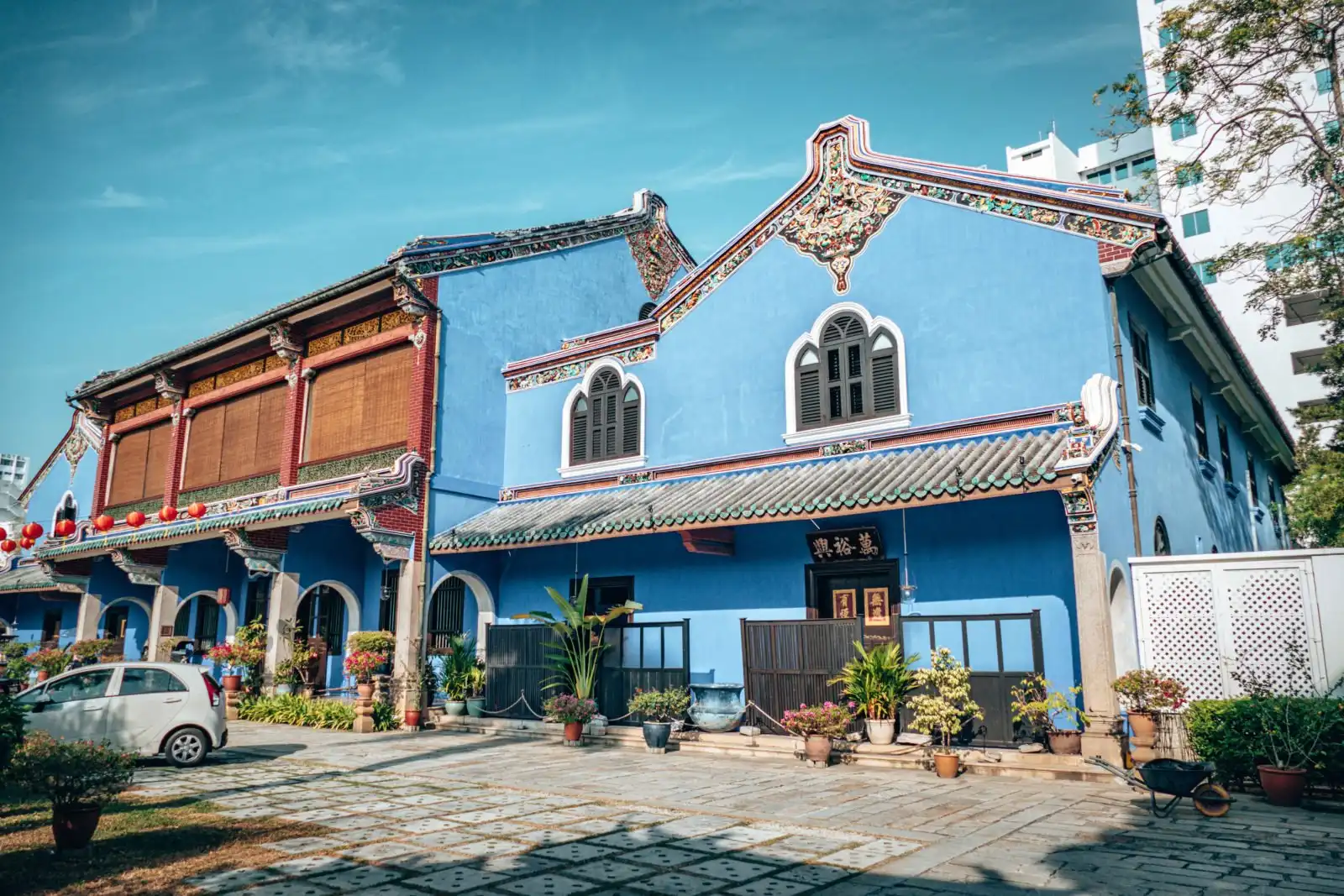
Day 13 – Penang to Langkawi
Now depending on your travel time to Langkawi (see below for options on how to get there), you should have some time to explore at least one attraction in Langkawi in the afternoon.
Take the Langkawi Skycab
Our suggestion for the afternoon is the cable car, known as the Langkawi Skycab. It’s in the record books as being the steepest cable car in the world and gives you brilliant views across all of Langkawi island from up top. However, the Skycab is more than just the cable car itself and one of the main drawcards is the Sky Bridge, a glass walkway right at the upper station where you can walk around to see even better landscapes, and take a photo or two.
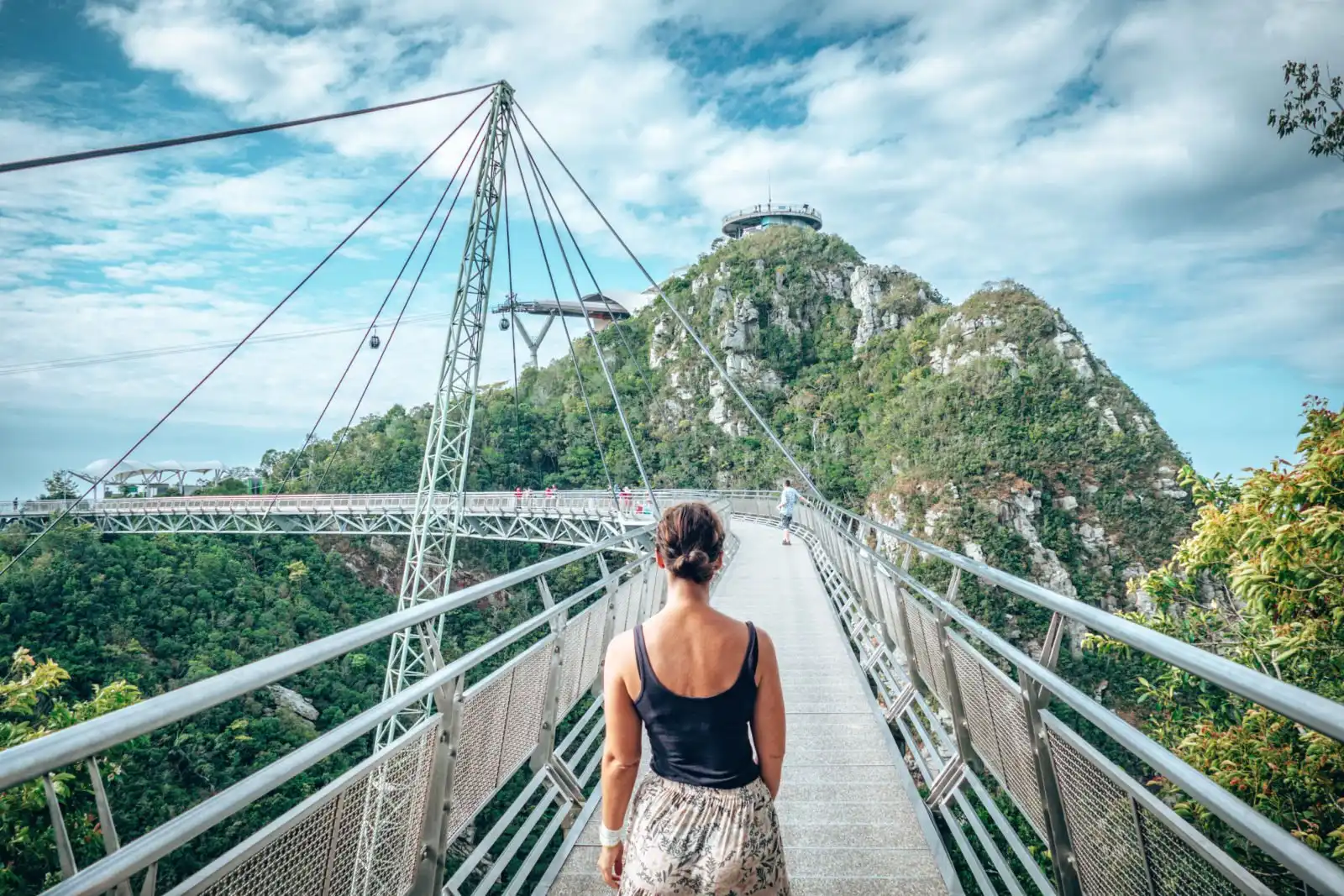
Insider Tip: Make sure you check their website beforehand, since the upper station is often closed due to high wind.
Where to stay in Langkawi
Budget: We’d recommend the Cenang Plaza Beach Hotel, right in the action of Pantai Cenang. Just over 150m to the beach, comfy rooms and a budget price makes this a great bargain pick!
Mid-range: The Smith House is a fantastic mid-range choice particularly if you are coming or leaving via air, since its conveniently located near the airport. It’s also near the Cable Car, has wonderful rooms, a lovely breakfast and we personally loved the rooftop swimming pool, which is great for getting some sun. Alternatively, Aloft is a wonderful choice that is on the edge of luxury – we stayed there for a few nights and give it top marks.
Luxury: Langkawi has a number of premium resorts and hotels, so you are spoiled for choice! We couldn’t decide which ones to recommend so will include three for you to check out: the Danna, Datai and Four Seasons.
Getting from Penang to Langkawi
Considering you’re hopping from island to island, there are only two ways to get between Penang and Langkawi: by sea or air.
Ferry: There is a direct ferry, operated by Langkawi Ferry Services (also known as Super Fast Ferry Ventures), that takes you around 3 hours. The morning ferry departs from the Penang Ferry Terminal (Swettenham Pier) at 8.30am in the morning, arriving into the Kuah Jetty point in Langkawi at 11.35am. There is also an afternoon ferry run by the same company, departing Penang at 2.0pm and arriving to the Langkawi jetty at 5.05pm.
Book your tickets here or check out the prices in the handy tool below!
To find out more, we’ve got a comprehensive guide on the Penang to Langkawi ferry here.
Plane: Taking only 40 minutes, there are about 5 flights per day from Penang to Langkawi (all in the afternoon).
For the cheapest options, check out this route on Skyscanner.
Day 14 – Langkawi
Relax on the beach
To be honest, the best thing to do on Langkawi if you have limited time is to spend time on sandy shores, checking out some of the top notch beaches on the island. Truly, you could dedicate at least 3-4 days exploring the many white sand beaches so it’s worth picking one for today and sticking with it!
The most popular is definitely Pantai Cenang, near the harbour and situated by the beachfront hotels (bonus: go eat the Mango Wango pancakes at our favourite café on the beach, Huggin Hippo!) Next to Cenang is the quieter Pantai Tengah or you can head up to one of the beaches near the top of the island, Tanjung Rhu or Sandy Skulls (Pasir Tengkorak).
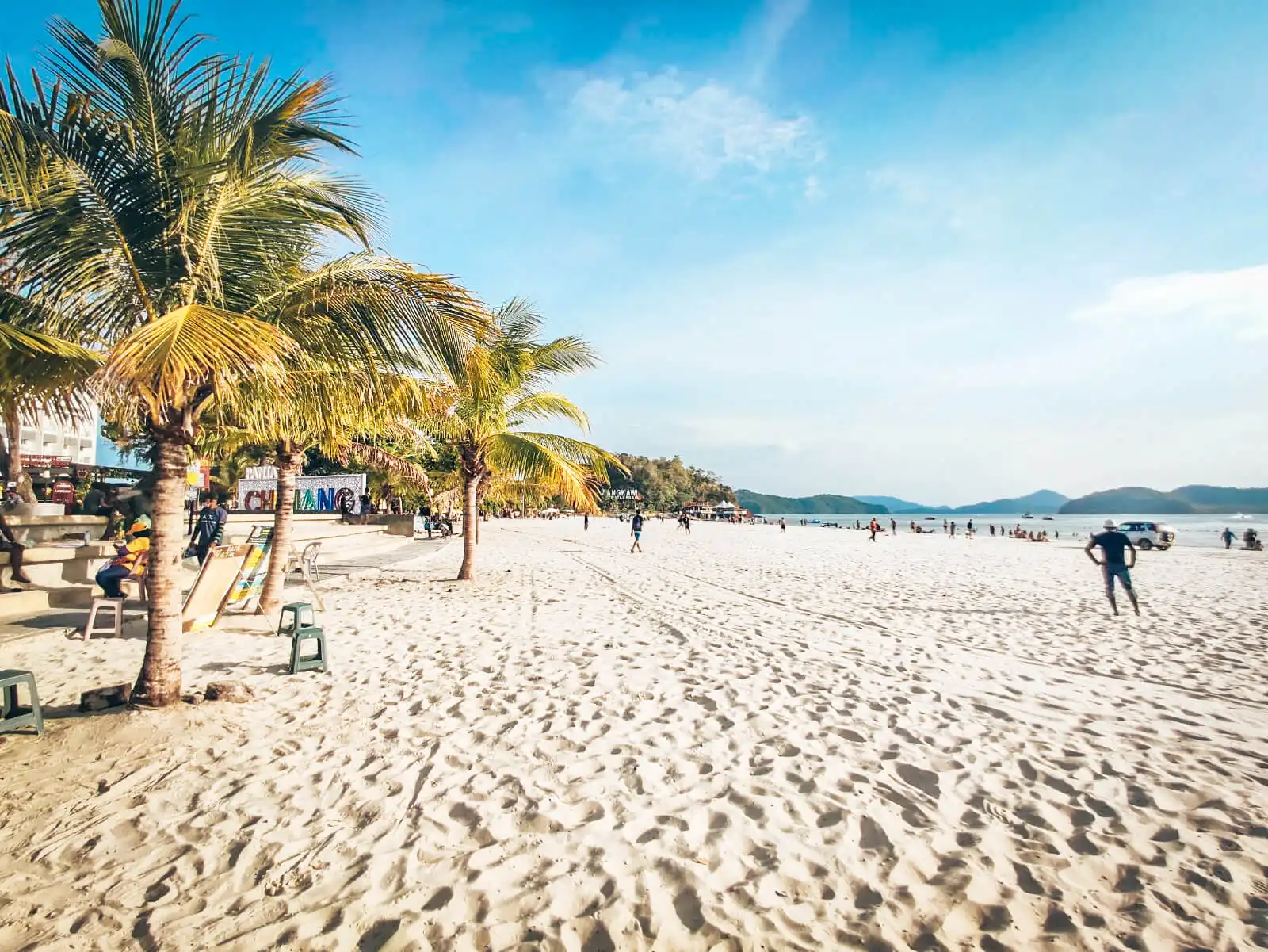
More things to do on Langkawi
Not keen on being a beach bum for the day? Here are a few ideas on other things to do in Langkawi:
Take a mangrove tour
Did you know that Langkawi is home to a large mangrove forest? See the mangroves up close and personal on a boat tour – these four hour trips showcase the flora of this biodome but also amazing wildlife including fish, birds and even dolphins! Check out the latest prices and tours here.
Try an adrenalin activity
Langkawi is a bit of hotspot for adventure pursuits – you’ll definitely notice parasailing taking place all over the ocean, you can rent a jetski to go and explore the ‘fjords’ (make sure to check out Pregnant Maiden, the largest lake in the area), or you can head over to the Langkawi Geopark to fly through some of the globe’s oldest rainforest area on a zipline (there are 12 of them in fact!). Check out the latest prices and tickets here.
Visit the Dataran Eagle
Built at Dataran Lang (Eagle Square), this 12 metre tall eagle is one of the most famous landmarks on Langkawi! It refers to the actual name of the island, as ‘helang’ translates as eagle with ‘kawi’ meaning reddish-brown. The eagle is located at Kuah Jetty which is a little out of the way, unless your ferry comes in (or departs) from that pier.
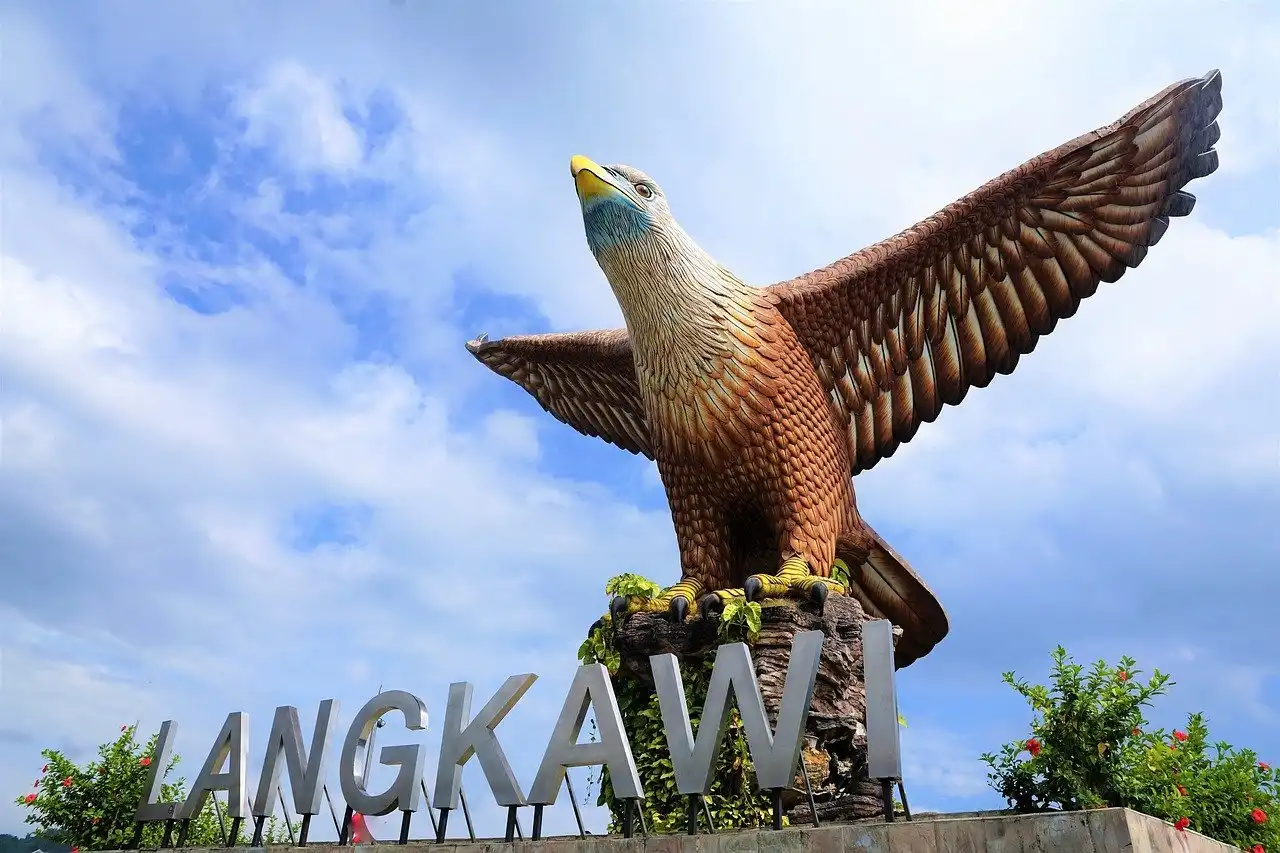
Walk to the waterfalls
If you’re on Langkawi in summer, of course the waterfalls are not that exciting. However, if you do experience a bit of rain then it might be worth heading out to one of the two larger waterfalls on the island. Seven Walls (Telaga Tujuh) is right near the Skycab (you can actually walk there), or get out to the slightly more impressive waterfall, Air Terjun Temuru, a three tiered, 200m drop waterfall located in Mat Cincang Nature Park.
Heading to Thailand? A little-known piece of travel logistics, but you can actually go directly into Thailand from Malaysia, by hopping on the ferry from Langkawi to the small Thai island of Koh Lipe! If you want to know more, check out our guide to taking the Langkawi to Koh Lipe ferry.
Interactive map for your Singapore Malaysia itinerary
Bonus locations to add to your Singapore Malaysia itinerary
Honestly we feel like we could spend months and months in Singapore and Malaysia and not have explored it all, never mind cram it all into this itinerary for you. So, with that in mind, here’s a rundown of the other cities and spots you might want to add to your own Malaysia and Singapore itinerary.
Cameron Highlands
Riding shotgun in a orange-tinted jeep up soaring hillsides and drinking sugary tea. Those are our memories of the Cameron Highlands, one of the coolest (no, really) places in Malaysia. The Cameron Highlands is a scenic hill station founded by a British colonialist, Sir William Cameron. The idea was to act like a refuge during the summer months, as the highlands offer cooler temperatures. If you love tea, then the Cameron Highlands is definitely for you, as you should include a visit to the renowned BOH tea plantation. But even if tea isn’t your jam (like the pun?), there is lots to do: walking in the Mossy forest, the many hiking trails, rose gardens and lots (and lots) of strawberry picking.
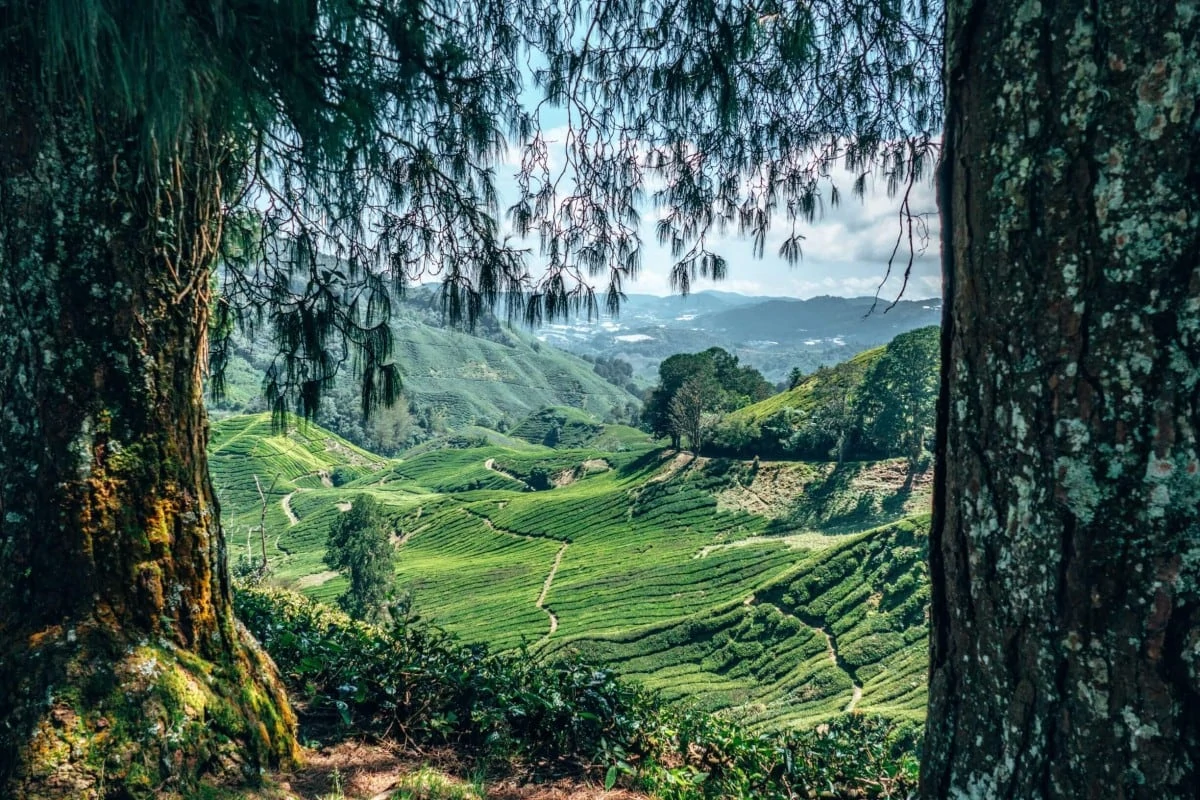
Tioman Island
It’s one of the more commercialized islands on the East coast of Malaysia, but Tioman is still a great place to visit. Perched in the South China Sea, Tioman is renowned for some of its diving sites, mainly for the brilliant corals but also the plethora of incredible shipwrecks! You can chill on the beach, head off into the rainforest to spot a monkey (or two) or go to the turtle hatchery to see how the island is protecting these salty sea turtles.
Perhentian Islands
Visions of crystal clear waters, pristine white sands and lolling palm trees? Those dreams can come true on the Perhentians, two exquisite islands made up of Kecil and Besar island. Meaning ‘stopping point’ the islands used to be where you would take a break on the journey between Bangkok and Malaysia, aimed at sailors and fishermen. Now tourism has overtaken fishing as the main source of income, and these picturesque islands offer visitors an escape from everyday life. Other than the stunning beaches, you can spend days snorkelling in the nearby corals, take out your kayak to explore the bays, hike in the jungles or just relax at your luxury resort.
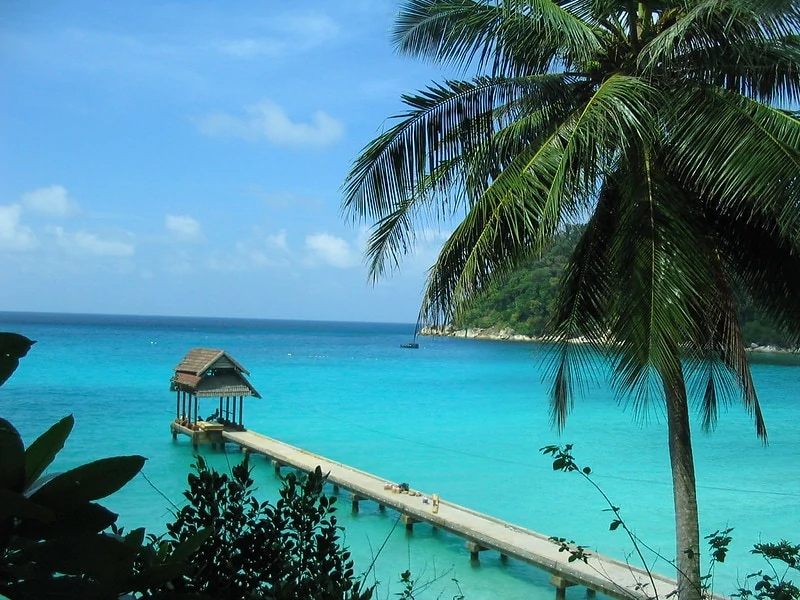
Johor Bahru
Affectionately known as ‘JB’ by residents, Johor Bahru is best known as the entry point into Malaysia from neighbouring Singapore as thousands of Malaysians live in the city yet commute daily into Singapore for work. It’s not the brightest star in the Malaysian tourism sky but JB can be a fun stopping point between Singapore and Kuala Lumpur, or even as your gateway to Tioman. The city has a few famous attractions including some temples, shopping malls, Hutan Bandar (Jungle in the City) and Danga Bay.
Borneo
So it’s technically one third Malaysian, Borneo, the third largest island in the world, is shared by Malaysia, Indonesia and Brunei. Borneo probably deserves more than just a cursory mention in this piece, and is a major destination in itself, so definitely worthwhile considering your own Borneo itinerary. You can see orangutans in East Sabah, climb Mount Kinabalu on Kota Kinabalu or scuba dive at Sipadan, considered one of the world’s most epic diving sites.
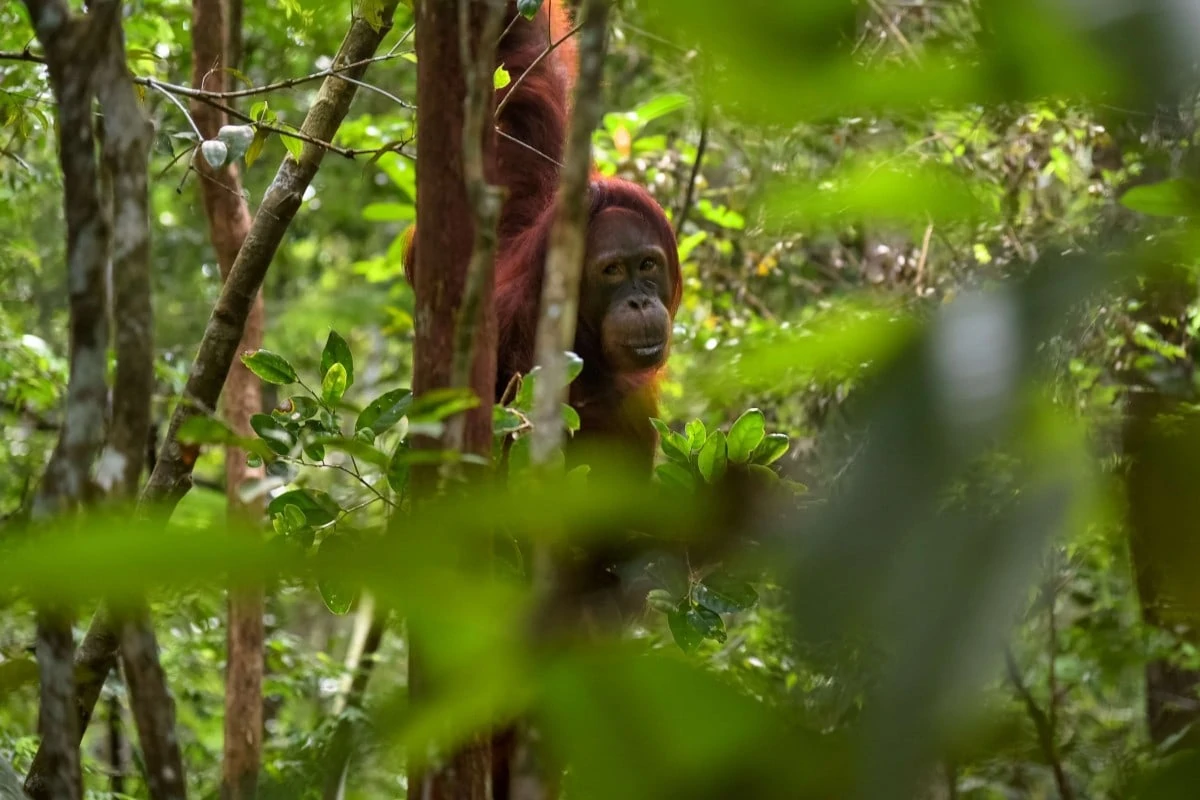
What is the best time of year to visit Singapore & Malaysia
Singapore
Now the best time to visit Singapore is during its dry season from February to August. However, it’s worth noting that from February to April are the driest out of these months, although you can’t rule out a heavy downpour even in the driest months. With Singapore being so near the equator, the weather is hot and humid all year round.
Malaysia
For the purpose of our Singapore Malaysia itinerary, we are focusing on the best time of year to visit the west coast of mainland Malaysia (there are very different seasons on the east coast and on Borneo). For this, the best time of year to visit would be from November to March, with January and February being particularly great weather from Melaka all the way through to Langkawi.
So overall, if you’re able to pick any month of the year to visit both, we would suggest February as being the ideal time!
What to pack for your Singapore Malaysia trip?
Now most of the year will be warm in Singapore and Malaysia, so light clothing is a must. But what else should you be stuffing into your luggage for the trip?
Here are our must-pack items for your Malaysia Singapore itinerary:
- Sunglasses and suntan cream – no matter the time of year, it’s worth covering up from the sun.
- Comfy shoes – either sneakers for all the walking you’ll be doing or even a sturdy pair of hiking sandals – we love our Teva’s
- Rainjacket – no matter the weather there is a chance of a shower in these two countries. Pack rain gear!
- Warm jumper or jacket – regardless of the heat, many restaurants, malls and especially ferries and busses are icy cold. Bring a warm fleece or top.
- Get yourself a good travel adapter, Malaysia and Singapore use the British style socket. We never leave home without this one.
- Our favourite piece of kit, the PacSafe, whether you’re in a hotel or hostel this portable safe gives you total peace of mind.
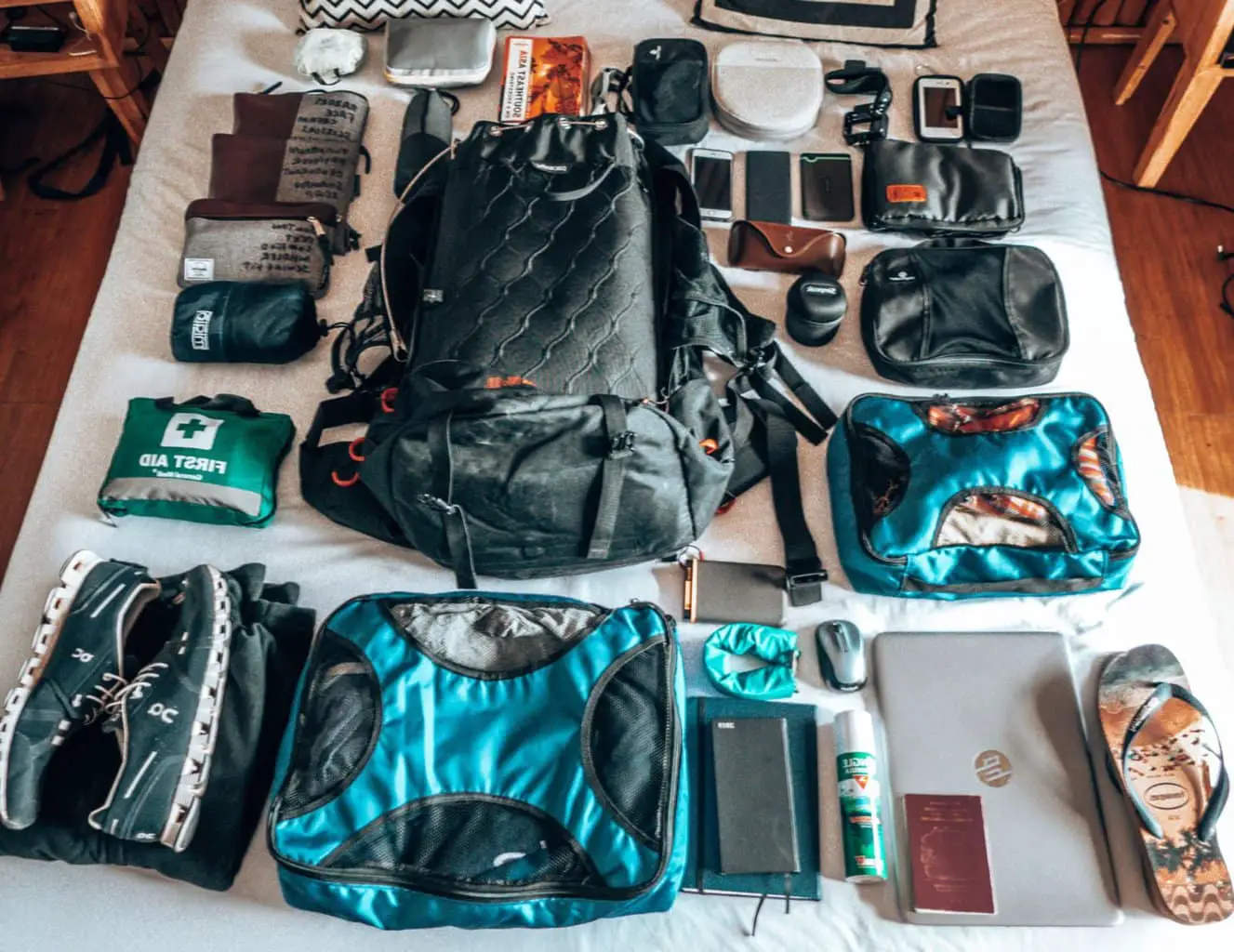
What camera equipment and other gear do we use?
We’re living proof that you don’t need the most expensive gear to travel the world and take good photos. Here are some of our must have items that make it into the packing list for all our travels.
- Main Camera: Panasonic Lumix FZ1000
- Drone: DJI Mavic Air – Fly More Combo
- GoPro: Hero 7 Black
- GoPro Dive Case: Go Pro Housing
- GoPro Case: Smatree GoPro Carry Case – Small
- Packing Cubes: Eagle Creek Packing case
- Backpack: Osprey Farpoint 70
- Powerbank: Anker Powercore
- Phone: Xiaomi Mi 9
- Hard drive: Transcend Slim Storejet 2TB
- Laptop: Lenovo IdeaPad 720s
- Headphones: Bose Quiet Comfort 35
- Wifi Hotspot: GlocalMe G4
So, what did you think of our Singapore Malaysia tour itinerary? Let us know in the comments!
Frequently Asked Questions – Singapore to Malaysia itinerary
What is the best itinerary for one week in Singapore and Malaysia?
In this case we’d probably recommend 2 days in Singapore, 2 days in Kuala Lumpur and 2 days in Melaka/ Malacca, or swapping Melaka for a trip out to Ipoh.
What is a suggested 7 day itinerary for a trip to Malaysia?
This depends on the time of year. From November to March, it’s recommended to include Kuala Lumpur, Melaka, Ipoh and perhaps Penang or Langkawi. For other parts of the year you could fly into Kuala Lumpur but make your way to East Coast including Tioman, the Perhentian Islands or even over to Borneo.
What is the better option: Singapore and Malaysia or Singapore and Bali / Indonesia?
Personally, we’d choose Malaysia. While we prefer Malaysia for its melting pot of cultures, food and attractions its also far more convenient to travel into Malaysia from Singapore.
Want to save this for later? Then why not pin it…
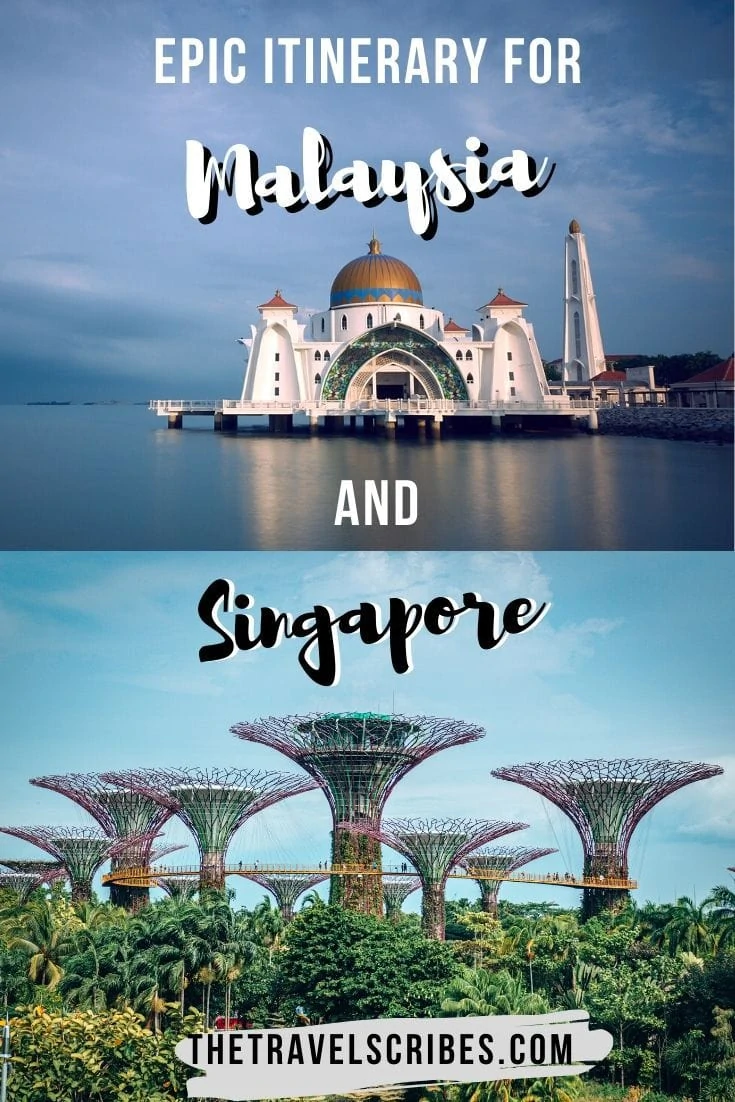

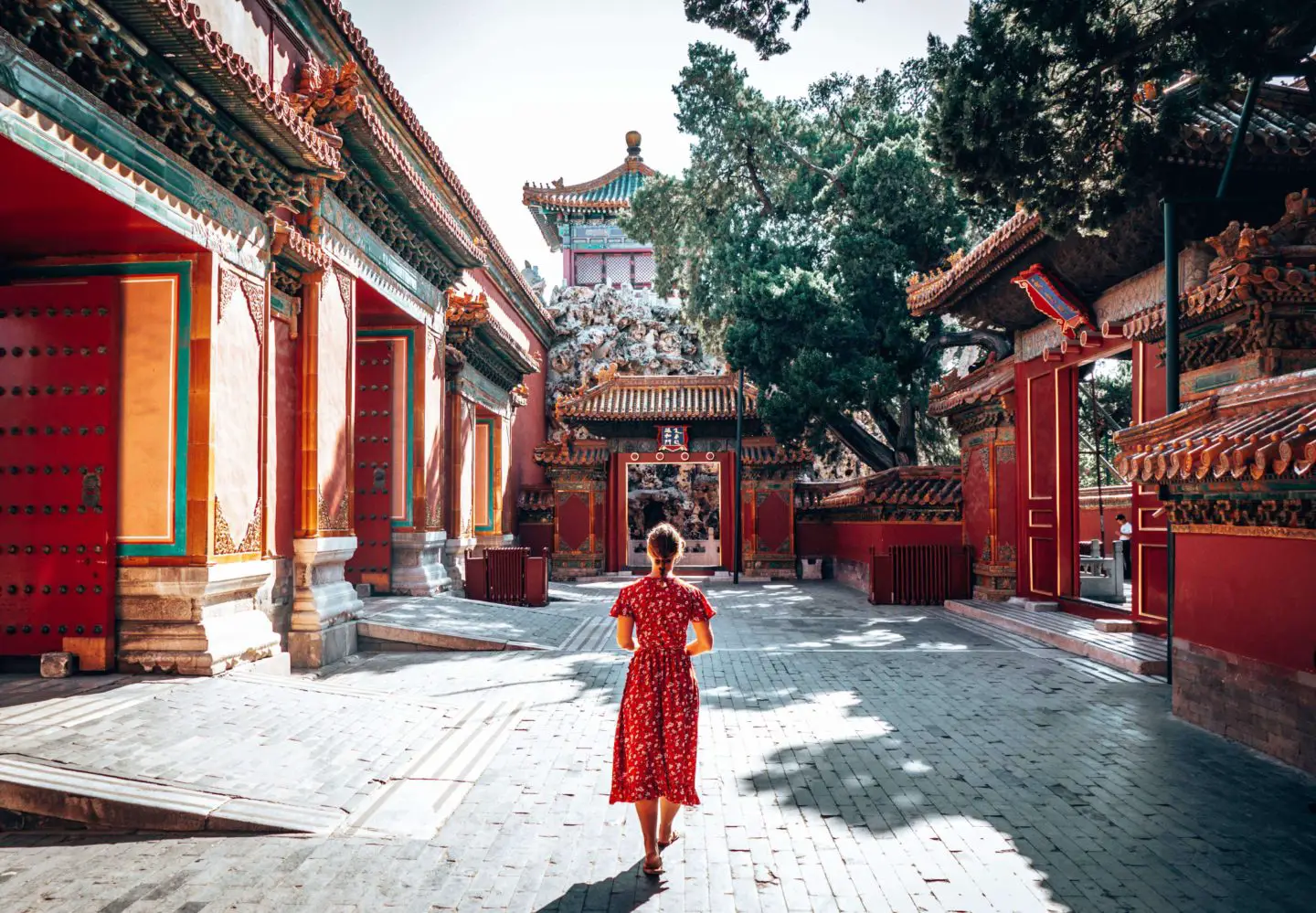
Thank you for adding us to your lovely and informative article. Much appreciated.